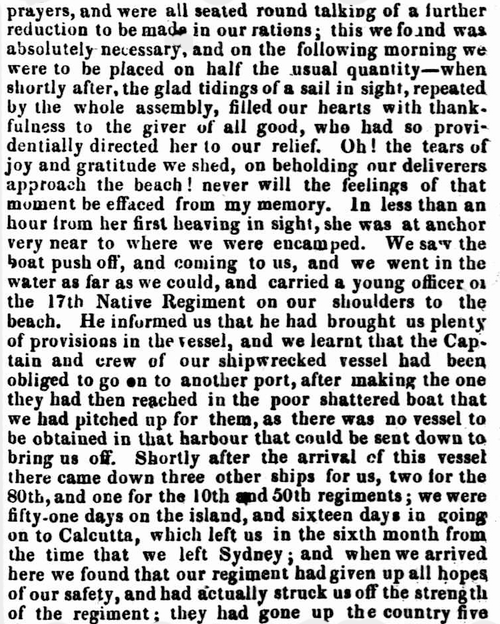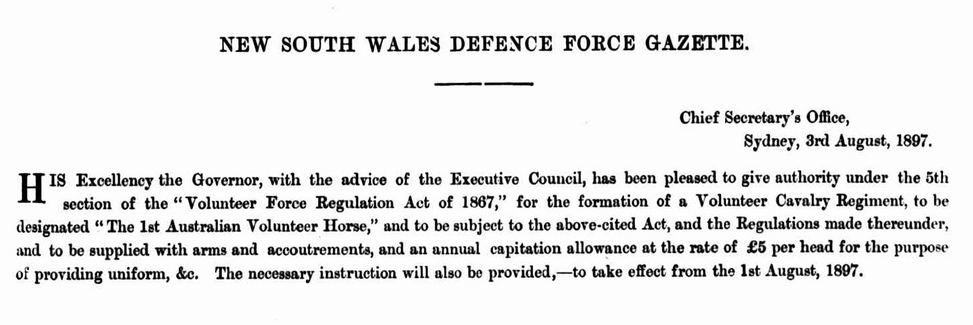Table of Contents
These units are list alphabetically, then numerically, rather than by era, as these overlapped.
Some of the following has been found in Trove, and various historical and/or museum websites. Another reference is Ronald Montague’s book, “Dress & Insignia of the British Army in Australia & New Zealand 1770-1870”.
British
Note that from 1900 there have been reproductions of older designs made for collectors and reenactment groups; they may have plain backs or be marked “special made”. However, they may have the original historical back, indeed, some were apparently made by the original firms! Perhaps it does not matter.
Army Medical Staff Corps
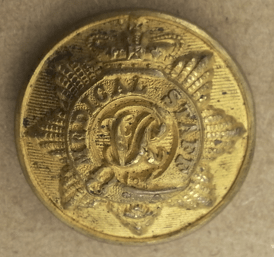
Hobson & Sons Lexington St. London W. According to Cossum c.1855, however the backmark dates from 1887.
This button, with Queen Victoria’s cypher and crown, is from the British Army. From 1810-1855 there existed an Army Medical Department. In 1855 a Medical Staff Corps was established, only to be renamed Army Hospital Corps in 1857 then re-re named the Medical Staff Corps in 1884. Until 1870 the various British troops in Australian were cared for by regimental surgeons and colonial surgeons. The first regular Australian Army surgeon was Dr W. J. Bedford, appointed in 1871. The above button, possibly not worn in Australia, dates from 1887.
http://australianmilitarymedicalcollective.weebly.com/army-medical.html
The Port Macquarie Museum has a fine example of Royal Army Medical Staff quoted as a c.1830 dress jacket worn in Australia. The buttons have a William IV cypher but a similar design to above. See https://ehive.com/collections/3977/port-macquarie-museum

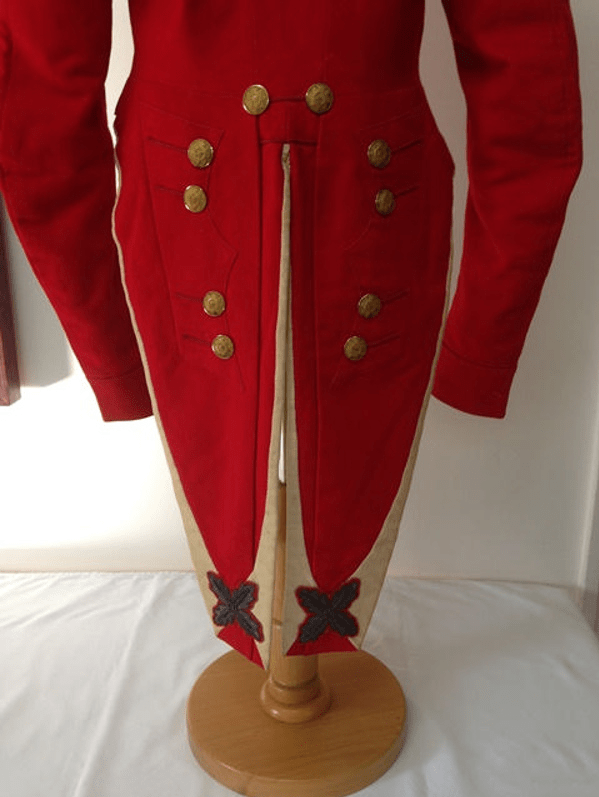
See http://www.austbuttonhistory.com/23rd-october-2021/
New South Wales Marines
1786-1792
The first troops sent to Australia were the New South Wales Marines, established in England as a volunteer unit of the British Royal Navy in 1786. They guarded the convicts on the First Fleet from May 1787 to January 1788 then provided law and order enforcement as well as defence at Port Jackson and Norfolk Island. Inducements to volunteer included a 2 guinea payment and the option of discharge after 3 years duty in the colony. Some histories describe them as honorable and hard working, who along with the convicts suffered hardship and privation. However, a Wikipedia entry claims “The marines had a habit of getting drunk and not guarding the convicts properly, whilst their commander, Major Robert Ross drove (Captain Arthur) Phillip to despair with his arrogant and lazy attitude.” Those marines not choosing to stay returned to England where the unit was disbanded.
Small detachments served at varying times right up until 1870.
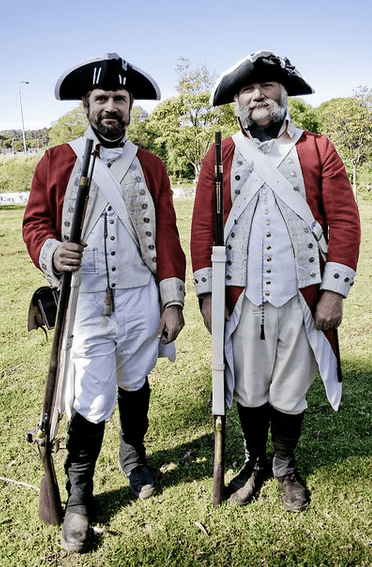
Image thanks to Vanessa Pike Russell https://www.flickr.com/photos/25056484@N00/1240349386
Their uniform consisted of red, long-tailed doublet with white trousers, black head-dress, shoes and garters. The buttons were standard “Fouled Anchor” of the Marines. Unfortunately, Marine buttons have been varied both over time and between manufacturers.
1770-1791: Officers
Officers’ buttons were gilt before 1769 and silver afterwards. Officers’ hats sported a black leather cockade (According to Wikipedia: A cockade is a knot of ribbons, or other circular- or oval-shaped symbol of distinctive colours which is usually worn on a hat or cap) fastened by a button bearing an anchor motif. The coat had two button on the collar, four on the cuffs and usually ten on each lapel. There were also two non-functional decorative pockets with four buttons each. The waist coat usually had another 10 buttons. The breeches were fastened below the knees with a button and buckle.
Other Ranks (O.R.) wore pewter buttons decorated with an anchor motif.
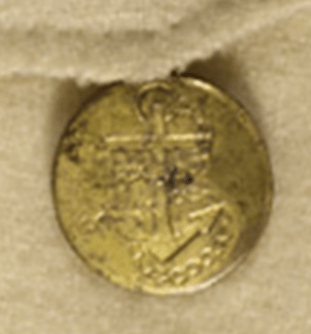
From the Royal Museums Greenwich collection. Fouled Anchor button on 1774 uniform. Officers’ buttons changed from gilt to silver in 1855. According to R. Montague, this design was current in 1879 on OR buttons in pewter.
According to Ronald Montague: the design on the left was for Officers’ buttons; after 1802 also inscribed with ‘Royal Marines’. The rightward button was for Other Ranks.
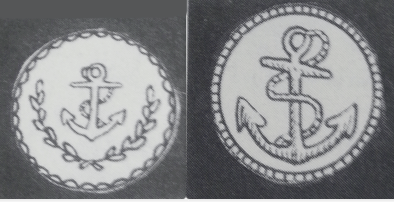

From the Royal Museums Greenwich collection. This is a button on a uniform dating from November 1787. The NSW Marine Corps had already sailed, so would have received this button. New uniforms would take up to 12 months to be distributed within Britain, and up to 2 years for overseas detachments.
From 1802 the Marine became the Royal Marines Corps with some changes to the uniform, with further changes in 1823 and 1856.
https://en.wikipedia.org/wiki/New_South_Wales_Marine_Corps
https://en.wikipedia.org/wiki/First_Fleet
https://guides.slv.vic.gov.au/colonialforces/imperialforces
https://collections.rmg.co.uk/collections/objects/71227.html
New South Wales Corps
1789-1809
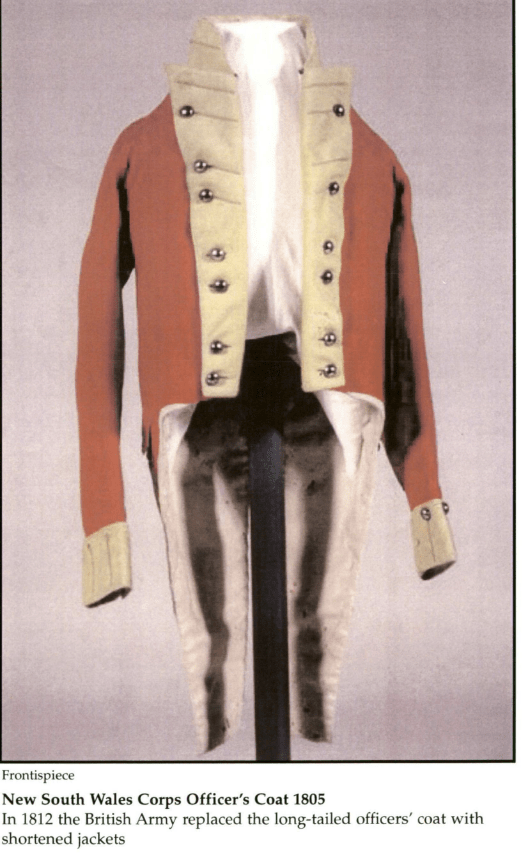
From a thesis by John Farquhar McMahon available from the Tasmanian Museum and Art Gallery #S1978.28. The detail is not clear as to whether the button faces were plain or not.
The New South Wales Corps (now, but not at the time, also known as the Rum Corps) was formed in England in 1789 as three companies, and relieved the New South Wales Marines over the period of 1790-1792. The quality of the men was patchy as this was an unpopular posting. A fourth company was formed from Marines choosing to remain in the colony. The Regiment was stationed in New South Wales until 1810. They were lead by Major Francis Grose, who had arrived in 1792 to relieve Captain Phillip as Lieutenant-Governor of the colony.
Grose introduced military rule and made changes to favour officers of the Corps, including land grants and rum trading. The misuse of power and wealth that resulted is infamous, including the Rum Rebellion against Governor Bligh, and was not brought under control until Lachlan Macquarie became Governor on 1810. However, they had been effective in controlling the rebelling convicts of the 1804 battle of Vinegar Hill.
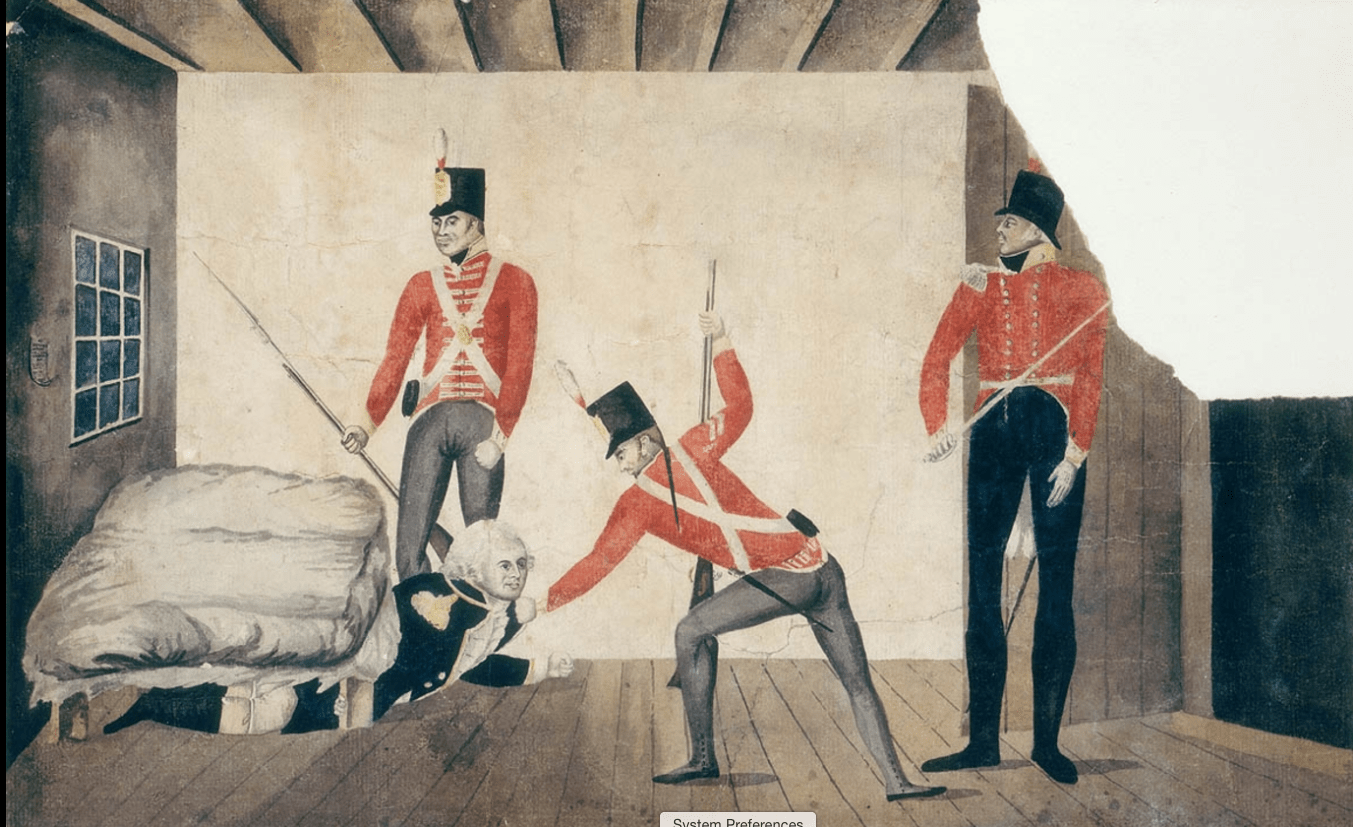
1808 cartoon of the arrest of Bligh by members of the Rum Corps.
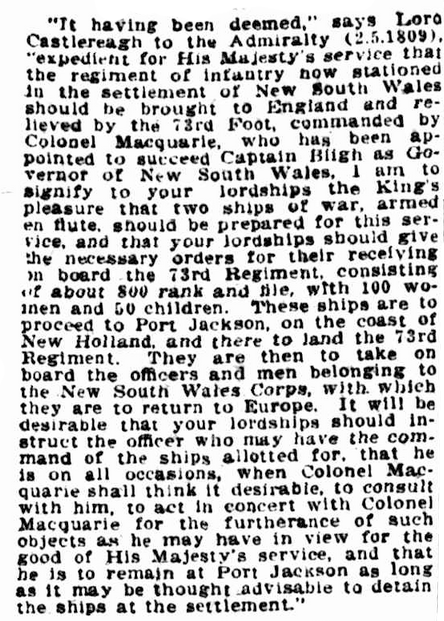
Truth (Brisbane), 4th July 1909 page 11. From an article about “Old Sydney”.
The initial uniform was based on that of the marines, with different colour facings (yellow) and differing buttons and shoulder plates.The officers’ buttons were silver and O.R. pewter. The design is uncertain, but officers’ may have been embossed with Corps initals or the Royal Cypher. Over time, the jacket was shortened, and the head-dress changed to the shako.
Late in In 1808, due to their involvement in the Rum rebellion, they were renamed the 102nd Regiment of Foot, and the bulk of the troops recalled to England. Some remained, absorbed into Macquarie’s 73rd Regiment, and some were formed into a veteran and invalids troop. Some retired officers remained as farmers in New South Wales.
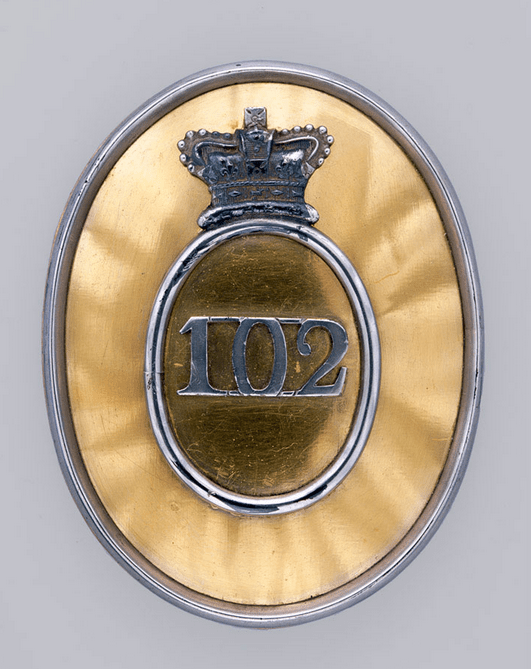
An officer’s shoulder plate. As the designation “102nd” only dates from late 1808, these date from after the regiment returned home and before the redesignation as the 100th Regiment in 1816. Courtesy Royal Army Museum https://collection.nam.ac.uk/detail.php?q=searchType%3Dsimple%26resultsDisplay%3Dlist%26simpleText%3DNew%2Bsouth%2Bwales&pos=4&total=19&page=1&acc=1979-02-87-1
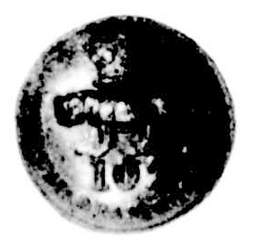
The Queenslander, 6th October 1932 page 20. Presumably this button was worn after the return from Australia.

Miniature in the State Library of NSW collection: Officer of the NSW Corps, William Cox. Note the apparently plain buttons.
William Lincoln (from a British reproduction uniforms manufacturing firm) kindly shared knowledge and these diagrams with me (original source unknown). They are pewter buttons dug up in Tasmania including plain examples and those marked for the 73rd Regiment of Foot who were stationed there from 1810-1814.
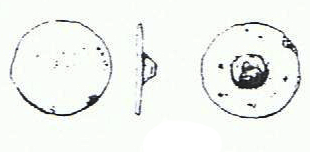
“Brass cone shank button. A flat undecorated disk, 17mm diameter, 1mm thick, with the remains of a copper wire shank soldered in place of a central boss.”
Referring to the photo of the coatee above: According to authoress Gwen Squires before 1809 officers’ buttons were flat one piece, but the style changed becoming more convex. Eventually this required the back of the button to be filled. After 1830 silver was changed to gilt for uniform lace and buttons. ‘Other ranks’ buttons were made of lead or pewter until 1855, then brass was used. The New South Wales Corps existed from 1789-1808, after which the Corps, were reformed as the 102nd Regiment of Foot and returned to Britain. It would be expected from this dating that flat silvered buttons on the would have been used on the officers coatees* at first, and more convex buttons later on. If the buttons in the above portrait are original (this is not always the case with historical uniforms) then the buttons on this uniform date later in the corps existence as they appear convex.
https://en.wikipedia.org/wiki/New_South_Wales_Corps
https://en.wikipedia.org/wiki/Rum_Rebellion
New South Wales Veterans/Royal Veterans.

Veteran, from http://www.diggerhistory.info/pages-conflicts-periods/other/before-waterloo.htm
Men who were considered unfit for active service, but fit for garrison duties had been formed into Invalids companies since the 17th century. From 1802 they were named Royal Veteran Battalions. The first formed in Australia, in 1811, consisted men of the 102nd (formerly NSW Corps) who had served in New South Wales for up to 30 years. Some had married locally and had received land grants. This company was dispersed in 1823.
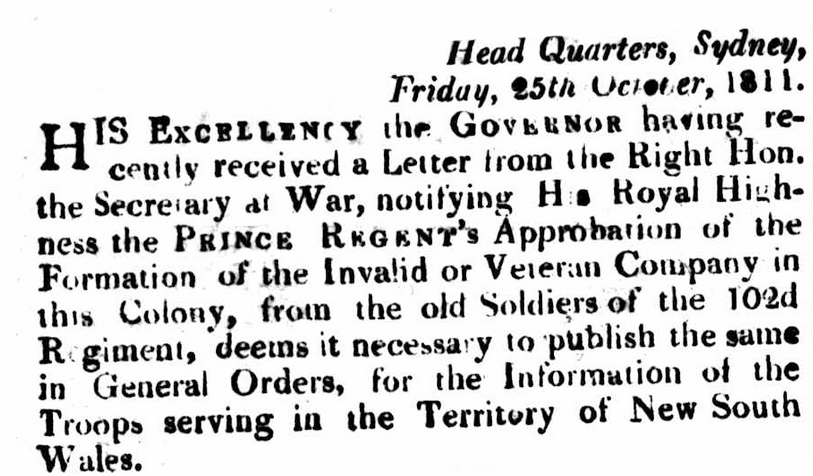
The Sydney Gazette and New South Wales Advertiser, 26th October 1811 page 2.
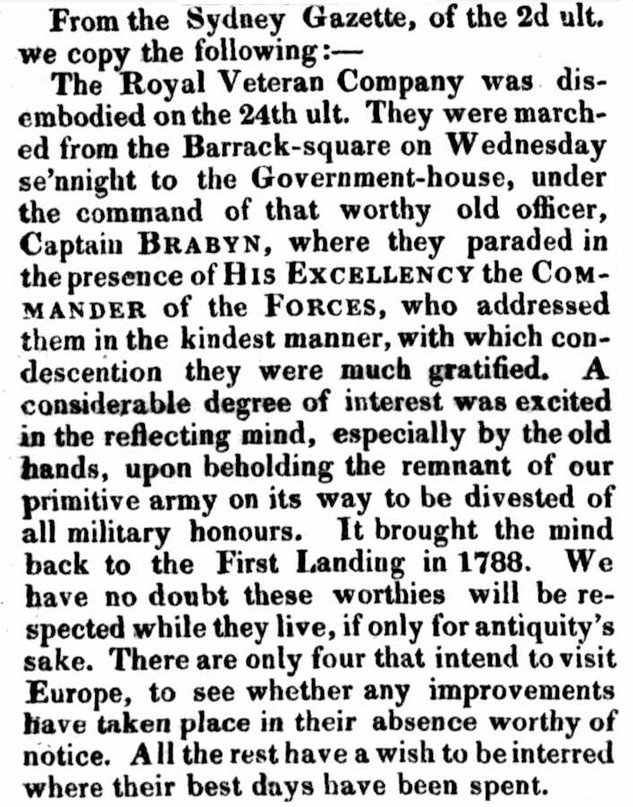
Hobart Town Gazette and Van Diemen’s Land Advertiser, 1st November 1823 page 2.
Detachments were sent during 1826- 1833 to serve in roles such as mounted police and convict overseers in NSW and Tasmania. After 2 years service, they were allowed to settle and take up a land grant.
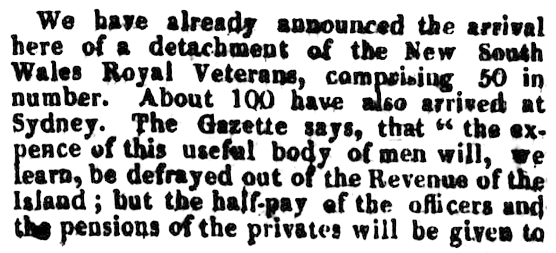
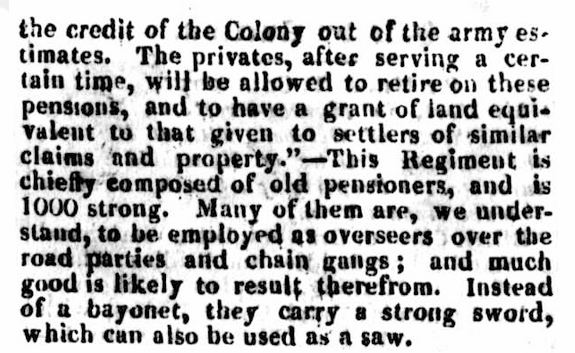 Colonial Times and Tasmanian Advertiser (Hobart), 29th September 1826 page 3.
Colonial Times and Tasmanian Advertiser (Hobart), 29th September 1826 page 3.
Ron Montague describes the uniform button as a garter inscribed ‘Royal Veterans Bttn’. Officers’ were gilt; O.R. pewter. Other Veteran Crops have a number corresponding to the specific Veteran corps.
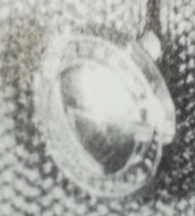
I have borrowed this from the book as I have found no other image.
(Corps of) Royal Engineers
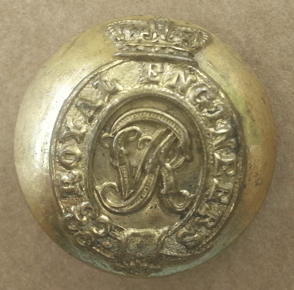
Backmark “Smith & Wright Birmingham” which dates 1861-1888.
Officers were stationed in the colonies from 1835, and other ranks from 1857, until the withdrawal of British regiments in 1870.
https://www.nam.ac.uk/explore/corps-royal-engineers
http://www.austbuttonhistory.com/18th-june-2022/
Royal Regiment of Artillery
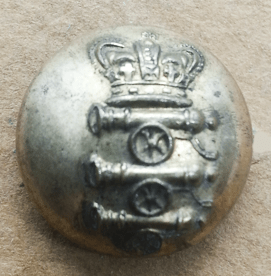
Artillery Forces trace back into the 16th century, with the designation of Royal Artillery starting in 1720. Various Battalions served in Australia from 1843 until the British regiments left in 1870. They also served in New Zealand during the Maori/Land Wars from 1846.
Early buttons were gilt for officers and pewter for Other Ranks. From 1831 the button design changed to that of 3 stacked field guns (cannons) surmounted by a crown, staying the same until after the Royal Artillery left out shores.
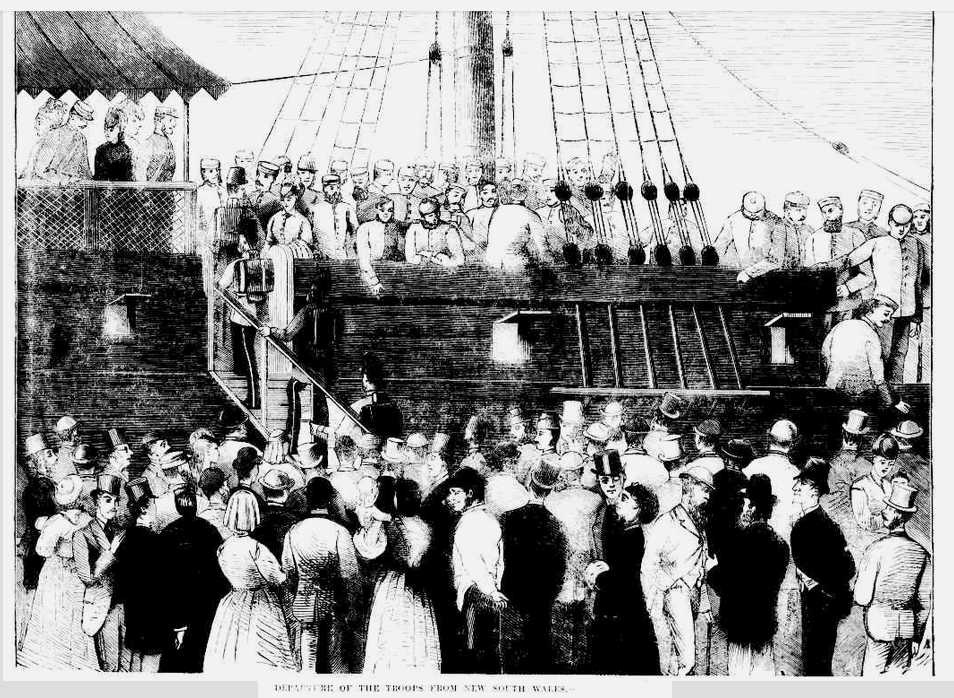
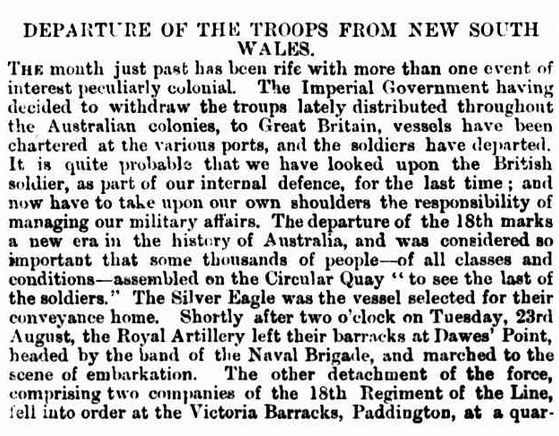
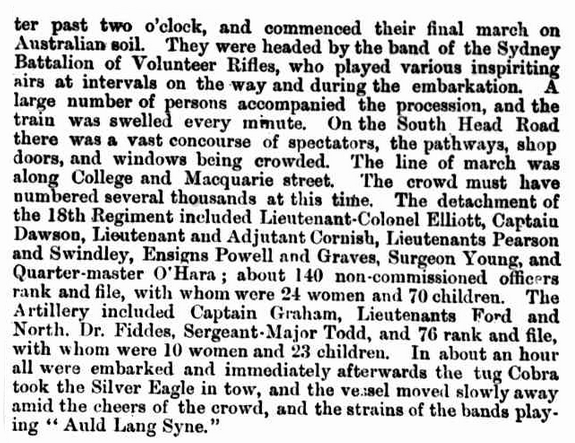
Illustrated Sydney News, 6th September 1870 page 3.
(Corps of) Royal Sappers and Miners
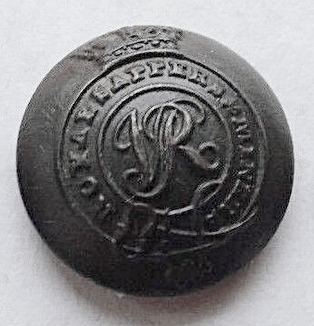
For sale on Ebay: 1854 Royal Sappers & Miners Button, found at site of Crimean British war camp.
Serving in Australia from 1835, Sappers and Miners performed duties including building and demolition for military purposes. The Corps served under officers of the Royal Engineers. In 1856 they were amalgamated with the Royal Engineers.
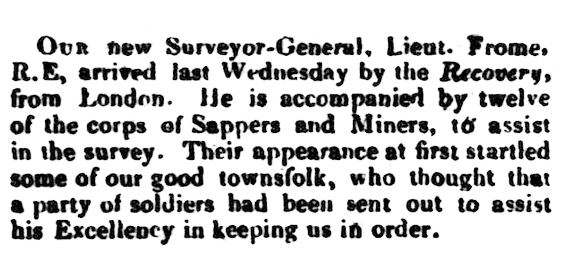
Southern Australian (Adelaide), 25th September 1839 page 3.
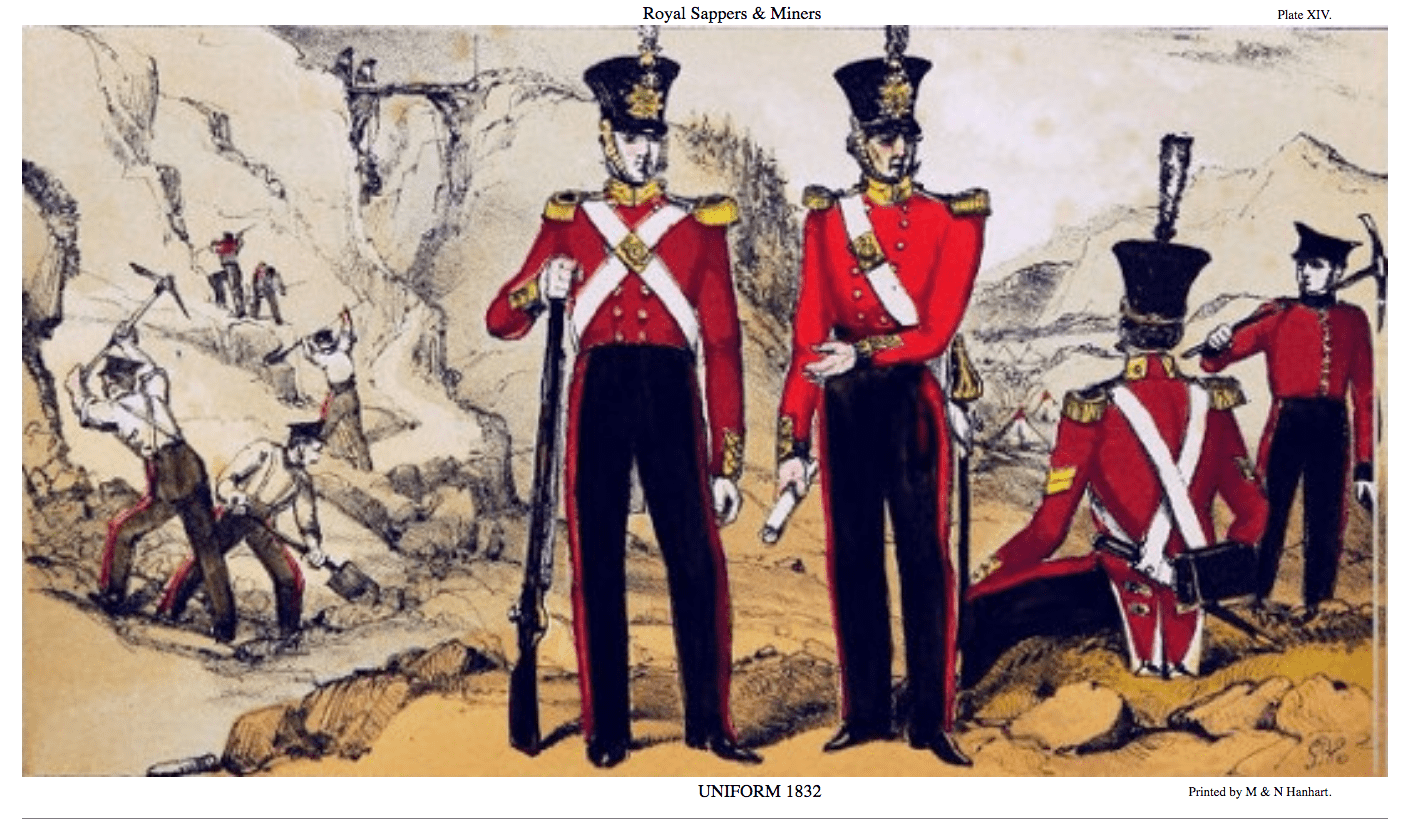
From the ebook reprinting of an historical volume: https://www.gutenberg.org/files/55776/55776-h/55776-h.htm#plateXIV ” (In 1832) A material alteration was made in the clothing this year by changing the colour of the coatee from scarlet to the infantry red, and the style and decoration of the dress were also modified, to correspond with the form of lacing adopted generally in the line. The coatee of the bugle-major remained in all respects the same as before. The buglers also retained the scarlet, but the style of wearing the lace accorded with that of the privates. For the working dress, a round jacket with bell buttons bearing the corps device, was established, instead of the jacket with short skirts. Of both uniform and working trousers, the colour was changed from light blue to dark Oxford mixture; but the uniform trousers as formerly, were much finer than the working ones. The red stripe down the outer seam was two inches broad on the former, and half an inch wide on the latter. Laced boots were also introduced this year in place of the short Wellingtons, issued for the first time in 1825. The leather stock hitherto supplied by the public, was now made an article of necessaries and provided at the cost of the soldier.” … (In 1837) This year the colour of the coatee was changed from red to scarlet—Plate XV., and the huge Kilmarnock woven cap was superseded by a neat superfine blue cloth cap, stiffened, with peak and chin-strap. The sergeants were distinguished by black oak-leaf bands and gilt ornaments, comprising a grenade, encircled by a laurel wreath, and surmounted by a crown and three chevrons. The other non-commissioned officers wore chevrons according to their ranks. The oil-skin chaco of the staff-sergeants was put aside for a forage-cap, with a gold oak-leaf band and gilt ornaments of a crown within a laurel-leaf.”
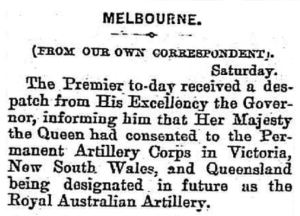
Geelong Advertiser (Vic), 21st August 1899 page 1.Each colonial artillery then became, for example , the Queensland Regiment of the RAA.
Royal Staff Corps
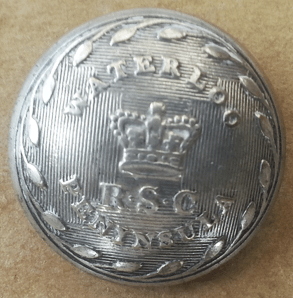
Pre 1829 coatee button. Backmark: Charles Jennens London POW plume. Despite the oft quoted date of this back mark as being from 1860 onwards, this button dates circa 1823-1833. According to Ronald Montague, this button was made of gunmetal (a grey corrosion-resistant form of bronze containing zinc).
These served in Van Diemen’s Land and New South Wales between 1823 until 1829. According to the 1829 Tasmanian Almanack, one officer and 20 privates serving in the colony. They were responsible for military engineering. When disbanded in 1833, many personnel transferred to the Sappers or the Engineers.

Hobart Town Gazette and Van Diemen’s Land Advertiser, 29th July 1825 page 3. An artificer would have been an expert in mechanical devices. They became the Royal sappers and Miners in 1812.
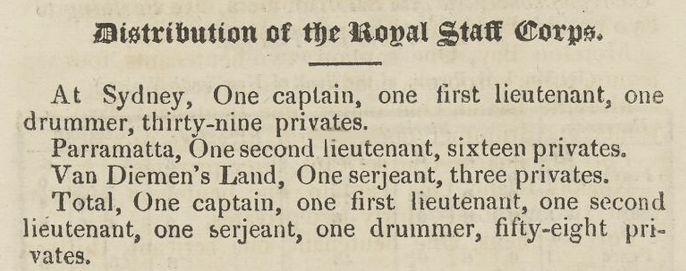
Australian almanack : for the year of Our Lord 1829, page 183.
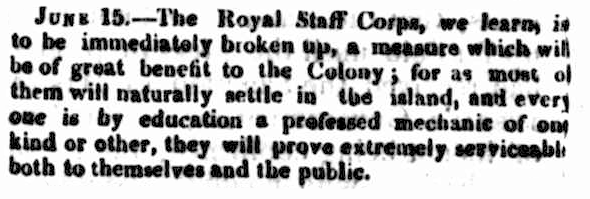
The Sydney Gazette and New South Wales Advertiser, 20th August 1829, page 2.
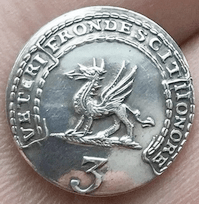
From Pintrest: According to Gwen Squires, the design dates from 1800-1830.
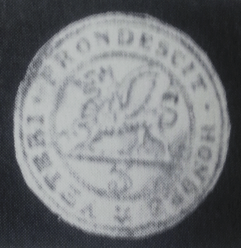
Montague claims this design (with the border right around the circumference) dates from the period in Australia, but Squires dates it as 1830-55.
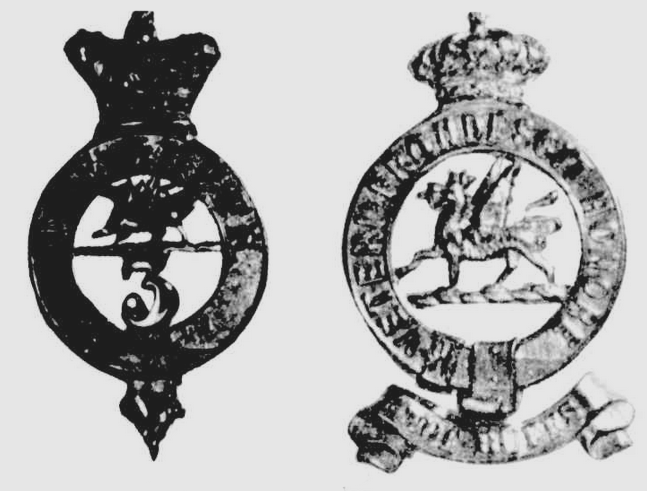
The Queenslander, September 29th 1932 page 27. Two badges of the 3rd Foot.

The Queenslander, 6th October 1932 page 20.
This regiment left for Australia in 1821 guarding convicts (although it is quoted differently in many sources, including Cossum) and left for India in 1827.
See https://www.nam.ac.uk/explore/buffs-royal-east-kent-regiment
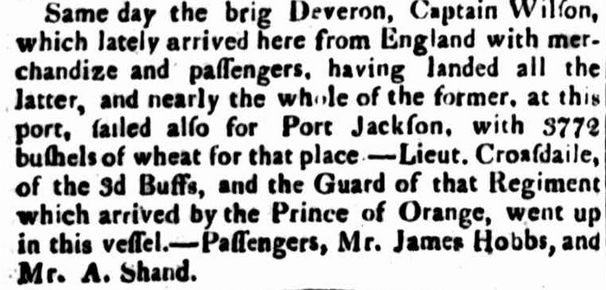
Hobart Town and Van Diemen’s Land Advertiser, 10th August 1822 page 2. The earliest Newspaper reference to the East Kents in Australia. They are referred to as the Buffs, although that name dates from 1708-1782.
Some of the button designs had the dragon facing sinister (left), some dexter (right). Most don’t have a drooping tail like the one above. See Cossum page 64. From 1881 the designation changed to The Buffs (East Kent) Regiment. Early buttons were silver for officers and pewter for O.R.
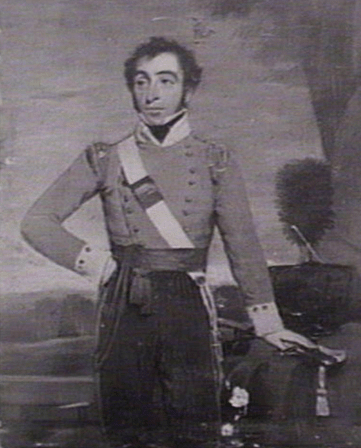
Colonel William Stewart from a 1822 oil painting held in the Mitchell Library, NSW. He commanded the Buffs in Australia and was also the Lieutenant Governor of New South Wales 1825-7. He returned from India in 1832 and retired near Bathurst.

The Telegraph (Brisbane), 19th May 1933 page 14 . Officers in 1823 in Winter Undress uniform.
4th Regiment of Foot (
This design may have been worn in Australia. See also
http://www.austbuttonhistory.com/uncategorized/20th-october-2020/
http://www.austbuttonhistory.com/uncategorized/20th-june-2021/
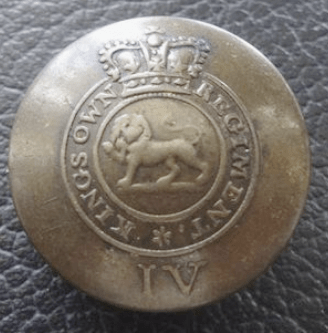
Both images from PIntrest: This was the version worn in Australia.
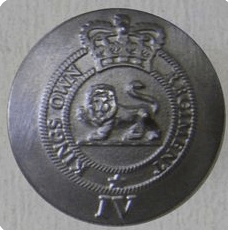
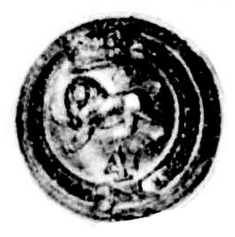
The Queenslander, 6th October 1932 page 20.
The first detachment of the 4th arrived in December 1831 as guards for a shipment of convicts. They left for India during 1836-7. Officers’ button were silver (despite being a “gold lace” regiment, which usually was matched with gilt buttons), other ranks were pewter. As with many regiments assigned to the tough conditions of the colonies (climate, boredom, rum, deprivation), there were intermittent problems with discipline.
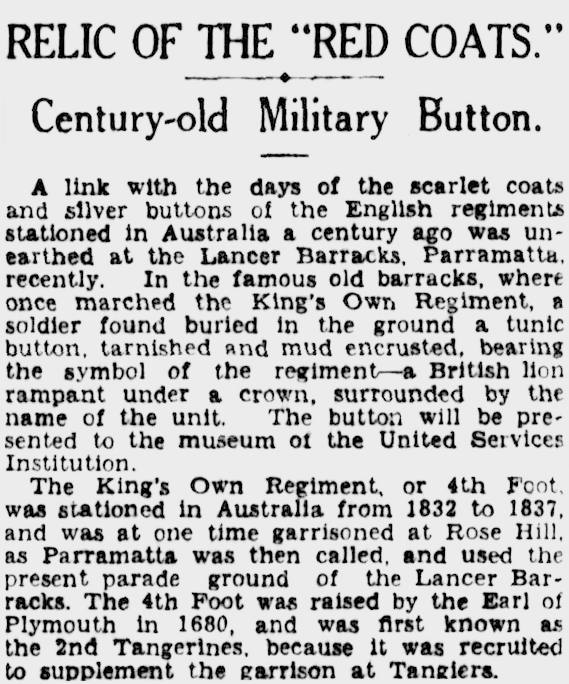
The Sydney Morning Herald, 13th September 1933 page 17.
The above article made an error. The Lion of this regiment is passant (walking, with the right forepaw raised) guardant (with its head turned to full face) not rampant (rearing up on its hind legs).
Detachments of The King’s Own regiment, or 4th Foot, were used as guards on convict ships to Australia from 1832. Detachments were stationed in Sydney, Tasmania, Victoria, South Australia and Swan River (Perth) until 1837, when they sailed for India.
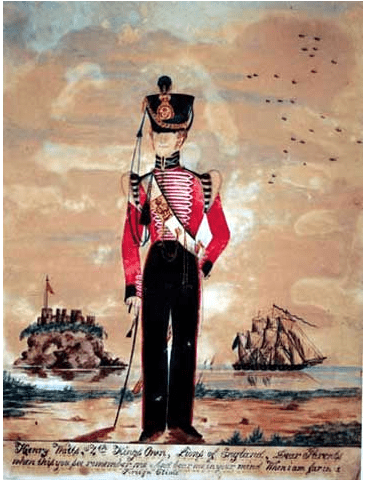
From King’s Own Royal Regiment Museum, Lancaster. Portrait of Private Henry Watts upon his departure for Australia in 1831.
11th Regiment of Foot (North Devonshire)

This variation with Roman numerals dates pre 1855. Jennens & Co London.
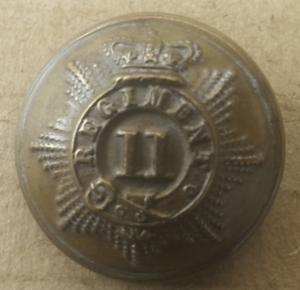
11th (North Devonshire Regiment of Foot 1855-1881 by Firmin’s Ltd London
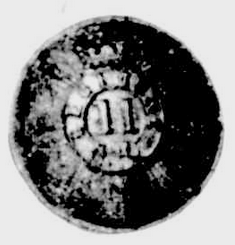
The Queenslander, 6th October 1932 page 20.
This regiment was garrisoned in Victoria Barracks, Sydney from 1845-1857, apparently being brought in from Van Diemen’s Land to control the badly behaved 99th regiment! They returned after a second tour of duty to England in 1857.

The Courier (Hobart), 10th June 1845 page 2.
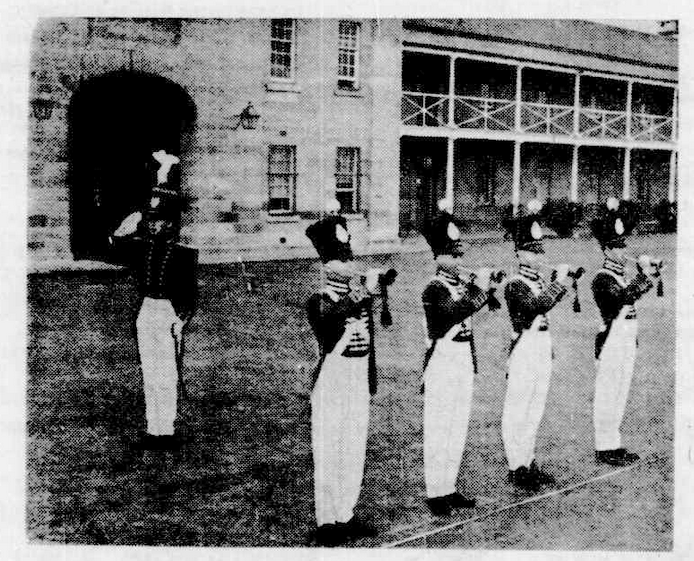
Western Herald (Bourke,NSW), 16th December 1966 page 1. Buglers dressed in reporduction uniforms of the 11th FDoot in 1848.
12th Regiment of Foot
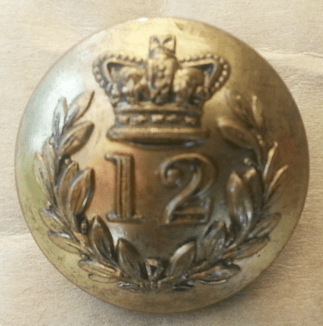
Backmark: Jennens & Co. London
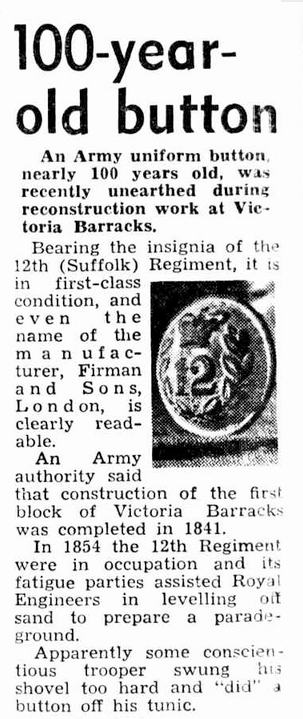
The Sun (Sydney), 13th October 1949 page 34. This design button was used until 1881. In 1855 the O.R. buttons changed from pewter to brass and became larger and more convex.
Victoria Barracks in Sydney was built for the accommodation of British troops such as the 12th Regiment of Foot. They were in Sydney from 1854 until called to New Zealand in 1860 to take part in the Maori Wars. A deployment of this regiment in Victoria was involved in the infamous battle at the Eureka Stockade rebellion in 1854. They were also deployed to Tasmania, Queensland and Swan River (West Australia). The regiment left Australia in 1866.
See also http://www.austbuttonhistory.com/uncategorized/21st-october-2020/
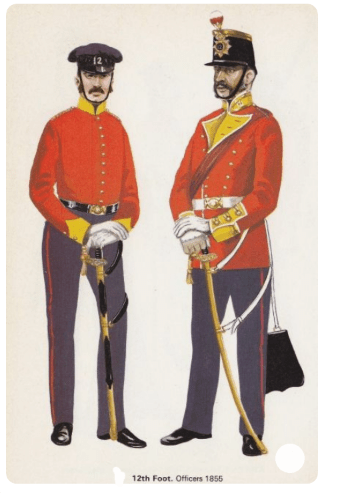
From Pintrest; source unknown.
14th Regiment of Foot (Buckinghamshire)
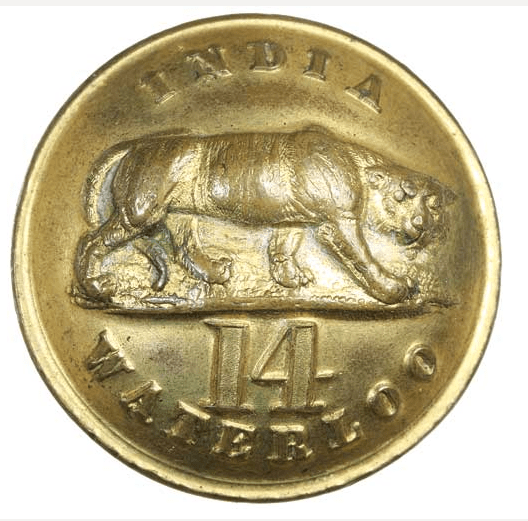
P. Tait & Co, Limerick (Thanks to Noble Numismatics). This button may date from the deployment in Australia.
The 14th regiment of Foot arrived in Hobart from New Zealand on the 31st October 1866. They Served in Adelaide, Hobart, Melbourne before leaving in 1870.
For their time in New Zealand, see https://collection.pukeariki.com/persons/12202 (Note there are a couple of typos in the article i.e. 1961 and 1968 instead of 1861 and 1868.)
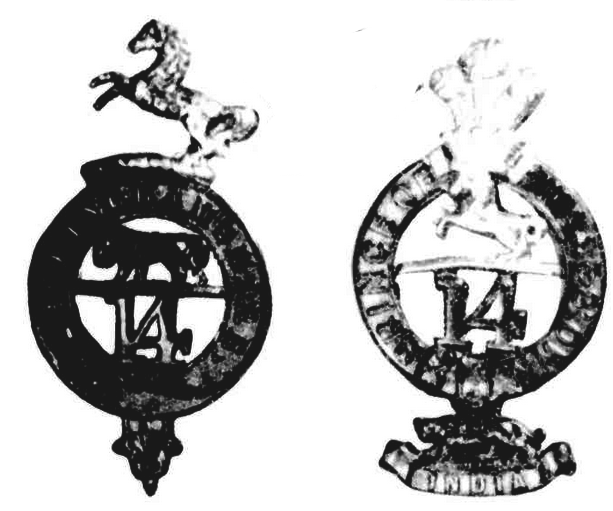
The Queenslander, September 29th 1932 page 27. Cap badges of the 14th.
The 14th regiment of Foot arrived in Hobart, months later than expected, on the 31st October 1866. They Served in Adelaide, Hobart, and Melbourne before leaving in 1870.
The button can be seen on Cossum page 64, also at https://collection.maas.museum/object/85036. A version with roman numerals and the tiger facing the other way also exists. According to Gwen Squires this pre-dates the period in Australia.
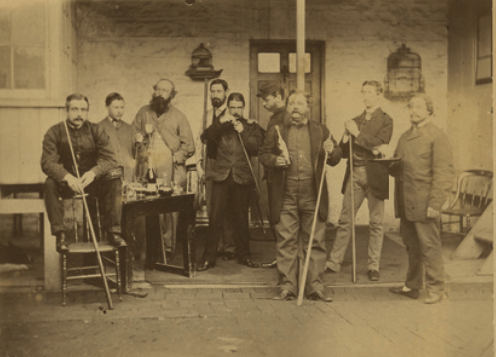
State Library of SA # 18519. Billiard Players from the 14th Regiment of the Foot British Army c.1869.

Illustrated Australian News for Home Readers (Melbourne), 23rd April 1870 page 77. The 14th Foot assemble on Railway Pier to leave for England.
17th Regiment of Foot (Leicestershire)
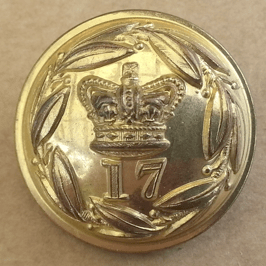
This looks similar to that seen on page 65 of Cossum, but was not sourced in Australia. Backmark: Jennens & Co London, which pre-dates 1860. The design dates from 1830.
Deployments of this regiment arrived New South Wales as convict escorts from 1830 and were stationed in New South Wales, Tasmania and Queensland. They left in for India in 1837.
The 17th were involved in two documented massacres in 1831 and 1832. They also fought against resisting aboriginals in the Newcastle area in 1835. Early buttons were silver for officers and pewter for O.R, with the simple design of arabic numerals ’17’ within a circle. The officers’ gilt button above is the 1830 version.
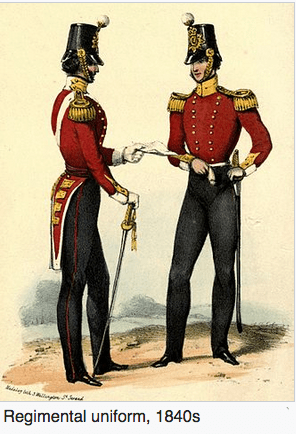
From Wikipedia.
18th Regiment of Foot (Royal Irish)
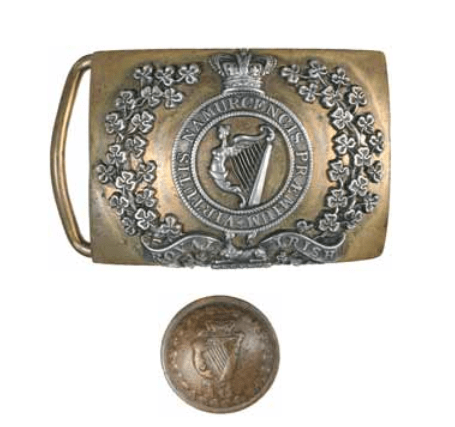
Courtesy of Noble Numismatics.
The buttons worn at the time of their deployment were gilt for officers and brass for O.R.

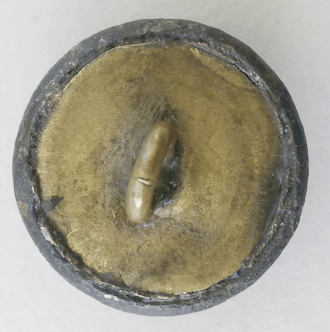
This button has been repaired, possibly because it was a ‘dug’ item and the back was too corroded.
When the New South Wales Corps was replaced by the 73rd Regiment of Foot in 1808, the intention was for units to be rotated through the Colonies in 4-5 year stints:
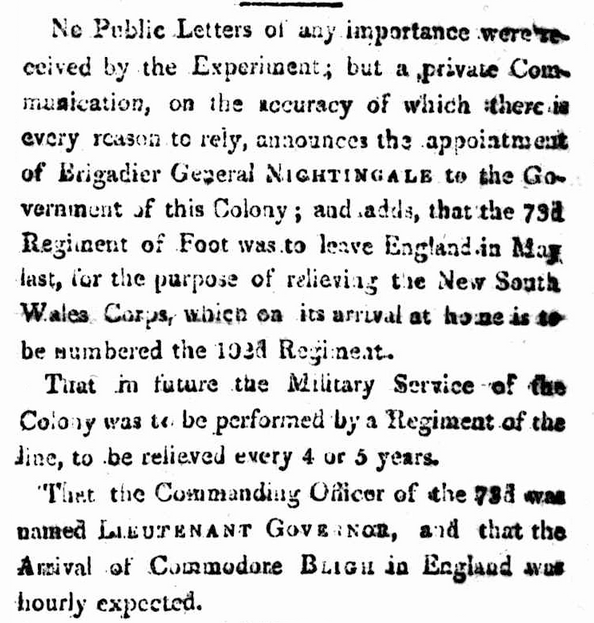
The Sydney Gazette and New South Wales Advertiser, 2nd July 1809.
In reality, the periods of service varied from less than one year to twelve years. One regiment that made only a fleeting visit was the 18th Regiment, with some sent to the fighting in New Zealand in 1870.

Weekly Times (Melbourne), 1st January 1870 page 11.
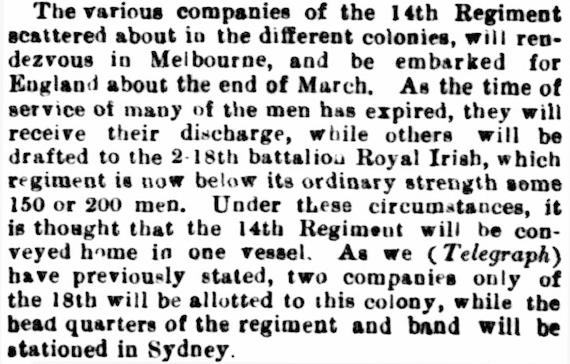
The Ballarat Courier (Vic), 8th January 1870 page 2.
Detachments were sent to Adelaide, Melbourne and Tasmania to replace the men of the 14th who had been posted there. In March, the remainder of the Regiment arrived from Auckland. The 18th and the Royal Artillery left in September to return to Britain, although a number of men had absconded in Sydney, not wishing to sail to England! In at least one case, this was because the soldier had married a local woman. Some deserters made sure the last of the troops had sailed before giving themselves up. The vacated barracks were to be used by Volunteer Corps.
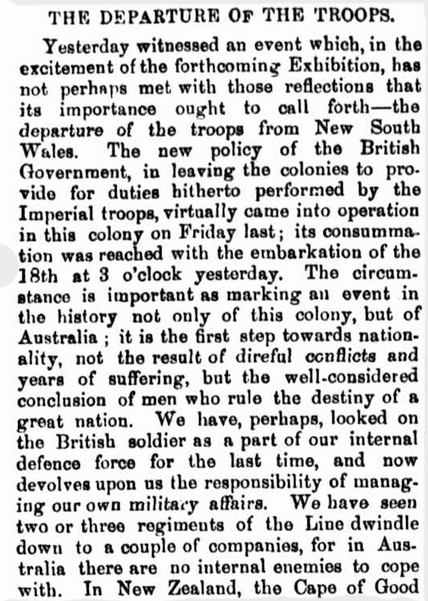
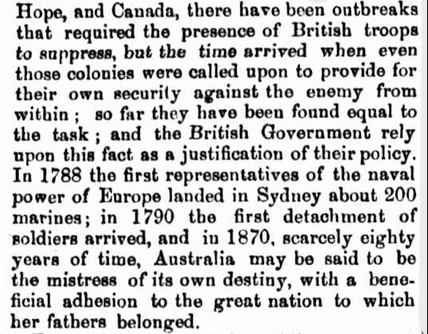
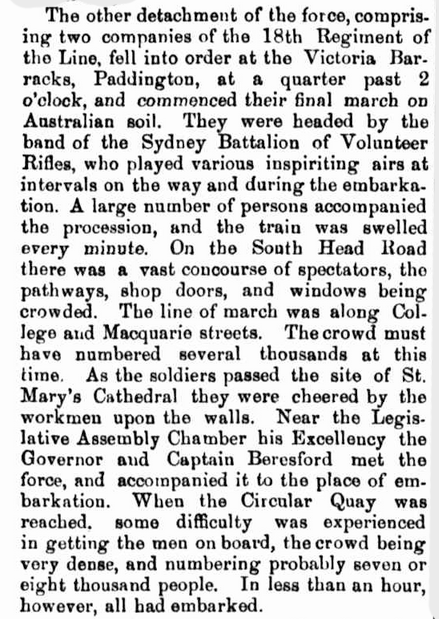

Gympie Times and Mary River Mining Gazette (Qld), 7th September 1870 page 4.
21st Regiment of Foot (Royal North British Fusiliers)
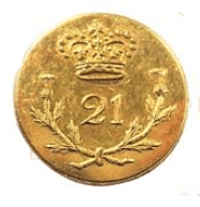
From Pintrest, source unknown c.1812, but similar to that used in the 1830s. Note the thistles. This regiment had its origin in Scotland, and would be renamed the Royal Scots Fusiliers in 1877. They were gilt for officers and pewter for O.R.
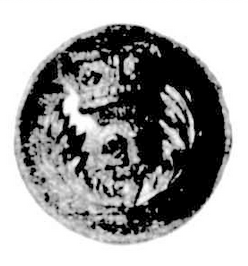
The Queenslander, 6th October 1932 page 20.
This regiment served in New South Wales, Western Australia and South Australia between 1833-1839. They then left for Madras, India.

The Sydney Herald, 13th December 1832 page 2.

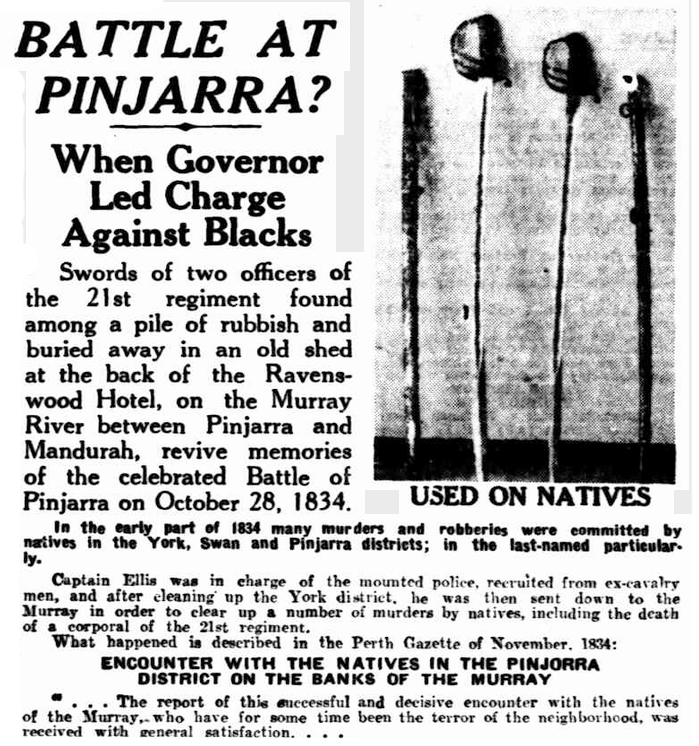
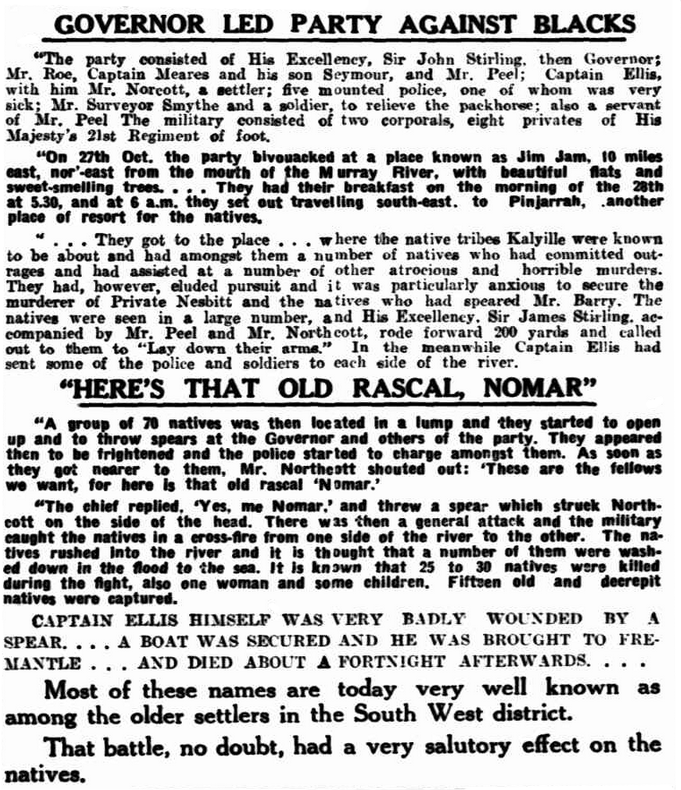
Published in the Mirror (Perth), 19th March 1938 page 11. Oh dear. Sorry about the attitude.
28th Regiment of Foot, (North Gloucestershire)
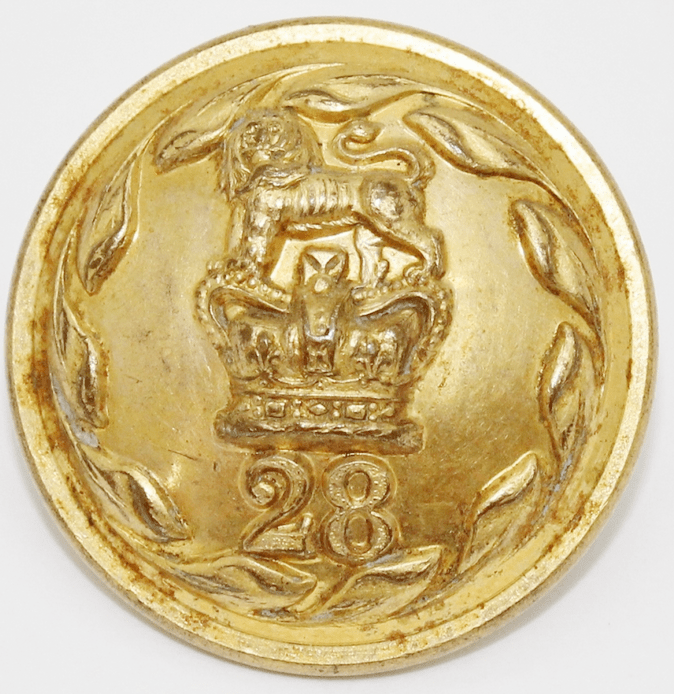
Courtesy of Cultman Collectables. This is similar to Cossum’s example on page 65. The officers’ buttons were gilt from 1830 and brass for O.R.
From 1835 the regiment sailed with convict ships to Australia to serve as garrison troops. The headquarters were in Parramatta, but they were also sent around New South Wales, Queensland and Victoria. Many of the troop took the opportunity to settle in Australia when the regiment was transferred to India in 1842. Three of the ships carrying them to Bombay ran aground, taking 6 days to get free.
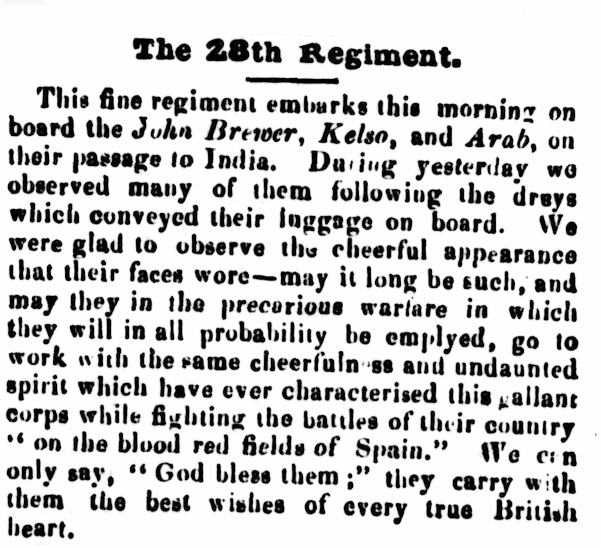
The Sydney Gazette and New South Wales Advertiser (NSW), 16th June 1842 page 2.
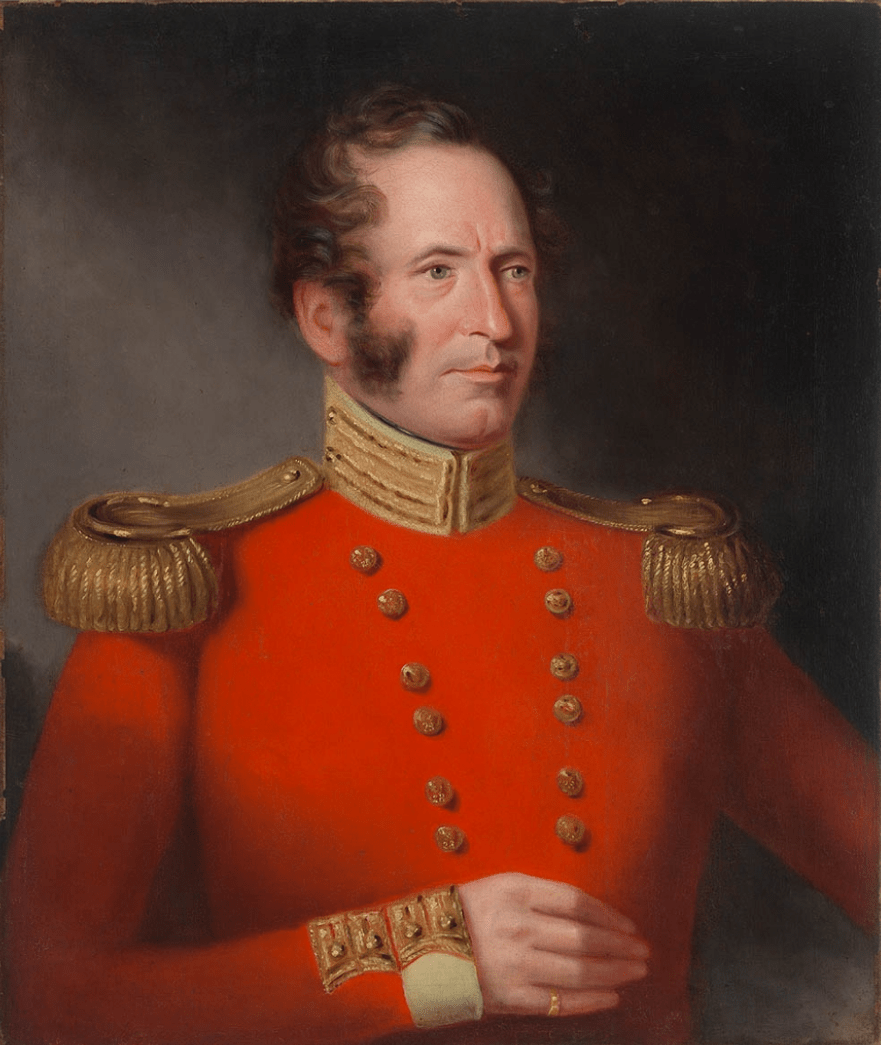
Mitchell Library, State Library of New South Wales : Lieutenant J. J. Peters, 28th Regiment, 1840.
39th Regiment of Foot (Dorsetshire)
The regiment arrived in New South Wales late in 1825. In 1826 a detachment under Major Ralph Darling was sent from NSW with a party of convicts to establish a penal colony where Albany is now situated, before the French could claim the area.
They also served in Hobart and Swan River (Perth) and Bathurst before leaving for India in July 1832. The most famous member of this Regiment to serve in Australia was Captain Charles Sturt.
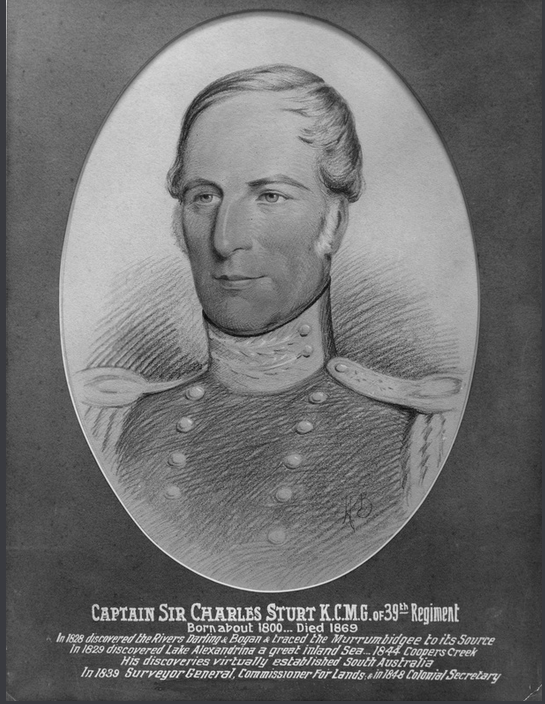
State Library SA image B6847. Capt. Sturt c.1850.

Image from Pintrest, no origin or date supplied. However, the design was unchanged from the late 18th century until 1855; gilt for officers showing arabic numerals ’39’ under a crown surrounded by a ‘french scroll’ (see on this button). Other Ranks were had a dot between the opening of the scroll.
40th Regiment of Foot (2nd Somersetshire)
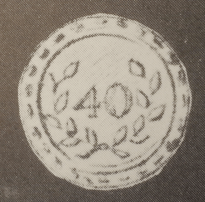
Version used during the first tour.
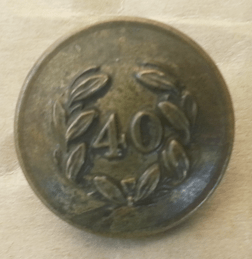
Backmark: Firmin’s Ld London. This design was current during the second tour of duty. Brass buttons were issued from 1855.
Small detachments were sent to New South Wales to relieve the 48th Regiment via convict ships in 1823. They also served in Van Diemen’s Land (Tasmania), where they were involved in hostilities against the aboriginal people. In 1828-9 the regiment left for Bombay.
In 1853 they returned to Australia for a second tour of duty and were quartered in Melbourne for the furnishing of companies to protect the goldfields. Some companies of the 12th and 40th regiments were sent to Ballarat in early December 1854 to suppress the miner’s rebellion at Eureka Stockade on the morning of 3 December 1854. In 1860 they went to fight in the Maori Wars.
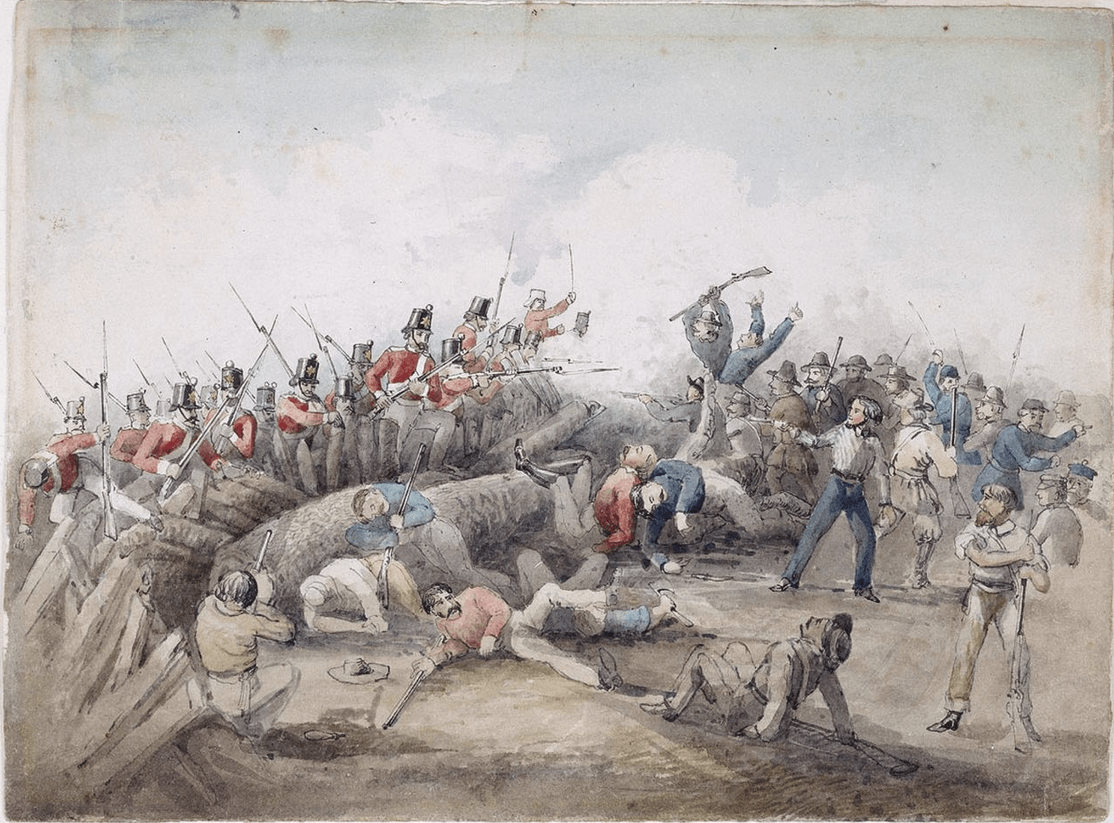
Battle of the Eureka Stockade. J. B. Henderson [1854] Watercolour
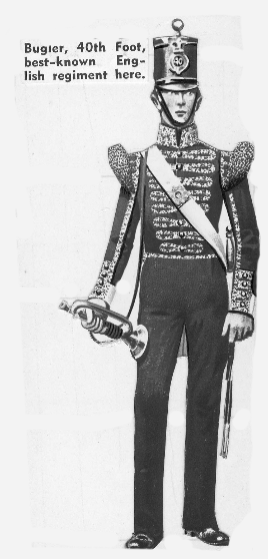
Photographs printed between 1940 and 1950 from originals between 1850 and 1900. From Argus Newspaper Collection of Photographs, State Library of Victoria.
46th Regiment of Foot (South Devonshire)
On the left is an example of a post 1800 O.R. uniform button. The sketch shows the design for officers in silver.
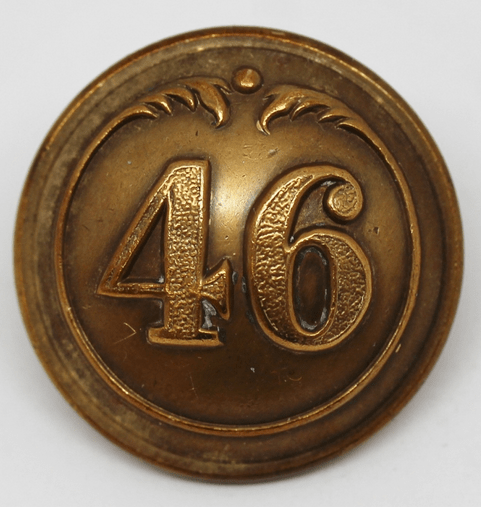
Courtesy of Cultman Collectables
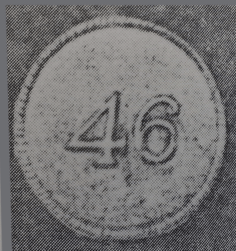
Numerals within a roped border.
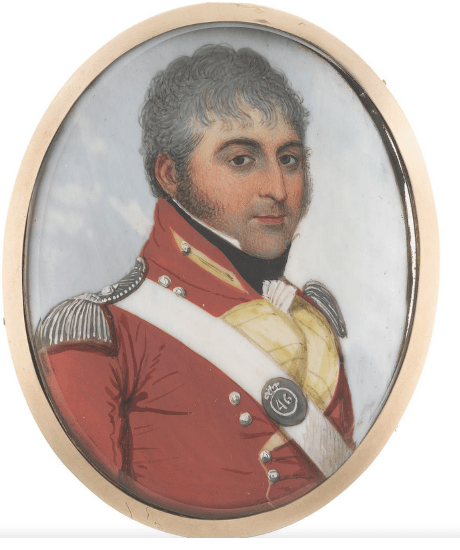
Portrait of a Captain of the 46th. Possibly just before the Australian tour. Courtesy of Bonhams auctions.
The first detachment set off as escorts for convicts bond for New South Wales in August 1813, to replace the 73rd in New South Wales and Tasmania.

The Sydney Gazette and New South Wales Advertiser (NSW), 12th February 1814 page 2.
Whilst in Van Diemen’s Land, they had orders to suppress a gang of bushrangers.
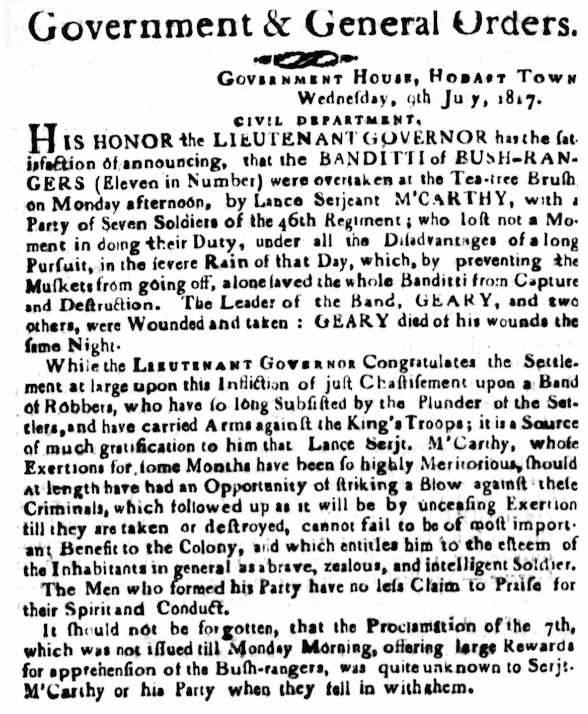
The Hobart Town Gazette and Southern Reporter (Tas), 12th July 1817 page 1. This was the infamous group originally lead by Mike Howe, the most notorious bushranger in Tasmania’s history.
In 1816, (after crimes such as the murder of a farming couple and the theft of pigs), they were required by Governor Macquarie to kill, terrorise and take as prisoners as many aboriginals as possible in the Nepean, Hawkesbury and Grose River valleys of New South Wales, although that was not the way it was described in the news …

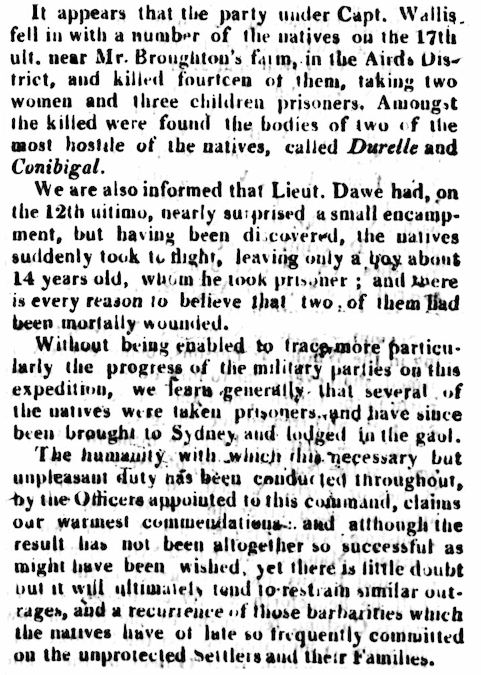
The Sydney Gazette and New South Wales Advertiser (NSW), 11th May 1816 page 2.
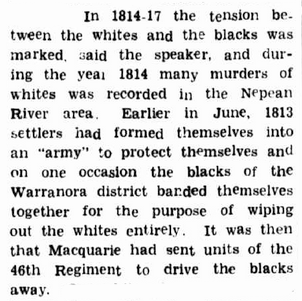
The Campbelltown News (NSW), 10th April 1951 page 1.
They left New South Wales in September 1817 and Hobart in June 1818, bound for India. However, there were still members of the 46th during 1819-1828 bringing convicts to Australia.
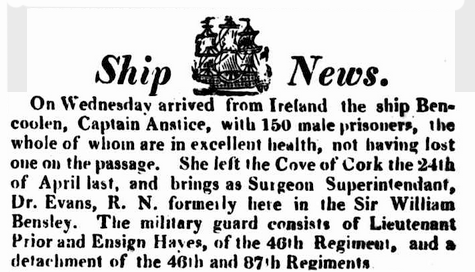
The Sydney Gazette and New South Wales Advertiser (NSW), 28th August 1819 page 3.
48th Regiment of Foot (Northamptonshire)
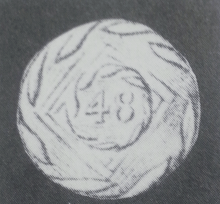
According to Montague, this design was worn in 1818. Officers’ were silver.
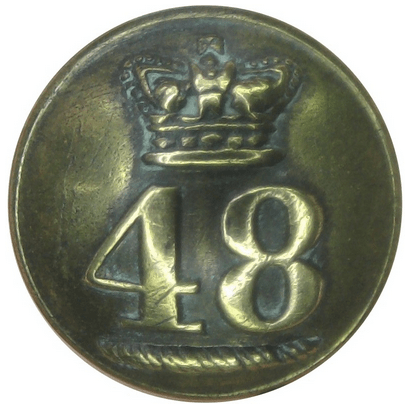
This is labelled 1855-81 by Kellu Badges therefore despite being shown in Cossum would not be worn during the deployment.

Army newspaper, 9th October 1980 page 10. Soldier in reproduction of 48th Foot uniform.
The regiment sailed for New South Wales as convict escort from August 1817 and stationed in Sydney, Newcastle, Port Macquarie, Van Diemen’s Land and Parramatta. They left in 1824 for India.
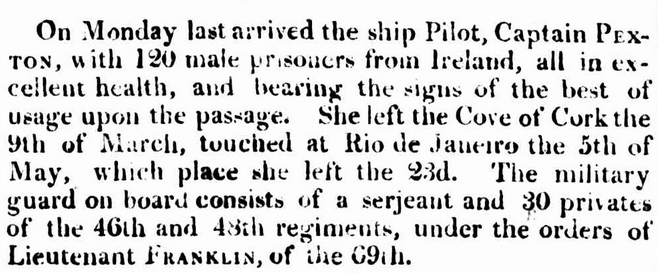
The Sydney Gazette and New South Wales Advertiser (NSW), 2nd August 1817 page 2.
In the 1930s the story was told of a scandal in Sydney; Captain Debussy (or Major O’Farrell) of the 48th regiment fought a duel with Mr Mountstuart (or Fitzurse), badly injuring him, then ran way into the bush. He was shot around 6 years later when troops went to investigate a ‘wild white man’ who had gone ‘native’ and was causing trouble both for the local tribe and for the Australian Agricultural Company. Trouble is, there was no mention of it at the time, so maybe it was a mere folk story!
50th Regiment of Foot (Queen’s Own)

Backmark: Jennens & Co. London. dating around 1810-1831, in silver or pewter.
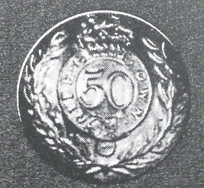
Officers’, gilt 1831-55. Other ranks’ buttons had the Royal Crest with the numerals below, changing to brass after 1855.
There were two separate periods of deployment in Australia. This regiment served in New South Wales, Tasmania, and Norfolk Island during their deployment from 1833-1841. Two companies left Sydney for New Zealand on a short term mission to rescue some settlers.

The Australian (Sydney), 4th November 1833. They arrived in December with more following later.
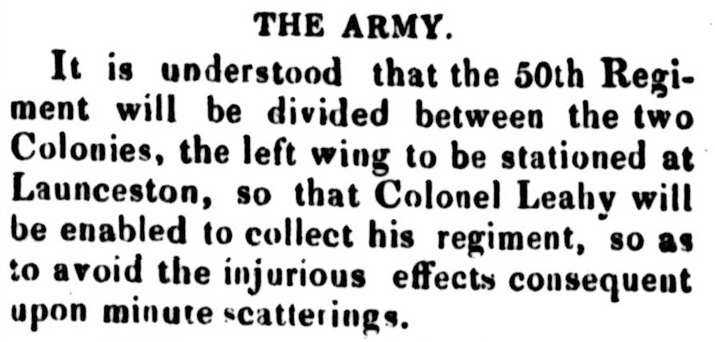
The Tasmanian (Hobart Town), 31st January 1834 page 6.
They left for India in 1841. Some of the families of the 50th were shipwrecked on route to India, and rescued in a “wretched condition.”
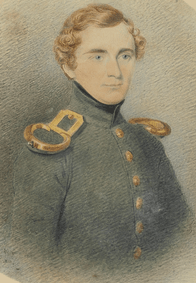
State Library NSW: Lieutenant Grimes of the 50th Regiment, 1840.
The regiment returned in 1866, having served in Crimea, Ceylon and New Zealand, and were stationed in New South Wales, Tasmania, South Australia and Queensland before leaving for England in 1869.
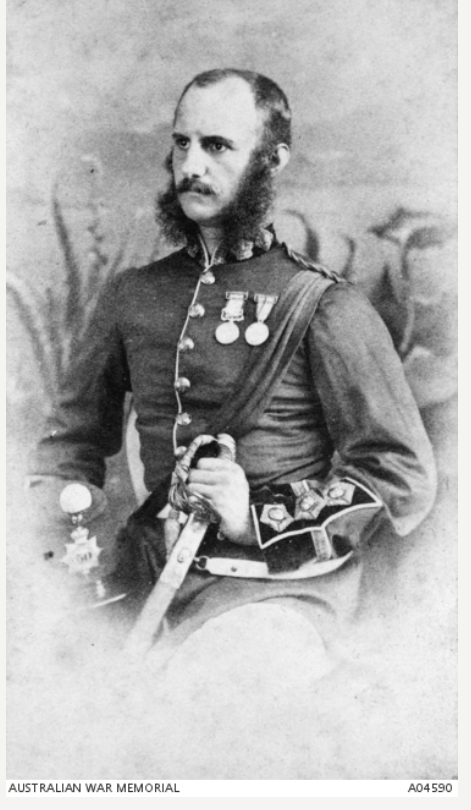
Australian War Memorial image #A04590. An officer of the 50th, 1866-69.

The buttons here are by Firmin & Sons, London. Courtesy National Army Museum https://collection.nam.ac.uk/detail.php?acc=1998-06-1-1)
For their time in New Zealand: http://ellott-postalhistorian.com/articles/50th-Regiment-In-NZ.pdf
51st Regiment of Foot (2nd Yorkshire, West Riding)
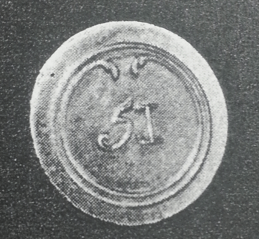
According to Squires: Officers’, gilt, pre 1814. however, Montague describes this as being used until the 1830s.
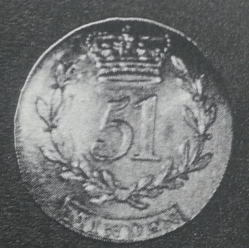
According to Squires: design used from 1814 and becoming gilt for officers in 1840. (According to Montague, a French Horn was depicted from the 1830s, but Squires has this from after 1880.)

According to Gwen Quires: Officers’ version, 1855-1880 (after deployment).
The regiment traveled to Australia in detachments as escorts to prisoners in 1837. The first detachment arrived in January 1838 to relieve the 80th in Sydney.

The Colonist (Sydney), 19th October 1837.
They served in New South Wales, Western Australia and Tasmania before leaving for India in 1846.
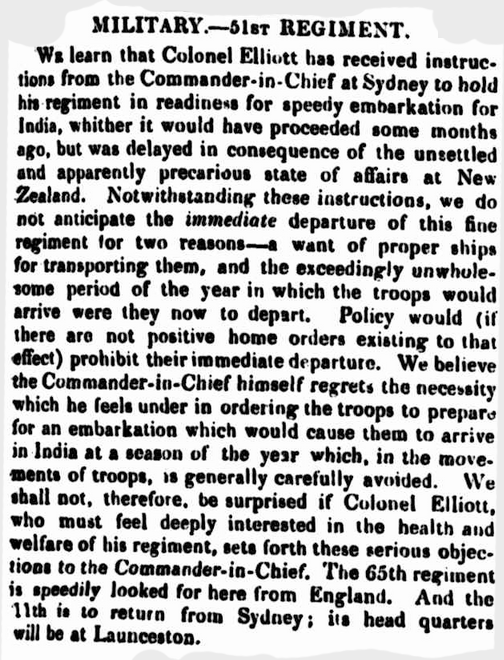
The Courier (Hobart), 18th March 1846 page 3. This article shows examples of how British regiments were moved from colony to colony, and country to country, depending on security concerns.

Library NSW. An officer of the 51st Regiment, c.1845-55.
57th Regiment of Foot (West Middlesex)
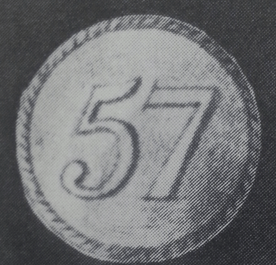
According to Montague: Pre 1830 version in silver for officers, O.R. in pewter.
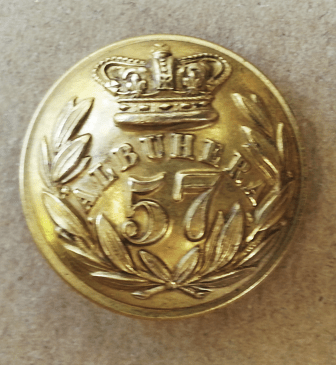
Jennens & Co London (Prince of Wales plume). This version dates from the 1830.-55
The 57th Regiment served in Australia from 1825 until 1832 when they sailed for India in detachments between January and April 1832.
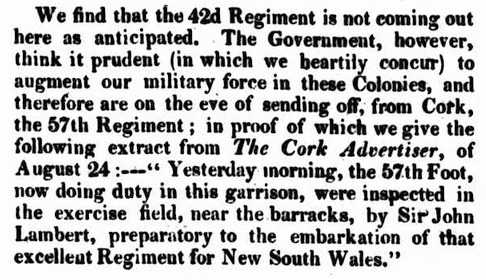
The Sydney Gazette and New South Wales Advertiser , 6th January 1825 page 1.
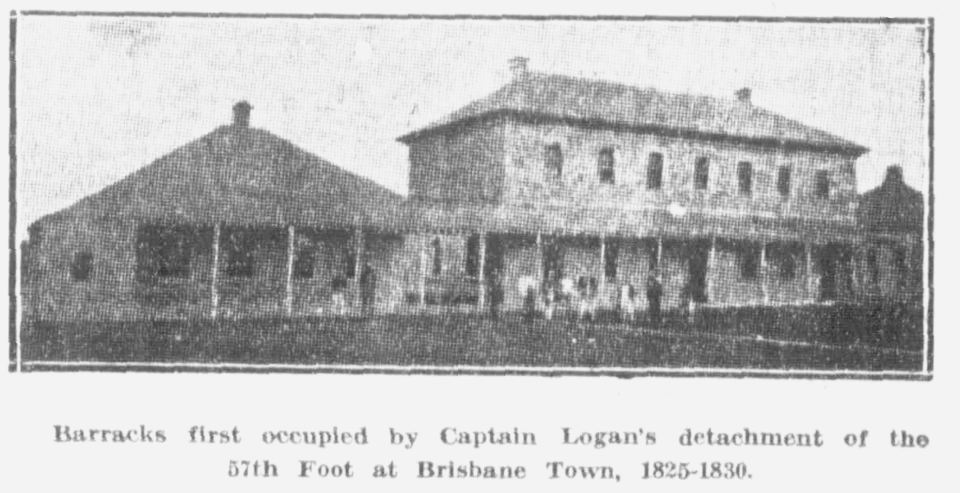
The Telegraph (Brisbane), 8th April 1933 page 11.

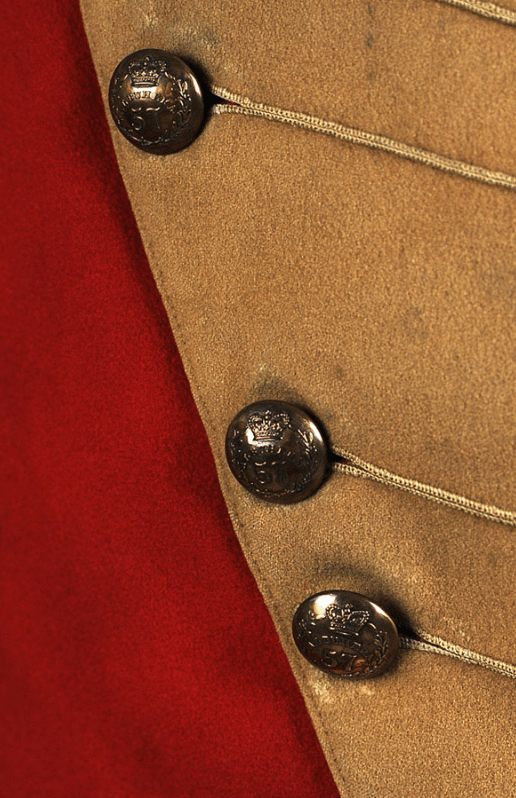
Courtesy of the National Army Museum https://collection.nam.ac.uk/detail.php?q=searchType%3Dsimple%26simpleText%3Dfull%2520dress%2520coatee%26themeID%3D%26resultsDisplay%3Dlist%26page%3D2&pos=1&total=24&page=2&acc=1992-09-65-1
This coatee is poignant as it belonged to Captain Patrick Logan, Commandant of Moreton Bay, New South Wales. He was killed by Aboriginals whilst surveying the area. The 57th served in Australia from 1825-1832. If he arrived in Australia in 1822, it is strange that the 1830s buttons are found on his coatee, unless there is a mistake here by Montague/Squires or the buttons were replaced!.
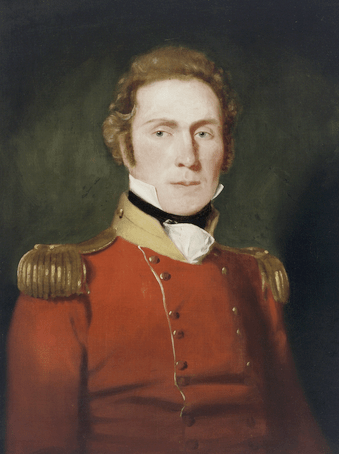
State Library NSW file #FL580514 c.1825.
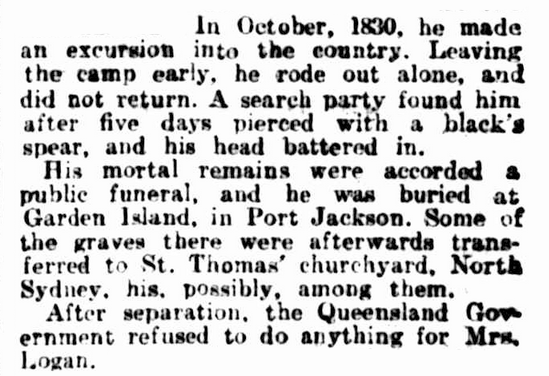
The Brisbane Courier, 5th June 1923 page 13.
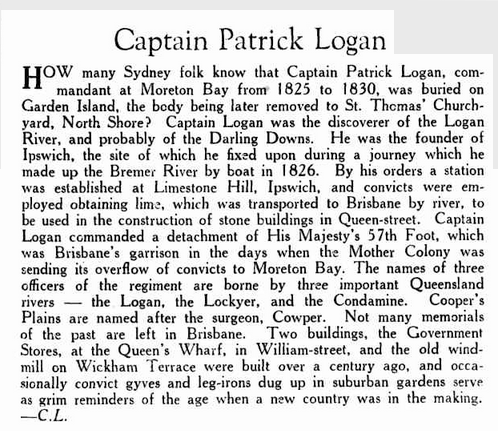
Sydney Mail, 20th November 1935 page 6.
The 57th were involved with a sad and notorious episode in Sydney. On the 22nd November 1826 two wretched soldiers were “drummed out” of the regiment for theft whilst wearing heavy spiked collars around their necks, attached by chains to their ankles.
Conditions were so bad in the Sydney garrison that desperate soldiers had been stealing deliberately so as to be drummed out, considering life in the road gangs as better than being a soldier. Governor Darling decided to make a terrible example of Joseph Stubbs and Patrick Thompson. Stubbs was already ill, and died five days later.
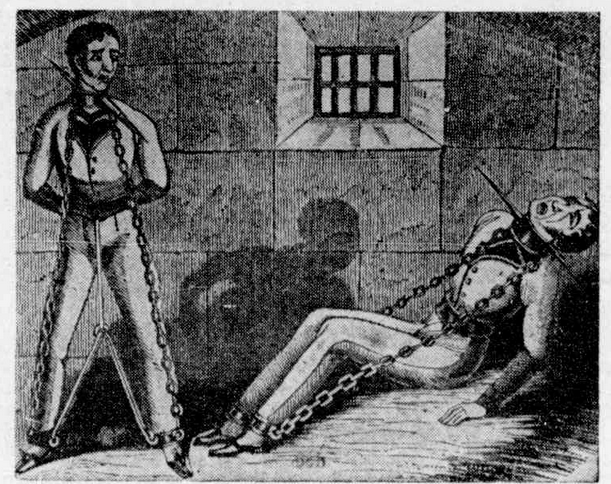
From News (Adelaide), 29th April 1954 page 28.
58th Regiment of Foot (Rutlandshire)
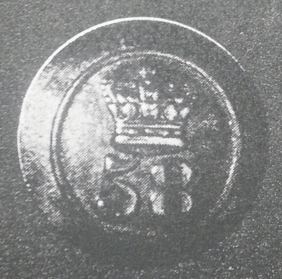
Squires: O.R., brass, 1855.
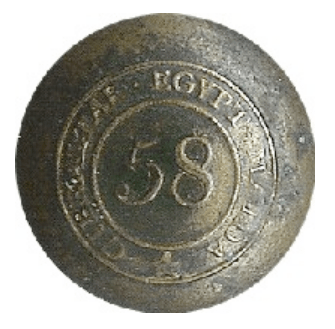
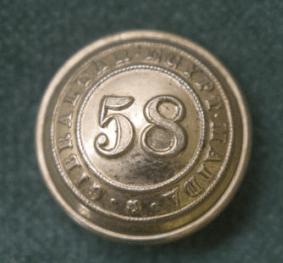
Coutesy “Russell Carter: The circle was inscribed ‘Gibralter’, ‘Egypt’ and ‘Maida’. The tunic buttons issued in 1855 had two types of numerals, large and small.
This regiment served in New South Wales from November 1843, taking over duties from the 80th Regiment, until they were needed in New Zealand, and left to serve there from 1845-47. Those not wishing to settle in New Zealand left for ‘home’ in 1859.
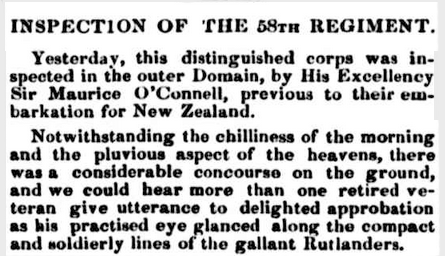
The Australian (Sydney), 27th May 1847 page 3.
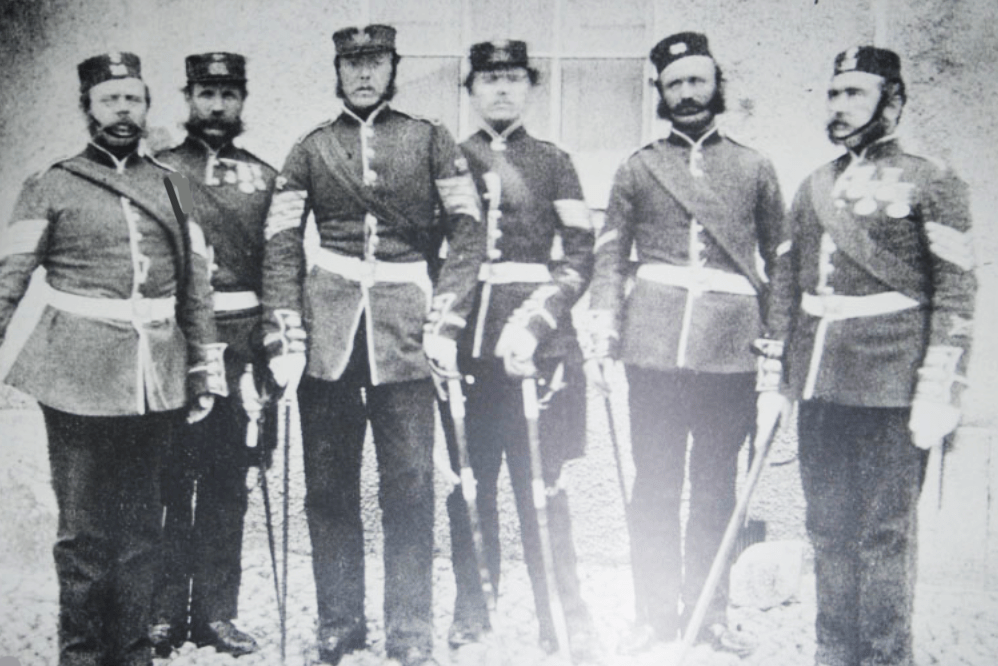
Wikipedia: Non-commissioned officers of the 58th Regiment in New Zealand, c.1858.
63rd Regiment of Foot (West Suffolks)
In 1829 Captain James Stirling and a party of English colonists settled in Swan River as the site of the new colony. A detachment of the 63rd West Suffolks was sent to guard the new capital. This regiment had arrived in Sydney from 1828 and also served in Hobart. It left for India in February-March 1833.
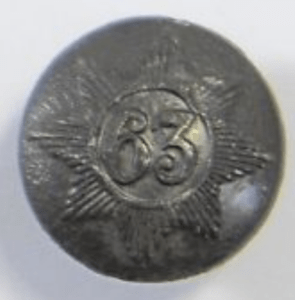
From Pinterest: Labelled as a pre-1855 example. This design had existed with minor changes from 1780-1880.
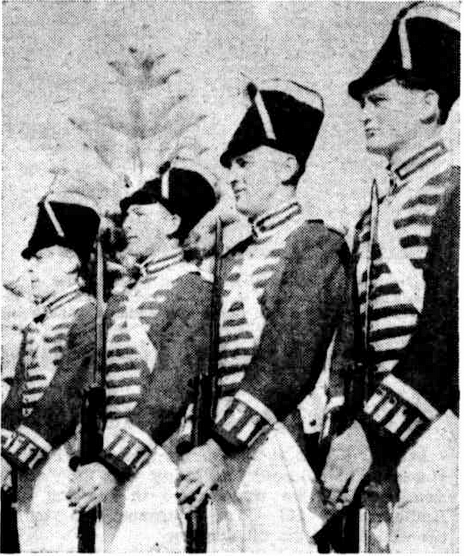
The West Australian (Perth), 5th June 1951 page 2. Soldiers wearing the uniform of the 63rd Regiment at the Foundation Day ceremony.
From 1829 detachments of many of the regiments serving in New South Wales would serve in Swan River, starting with the 2nd/40th Regiment.
65th Regiment of Foot (2nd Yorkshire, North Riding)
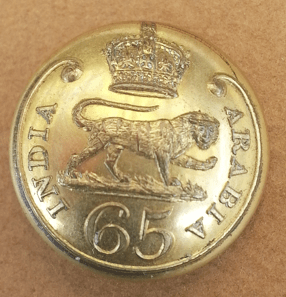
1840-55 officer’s button.
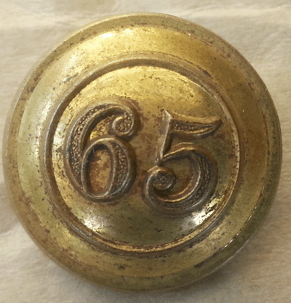
No backmark. According to Gwen Squire, Other ranks, brass, 1870-1874. However, as these are turning up in NZ, perhaps they date earlier.
This regiment brought convicts to Tasmania and Norfolk Island in 1846 and 1849. They soon went onto New Zealand, where they served until September 1865. Four hundred men accepted their discharge, and remained in Auckland.
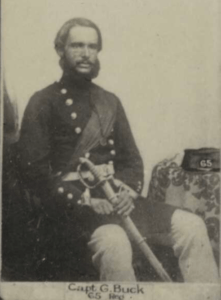
A member of the 65th Regiment in New Zealand.
For more about the 65th in New Zealand, see https://hicketypip.tripod.com/history.htm
73rd Regiment of Foot (Royal Highlanders)

Thanks to Noble Numismatics. From 1780 until 1809 it was known as the 73rd (Highland) Regiment of Foot. It depicts a rose and a thistle, gilt for officers, pewter for O.R.
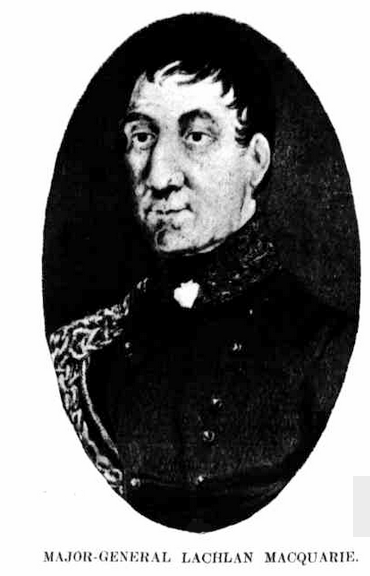
The Sydney Mail and NSW Advertiser, 19th January 1910 page 34.
From 1786 until 1809 this regiment was known as the 73rd (Highland) Regiment of Foot, which would explain the thistle on the button. They lost Highland status around the time of the start of the journey to Sydney. They were to take over from the 102nd (NSW) Corps, who had been involved in the Rum Rebellion that lead to the deposing of Governor Bligh.
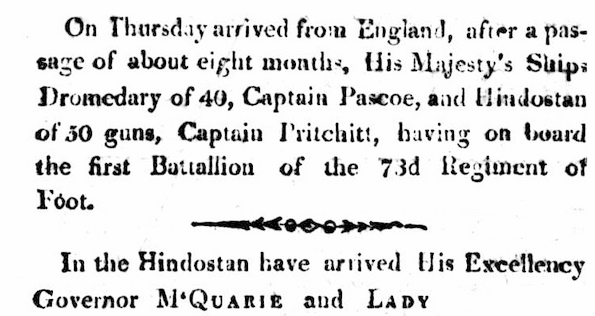
The Sydney Gazette and New South Wales Advertiser, 31st December 1809 page 1.
Arriving in the harbour on the 28th December, the 1st Battalion of the 73rd Regiment landed in Sydney on the 1st January 1810 with Governor and Lady Macquarie. (Note a detachment had arrived on an earlier ship in August 1809.) It relieved in 102nd Regiment (NSW Corps) however some of these men were drafted into the 73rd. They are remembered for clearing land at what is now Hyde Park for the first horse racing course in Australia, and running the first race in October 1810! They also built new roads. Their tour of duty ended in 1814 then they left for Ceylon.
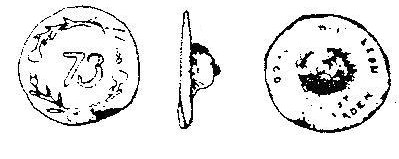
Example of pewter buttons unearthed in Tasmania.
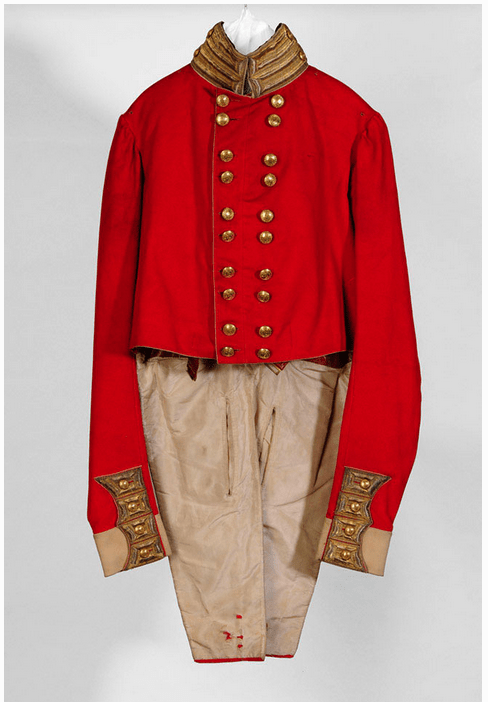
British Army Museum: c.1815 coatee of the 73rd Foot.
77th Regiment of Foot (East Middlesex)
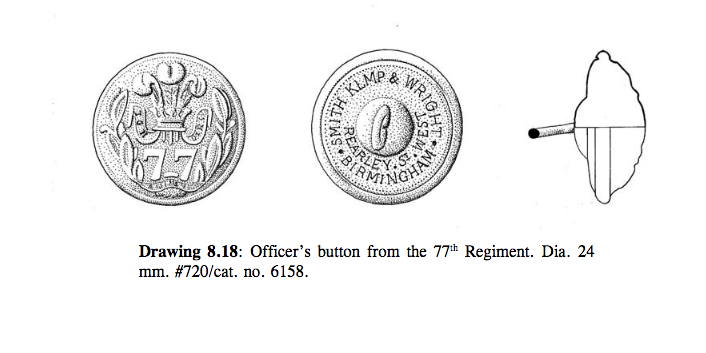
’ Archaeological Investigation Conservation Siter, Macquarie Street, Sydney, Volume 1: History & Archaeology for NSW Department of Public Works & Services’ by Casey & Lowe P/L, page 269.
See also http://www.austbuttonhistory.com/uncategorized/13th-may-2021/
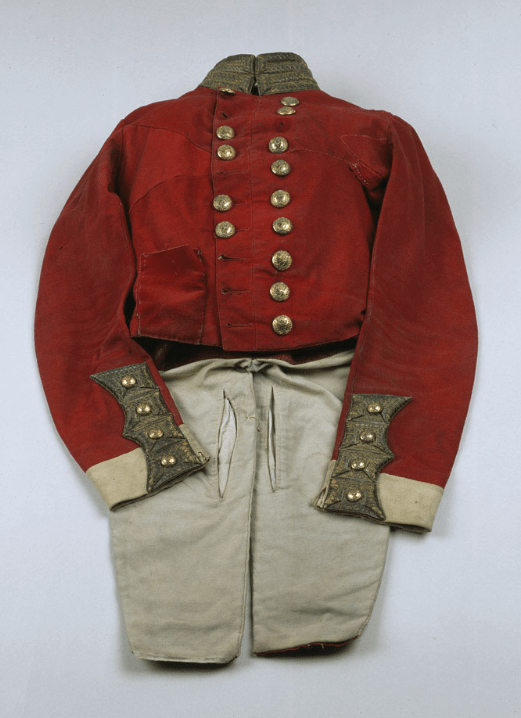
National Army Museum https://collection.nam.ac.uk/detail.php?acc=1992-09-53-1
Two ships bearing the 77th arrived in Sydney Harbour on 27th September 1857. However, they were not here long, leaving Sydney for Calcutta in April 1858. It was felt there was need for troops in India, and that “the great majority of the troops in New South Wales are not required here”.
In there short stay in Sydney, there was some reports of drunkeness and theft, and problems with the local police:
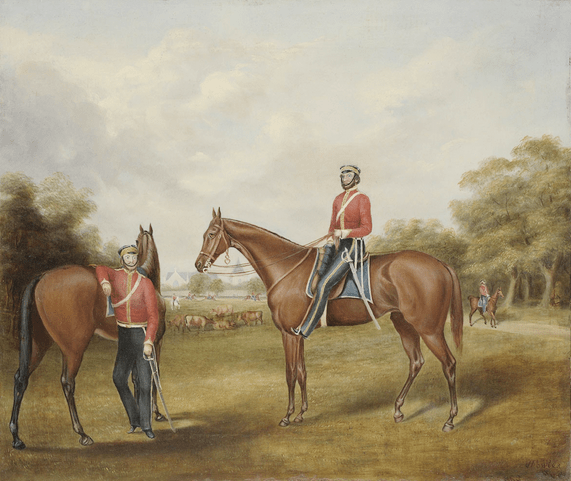
State Library NSW # IE1141695 Painting of two officers of the 77th Foot at Hyde Park, Sydney. 1858.
80th Regiment of Foot (Staffordshire Volunteers)
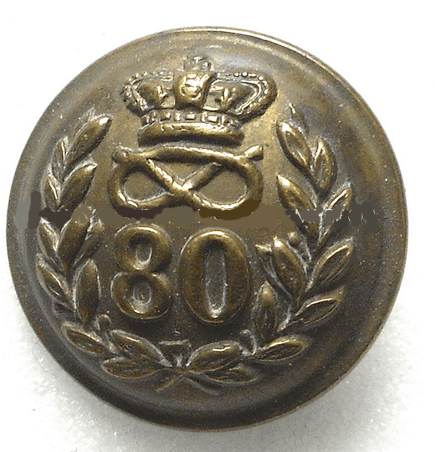
From relicmilitaria.com. Silver for officers, pewter for O.R. design current from 1820-1855
In 1836 the regiment started escorting convicts to Australia, arriving from October that year with 25 further detachments over the next two years. They had a long deployment, serving for around seven years in New South Wales, Melbourne, and Norfolk Island. The small detachment in Melbourne was called on to try to quell sectarian rioting that took place in 1846. From 1841-1844 a detachment was sent to New Zealand, were they cleared land, built a barracks and organised a treaty. They returned to Sydney to leave for India. A terrible shipwreck occurred on the way to Calcutta …
The Sentinel (Sydney), 25th June 1845 page
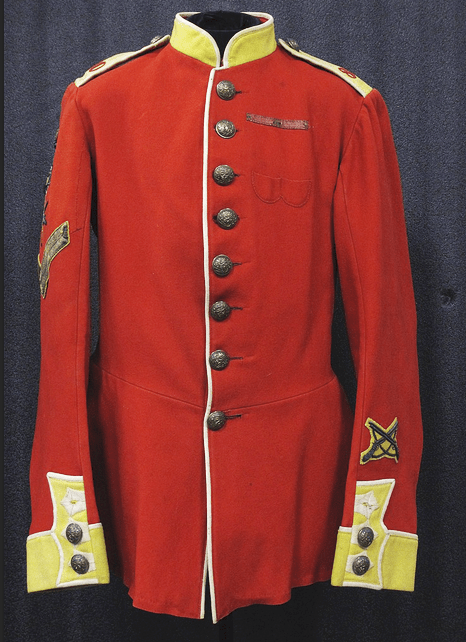
From Wikimedia:”Circa 1860 tunic of Colour Sergeant Thomas Hilditch, 80th Regiment of Foot AM 1974.72″. Note, however, that the 80th were in New Zealand from 1840-44.

96th Regiment of Foot
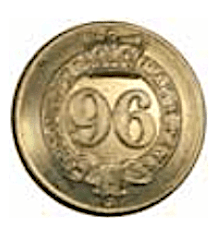
Thanks to Noble Numismatics. This dates 1830 onwards.
This regiment served in New South Wales, Tasmania and South Australia between 1839-1848, then travelled on to India. A detachment had been sent to New Zealand in 1845-6.


This button is described as an officer’s coatee button pre-1830. Apparently officers’ buttons were changed from silver to gilt in 1839. Whilst it is often claimed that the POW plume was only used by Jennens from 1860, this is disputed amongst collectors. As detachments of the 96th were being shipped from 1839, they would not have necessarily had the latest uniform buttons!
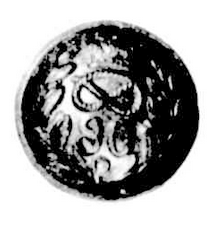
An example of a post 1839 button may be this from The Queenslander, 6th October 1932 page 20.
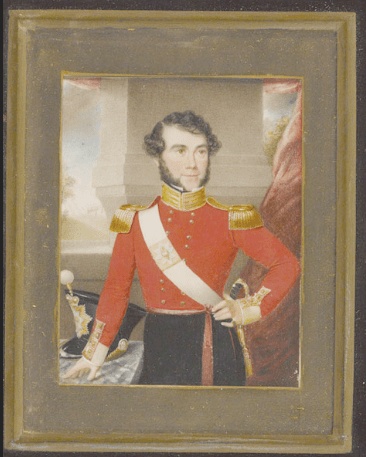
British Army Museum: Captain Abbott of the 96th Regiment of Foot, August 1836.
Detachments of the 96th were sent guarding convicts, arriving from December 1939 until August 1841, to New South Wales, Van Diemen’s Land and West Australia.
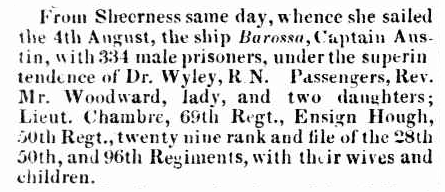
Commercial Journal and Advertiser (Sydney) shipping arrivals in Sydney, 11th December 1839 page 2.
In 1843 a detachment sailed to New Zealand to take part in the Maori Wars.
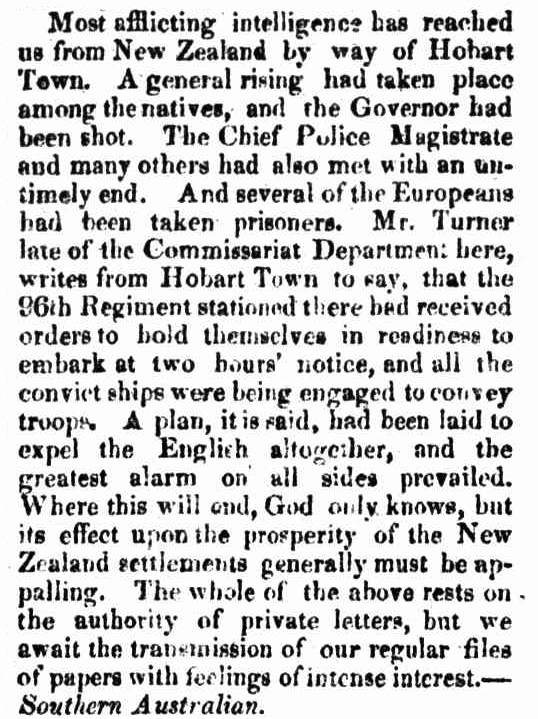
Reprinted in the The Perth Gazette and Western Australian Journal, 9th December 1843 page 2.
In 1849 they debarked for India.

Inquirer (Perth), 16th May 1849 page 3. There was dancing and drinking until 5 am the next morning!

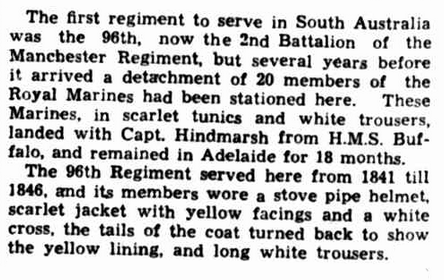
News (Adelaide), 27th November 1936 page 6.
In 1874 it was linked to a previous regiment of the same number, the Queen’s Own Germans. It was merged with 63rd Regiment and renamed The Manchester regiment in 1881. It was disbanded in 1818.
99th Regiment of Foot (Lanarkshire)
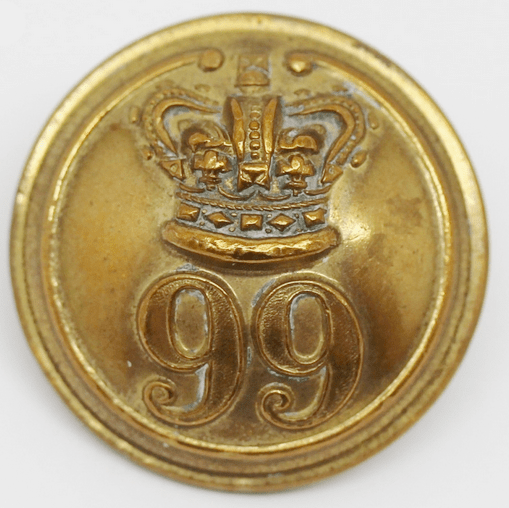
This button from Cultman Collectables is described only as Victorian. According to Squires, the design dates from 1855-74.
The 99th (Lanarkshire) Regiment of Foot was reformed in 1824. It amalgamated with the 62nd (Wiltshire) Regiment of Foot in 1881 to form the Duke of Edinburgh’s (Wiltshire regiment).
They served in the colonies from 1842 to 1856, although from 1845-51 contingents were sent to the wars in New Zealand. Throughout 1842 and into 1843, ships of convicts arrived in Hobart under guard of the 99th . On one ship several soldiers of the 99th were involved in an attempted mutiny. Another ship was wrecked with the loss of life of around 300 persons. Detachments were also sent to Sydney, Newcastle and Morton Bay. They got into trouble in 1847, and the 11th Regiment had to be deployed to settle things down …
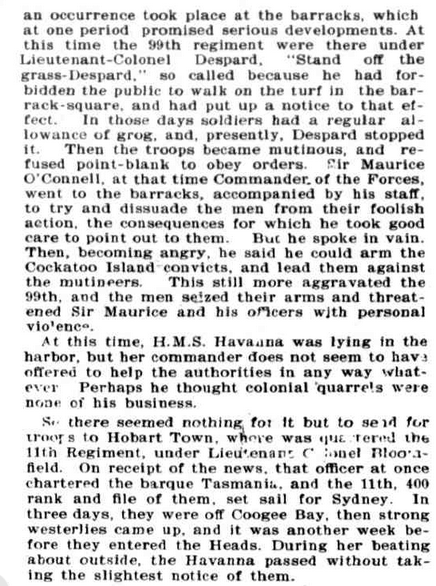
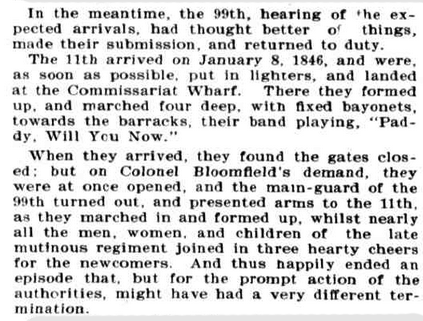
Australian Town and Country Journal (Sydney), 18th August 1900 page 34. A story from 1845.
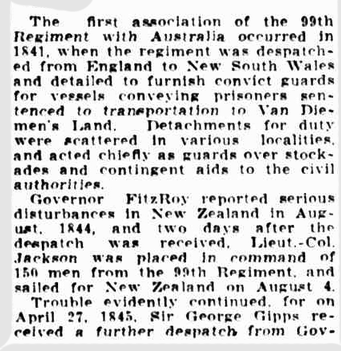
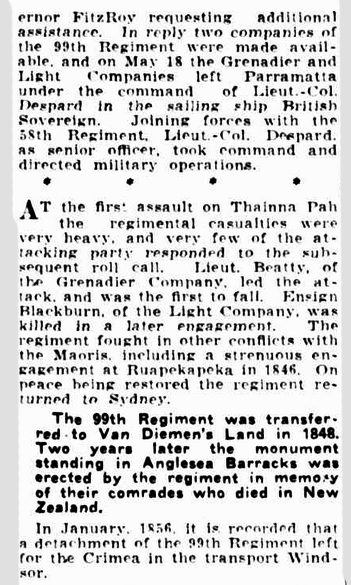
The Mercury (Hobart), 15th July 1939 page 10.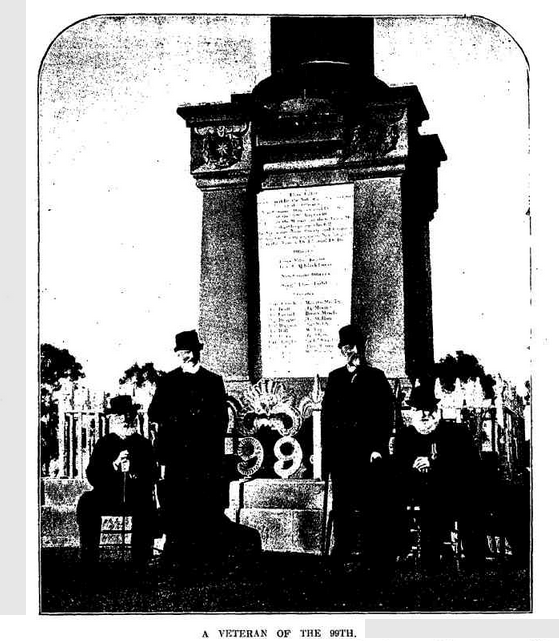

The Sydney Mail and New South Wales Advertiser, 25th October 1905 page 1049. This was the first war memorial to be erected in Australia.
When they sailed for home in 1856 over 400 men stayed behind in the colonies, transferring to other units.
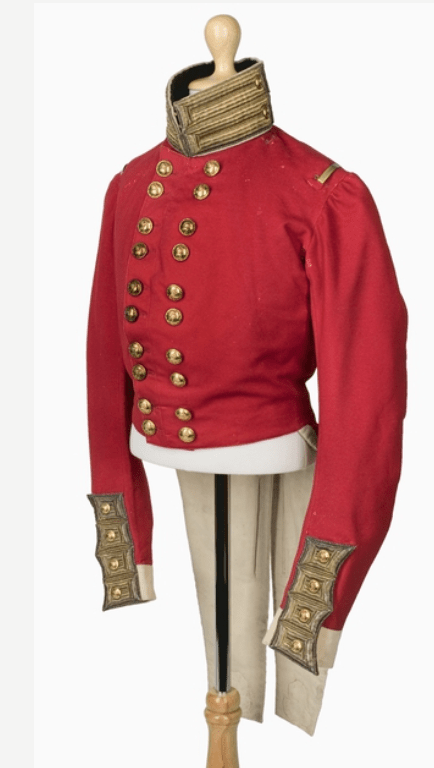
Australian War Memorial #REL/18964.001. Officer of 99th full dress coatee, made c1842-48. According to the AWM: all he buttons ware marked Jennins & Co, London, are convex closed gilt buttons and bear a Queen Victoria crown and the number ’99’.
https://en.wikipedia.org/wiki/99th_(Lanarkshire)_Regiment_of_Foot
New South Wales
http://www.austbuttonhistory.com/uncategorized/24th-october-2020/
http://www.austbuttonhistory.com/uncategorized/24th-october-2020-2/
http://www.austbuttonhistory.com/uncategorized/12th-november-2020/
Duke of Edinburgh’s Highland Brigade: 1868-1878
The Scottish Regiment was given permission to adopt the Duke’s title, after their service to him on his tour of the colonies in 1867-8. They were the first regiment in Australia to wear the kilt (Black Watch tartan). The Duke was the second son of Queen Victoria, and served as a naval captain.
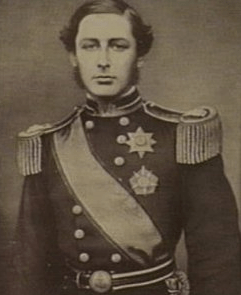
State Library of Victoria collection, 1867.
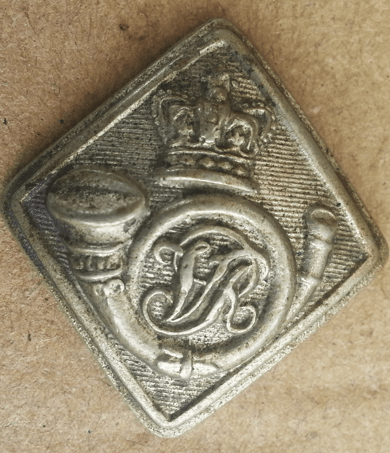
The dimensions along the axes are 26 x 28mm.
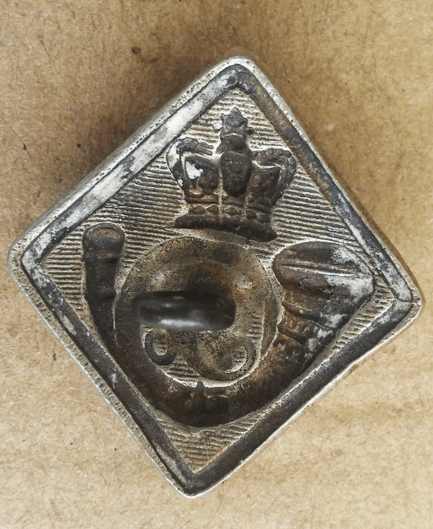

Empire (Sydney), 16th October 1868 page 1.
This full dress uniform was adopted in May 1870. A picture of the uniform button is seen on page 5 of J. K. Cossum’s book “Buttons of the Defence Forces in Australia”.
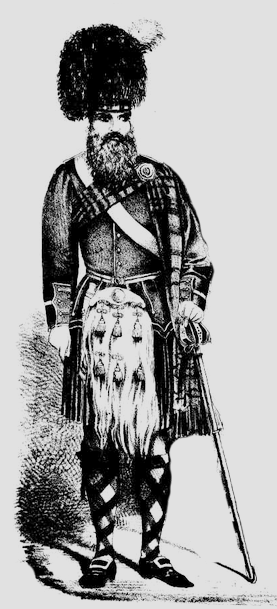
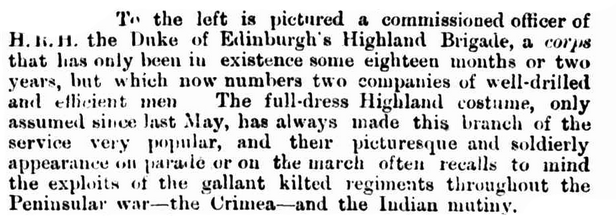
Illustrated Sydney News, 26th October 1870, from pages 2 and 8.
Dwindling numbers led to its disbanding in 1878. A new Scottish Regiment formed in New South Wales in 1885 in response to the Sudan War. This regiment existed until 1912 when existing units were absorbed into the new Citizen’s Army.
New South Wales Artillery: 1870-1880
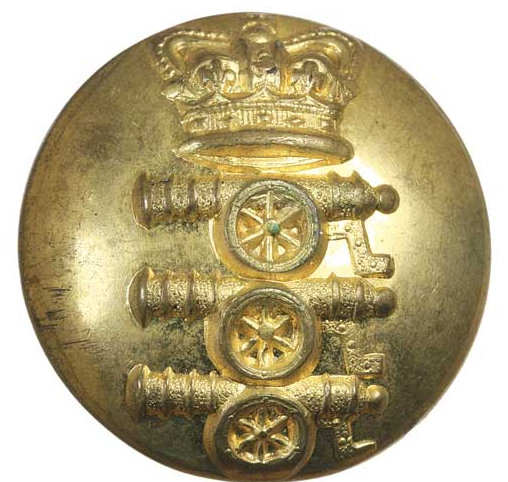
Thanks to Noble Numismatics: NSW Artillery 1870-80 by Smith Kemp & Wright, Birmm
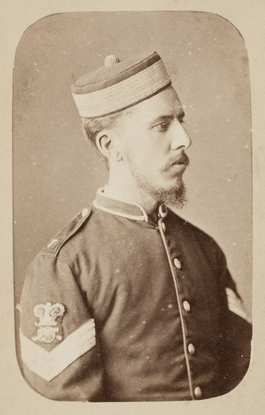
Library NSW IE3320792: Sergeant Major of the NSW Volunteer Artillery c.1879.
New South Wales Lancers: 1899-1903
Inaccurately, the New South Wales Lancers are often quoted as “the pioneer cavalry unit in Australia, and its history goes back to January 1, 1885, when it was formed under the title of the Sydney Light Horse.” Whilst it may be the oldest existing cavalry (now-a-days a motorised armoured corps), it certainly not the pioneer of Australia, let alone of New South Wales.
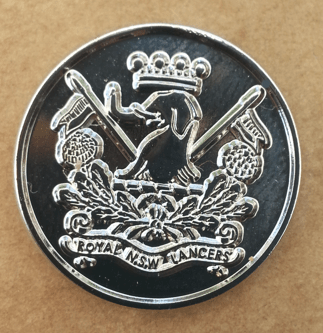
Replica Lancers badge
The “Russian invasion scare” following the Crimean War lead to the re-organisation of defence forces in all the colonies, and the raising of new corps, including, as mentioned, the Sydney Light Horse in 1885. It wore the uniform of the 10th Hussars.

New South Wales Government Gazette (Sydney), 13th January 1885 page 399.
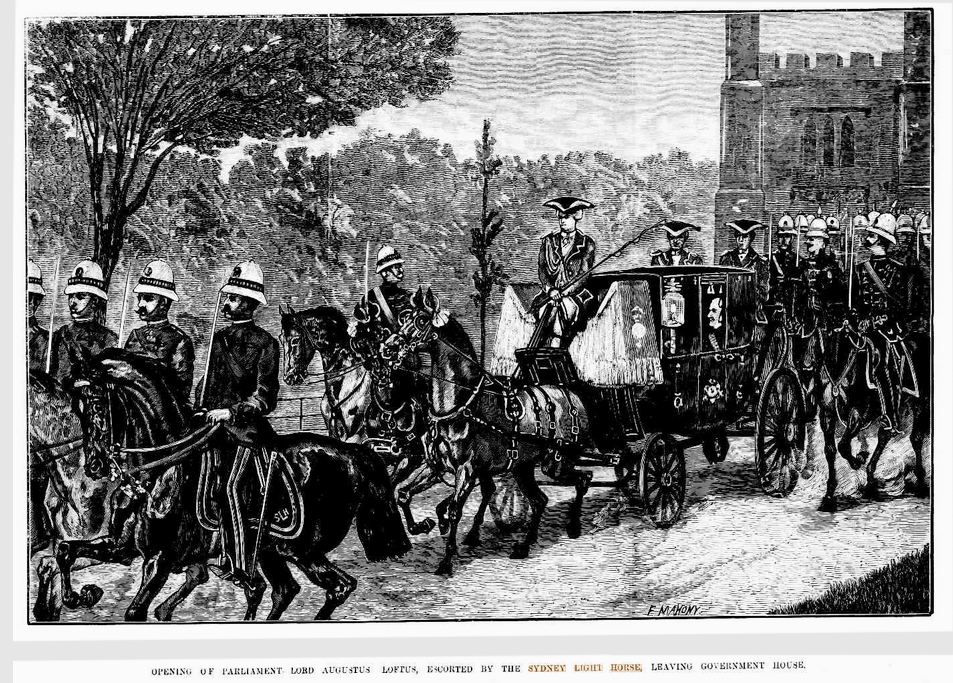
Illustrated Sydney News, 11th April 1885 page 13.
Its first public duty was to act as escort for the Governor, Lord Lucas, when the Soudan Contingent left Sydney that year. Later that same year the corps was changed to the Sydney Lancers (i.e. armed with sabres). In 1889 the eight light horse regiments that by then existed were integrated into the New South Wales Cavalry regiment, which was renamed the New South Wales Lancers in 1895. They existed until 1903, when as a result of Federation they became part of the Australian Light Horse. The Royal title was bestowed to the Lancers by King George V in 1935 on the occasion of his Silver Jubilee. The following year a reorganisation of the militia took place. Some units, including the Lancers, were changed to motorised machine gun regiments. The 1st/15th Royal NSW Lancers is the current incarnation of this regiment.
In 1899, a squadron of the Regiment, which had been training in England, became the first colonial troops to arrive in South Africa for active service against the Boers in the South African War. This squadron was reinforced by further drafts from New South Wales. A uniform from this campaign is shown below:
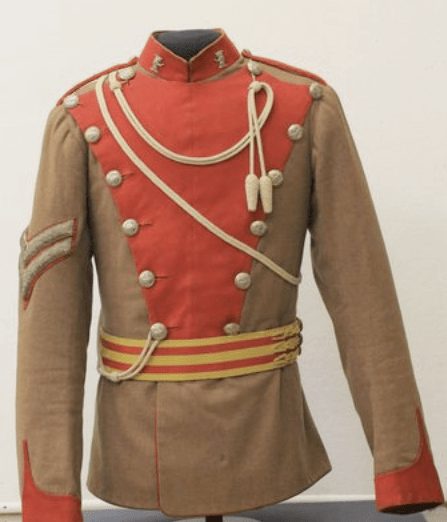
From the Australian Dress Register: The uniform of Otto Armbruster from Lismore, NSW.
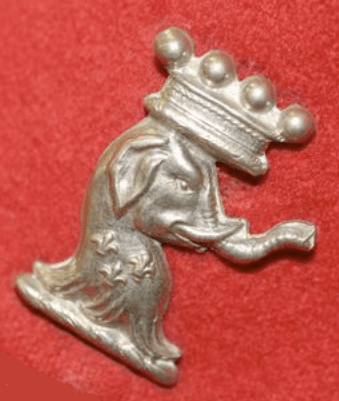
The collar badge of the NSW Lancers 1893-1903 was an elephant head. This comes from the crest of Lord Carrington who was Governor of N.S.W from 1885 until 1890 and honorary Colonel of the New South Wales Regiment from 1885.
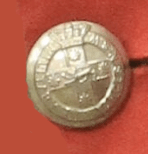
The buttons are the universal NSW Military Forces (1880-1901) design.
Note that although the Lancer’s collar badge is found on this uniform, the buttons are that of the New South Wales Defence Forces, not the button bearing the Carrington Crest as shown on the replica at the start of this article, and featured on page 6 of Cossum’s book. Cossum dates the regiment’s button to 1899-1903. The soldier who wore this uniform was one of the squadron who arrived at Cape Town in November 1899, straight from training in London; perhaps the regiment specific buttons were only then produced in an enthusiastic response to the unit’s involvement in the Boer War, and so were not found on this soldier’s uniform.
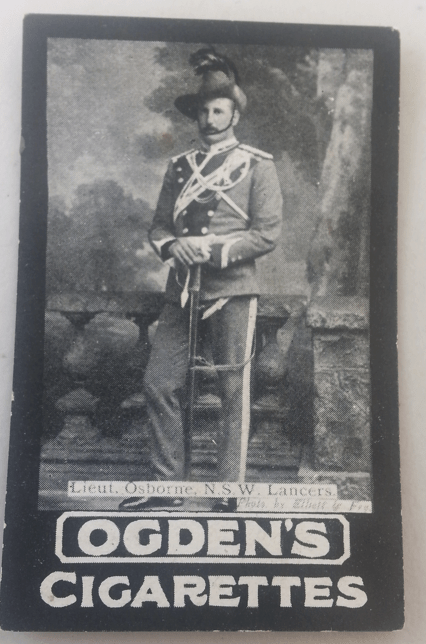
c. 1898-1901
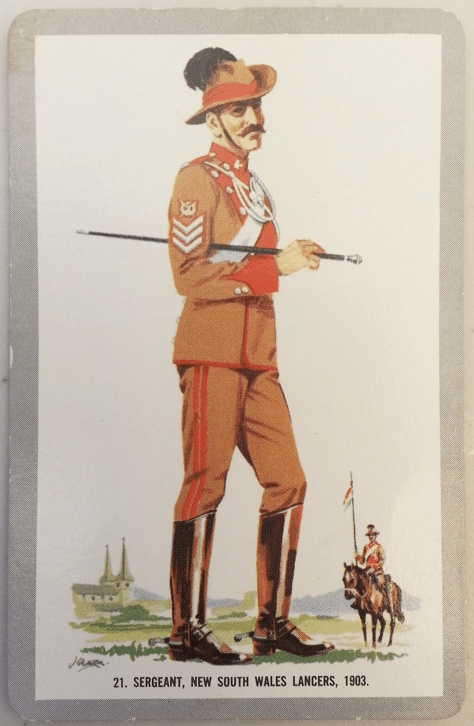
On the back of the card: “Undoubtedly the oldest cavalry regiment in Australia, the N.S.W. Lancers was formed in 1885 and named the Sydney Light Horse. The title was changed in 1894 to N.S.W. Lancer regiment, and this was one of the first to serve in the Boer War. The Regiment also was service in World War I and World War II.”
See also:
http://www.austbuttonhistory.com/9th-april-2021/
https://australiandressregister.org/garment/342/
https://en.wikipedia.org/wiki/New_South_Wales_Lancers_Memorial_Museum
New South Wales Military Force: 1871-1873
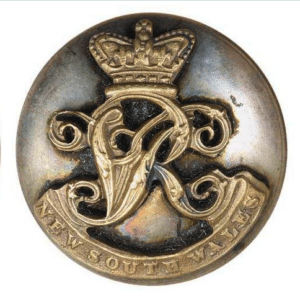
Image courtesy of Noble Numismatics. This is shown on Cossum page 5, and presumably was for the Permanent forces. In that case, they date from 1871-73.
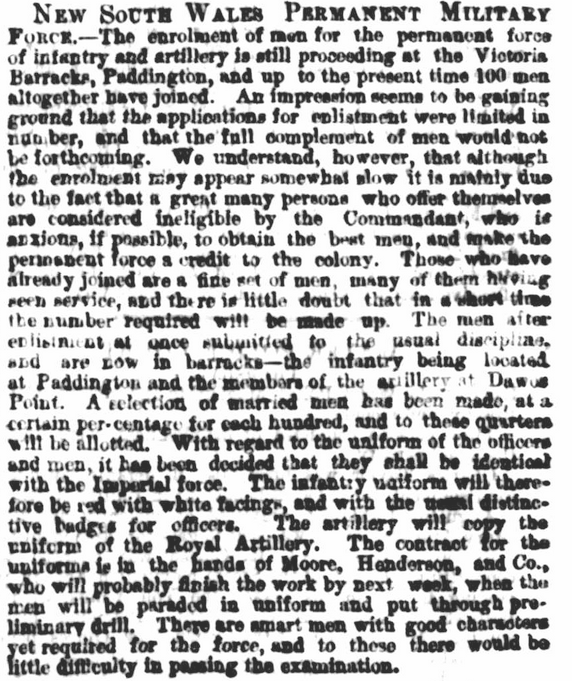
The Sydney Morning Herald, 18th August 1871 page 4.
Following the departure of the British units in 1870, the New South Wales government decided to raise its first Permanent Military Force (i.e. career/paid soldiers) consisting of two infantry companies and one artillery battery.The permanent infantry lasted little over a year as the government declined to continue funding; therefore the majority of New South Wales defence was still in the hands of volunteers.
New South Wales Military Forces: 1876-1902
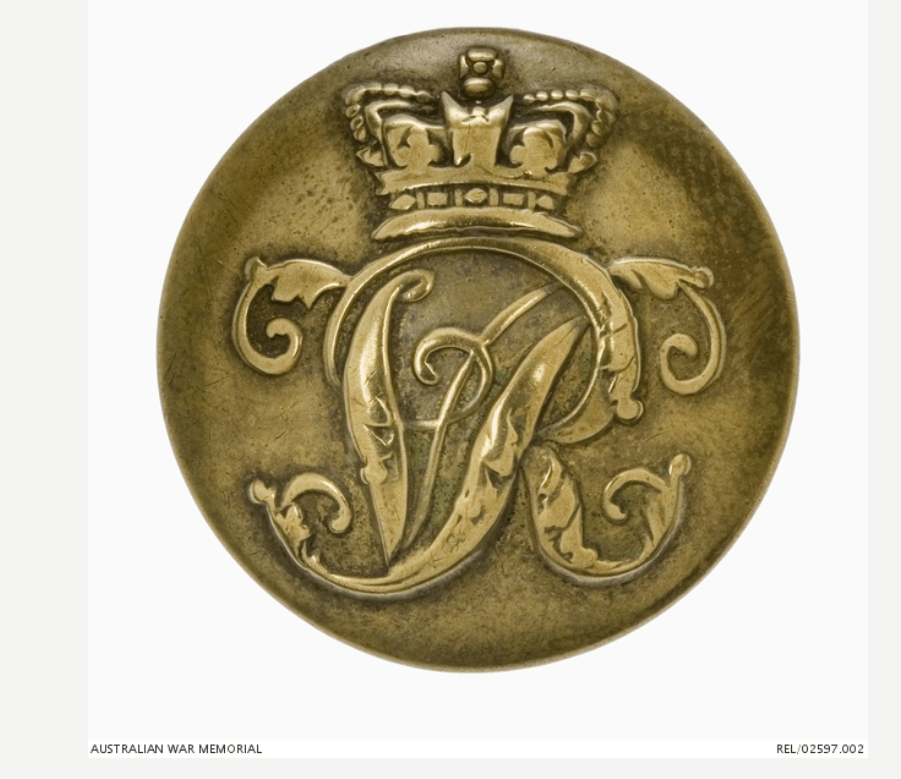
According to the AWM, this General Service button (1870-1880) was sewn onto a volunteers 1887 era tunic, but was removed and replaced with an appropriate silver button, as only permanent and partially paid (Militia) members wore gold coloured buttons and lace. Volunteers wore silver (white metal).
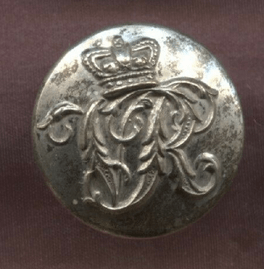
In 1876 the emblem of the New South wales Military Forces was declared; “a lion passant guardant on a cross between 4 stars of 8 points” with a Queen’s (Victoria) crown. The actual button may date from 1880.
In 1885 the New South Wales offered help to the British in Egypt after the death of the hero, General Gordon, and this help was accepted by the British. It was the first Australian Contingent to serve overseas. The flashy uniforms were replaced by safer and more practical khaki uniforms when they arrived in Egypt. The badge on the helmet carries the same design as the universal design of the the New South Wales Defence Forces, that of a British Lion on a St George Cross embossed with the stars of the Southern Cross. Experiencing only a limited amount of action, the campaign was abandoned and the forces brought home after only a couple of months and disbanded.
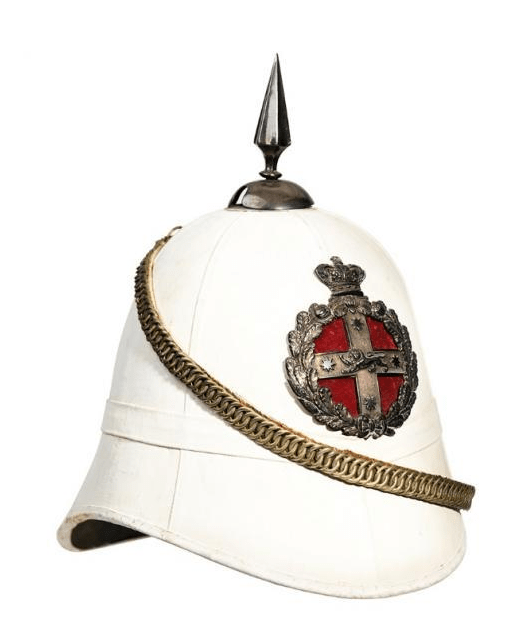
Anzac Memorial, Sydney collection: https://www.anzacmemorial.nsw.gov.au/collection/nsw-military-forces-foreign-service-helmet-c-1885
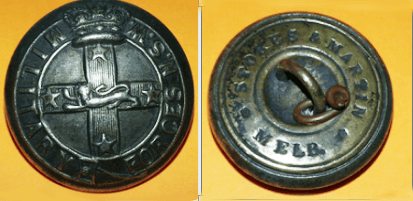
Stokes & Martin Melb. The 5 point star is a design error.
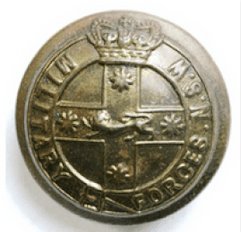
Made by C.Anderson, Sydney. This button has the correct 8 point star.
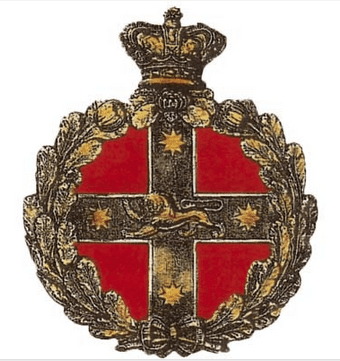
A NSW Military uniform badge.
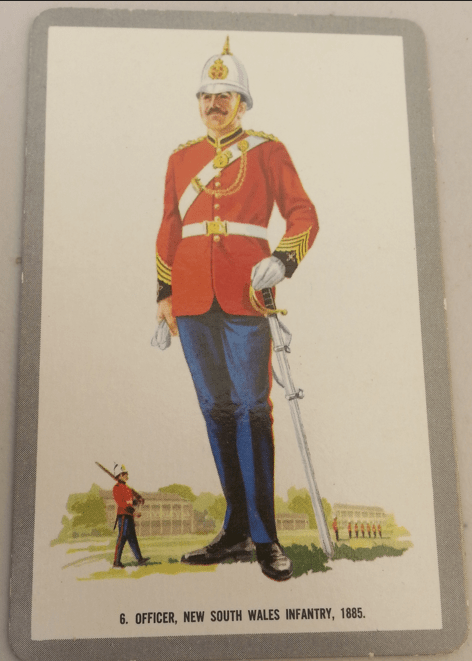
“A member of Australia’s first overseas expeditionary force sent to Egypt to assist the British forces in an attempt to recapture Khartoum. The contingent of some 734 volunteers, including 522 infantry, left Sydney on March 3, 1885. for the Sudan. They saw little action and returned on June 18 of the same year.”
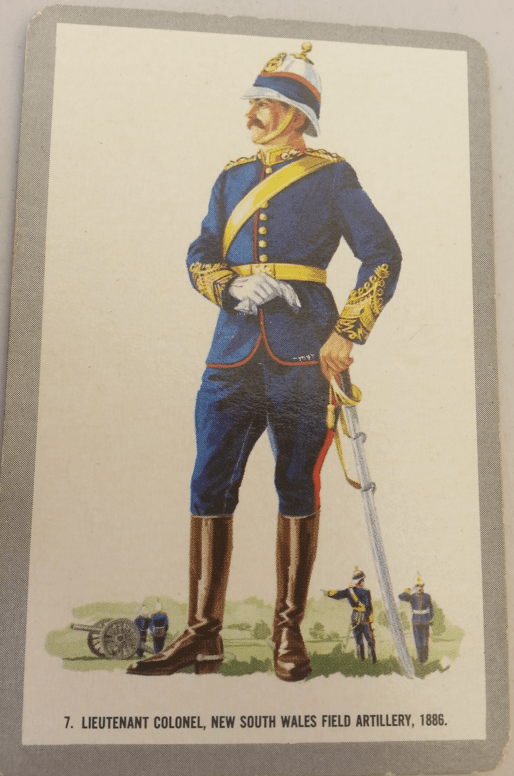
“The N.S.W. Artillery made its mark in history when, in 1885, 212 artillery men and six cannon embarked with the Sudan contingent. This officer’s uniform of suede cloth, with gold badge, button, and other apparel, designate him as being a permanent soldier, or regular. Volunteers wore silver badges and buttons.”
New South Wales Mounted Rifles: 1893-1902
The first volunteer group named the New South Wales Mounted Rifles existed only from 1860-1862.
The second so named regiment was formed in 1888 as the New South Wales Mounted Infantry, and renamed in 1893 as the Mounted Rifles.
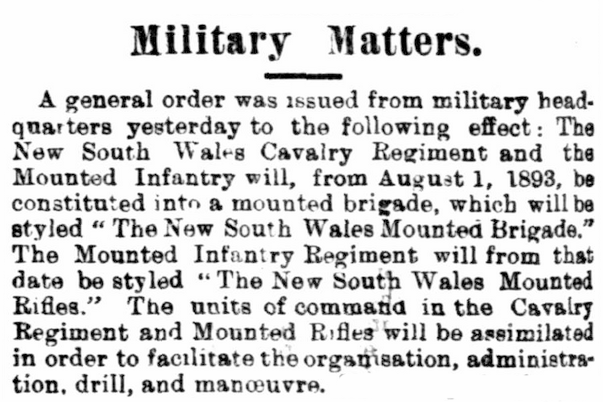
Evening News (Sydney), 20th July 1893 page 2.
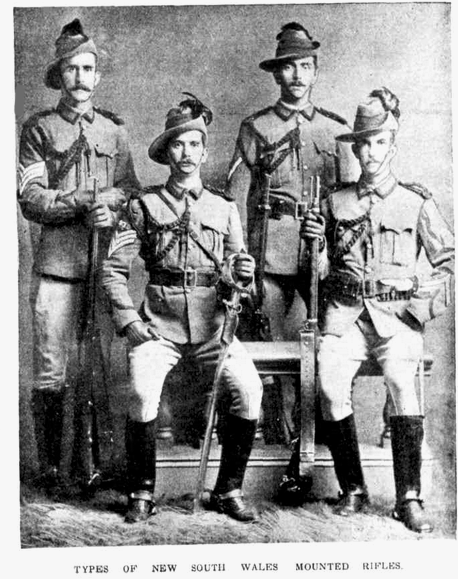
Weekly Times (Melbourne), 11th November 1899 page 3.
Several regiments would serve in the Second Boer War. Post war it became a Light Horse Regiment. After multiple re-namings and re-organisings, it was disbanded and merged into the new Royal New South Wales Regiment in 1956.
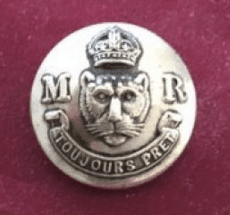
Paramatta Woollen Mills: courtesy Australian Militaria Sales. King’s Crown version.

The Paramatta Woollen Mills and C. Anderson both made these buttons. For interest I have included below a newspaper report of C. Anderson and the mills both winning a tender for military uniforms, including for the Mounted Rifles.
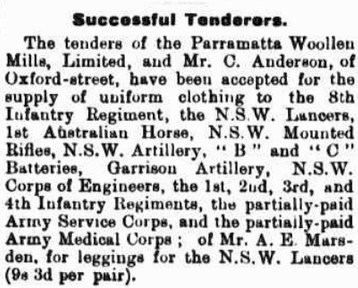
The Cumberland Argus and Fruit Growers Advocate (Parramatta) 15th February 1902 page 4.
The animal head depicted is that of a leopard, as described in the following article.
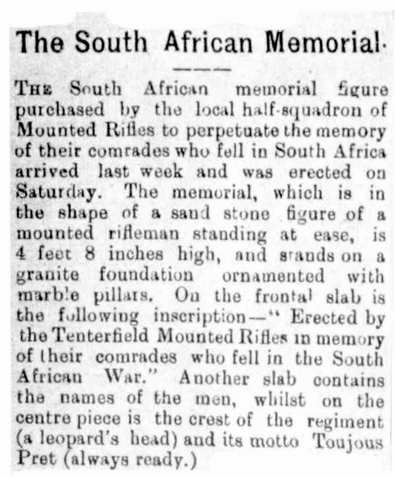
The Tenterfield Intercolonial Courier and Fairfield and Wallangarra Advocate (NSW), 31st March 1903 page 2.
On page 7 of Cossum is a 1902 (with a King’s Crown) version of the regiment’s button bearing a ‘rampant lion’ and the motto ‘Pro Rege’ (For the King) and the letters M. and R. I presume it is rare as it was only used for one year.
New South Wales Naval Brigade: 1863-1901 and Naval Artillery Volunteers: 1884-1901
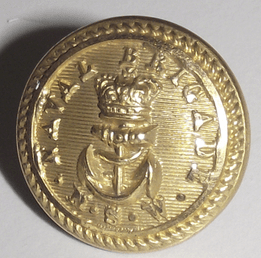
Royal Museum Greenwich: NSW Naval brigade button by Firmin. https://collections.rmg.co.uk/collections/objects/78143.html

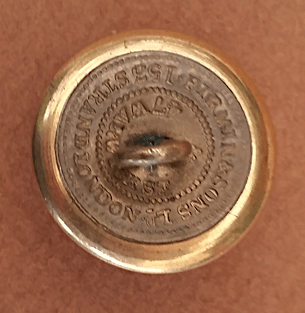
“Firmin & Sons Ld. 153 Strand & 47 Warwick St London. According to the UF DetectorFinds database: this dates from1880-1894.
There was a naval force of one ship, the HMCS Spitfire, from 1854-1859, despite the fact that until the Colonial Naval Defence Act of 1865. Australian colonies were not permitted to accquire warships, or raise naval forces. In 1859 she was gifted to the Colony of Queensland.
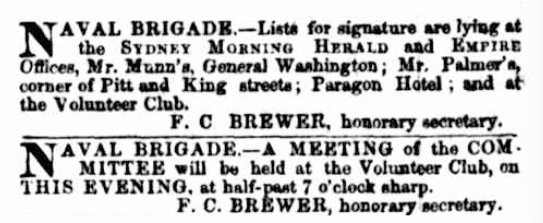
The Sydney Morning Herald, 4th November 1861 page 1. Initial steps were taken in 1861 to establish the brigade.
The lack of any sea-going ships was not enough to deter volunteers joining the newly established New South Wales Naval Brigade in 1863. It was not until the late 1870s that two ships were constructed in Sydney. However, they did have the use of the non-seaworthy HMS Woverine from 1882-1892 as a training ship upon Sydney Harbour.
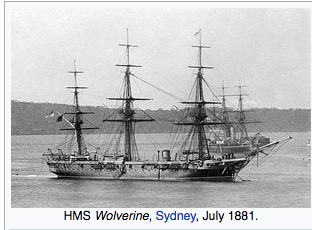
Photo from Wikipedia.
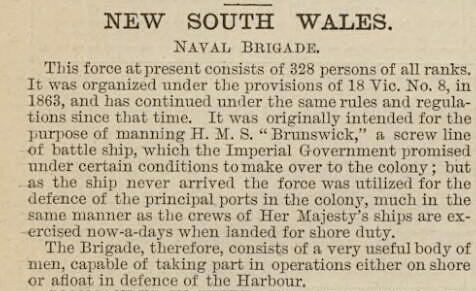
The Almanac of Australia and official record, 1882 page 92.
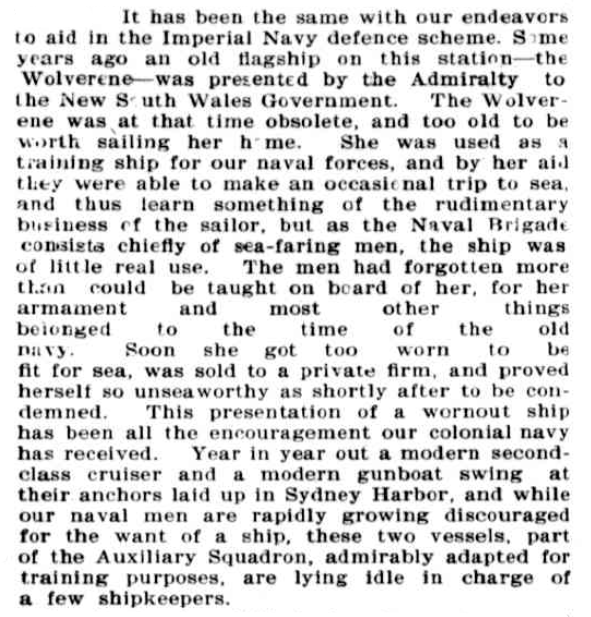
Australian Town and Country Journal (Sydney), 17th March 1900 page 31.
The artillery contingent of the New South Wales Naval Brigade went to Tientsin in China in July 1900 to help the British suppress the Boxer Rebellion, along with those from Victoria and South Australia.
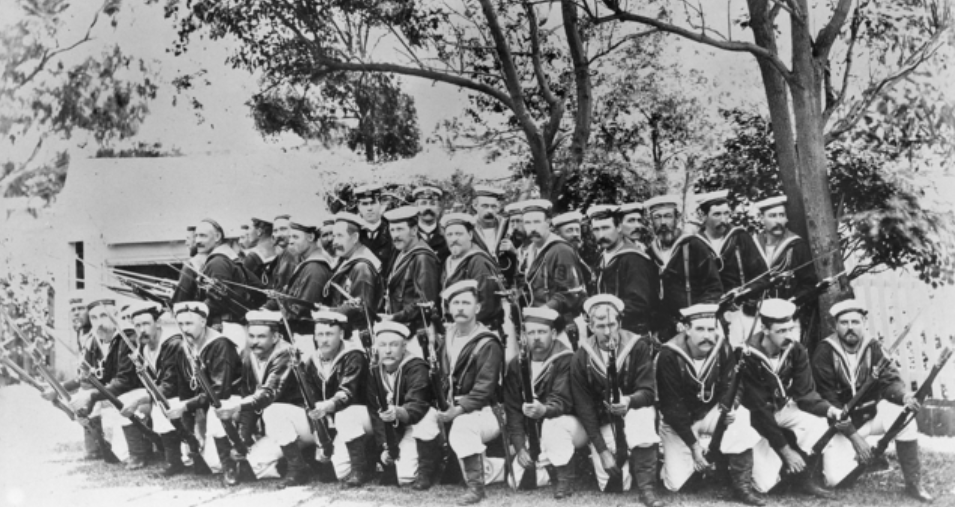
Australian War Memorial collection #306822. Group portrait 1900, Sydney, of the NSW Naval Brigade contingent to the Boxer Rebellion
There existed a “duplicate” force of Naval Artillery Volunteers from 1884 until 1901 when it was disbanded. They had also used the Woverine for training. A newspaper article claimed there was “a great deal of friendly rivalry between the two forces.”
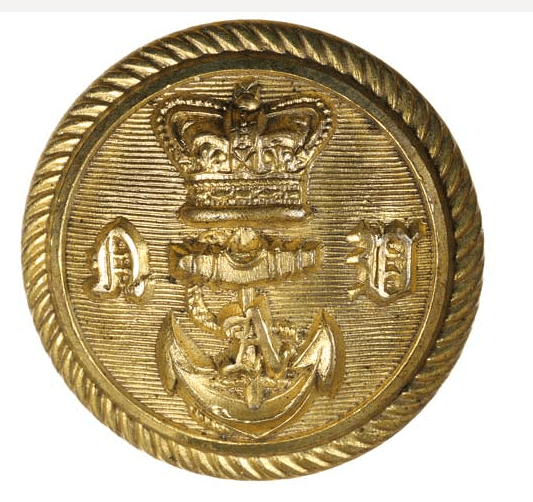
Thanks to Noble Numismatics: Naval Artillery Volunteers c.1890 by W.Jones & Co, 7 Golden Square London.
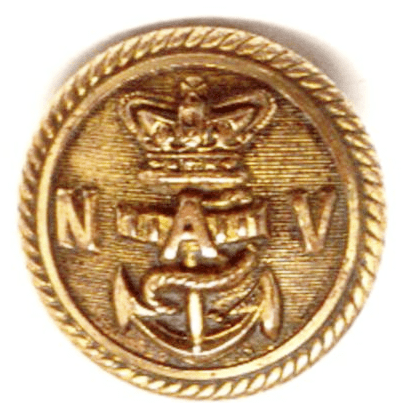
Australian National Maritime Museum collection.
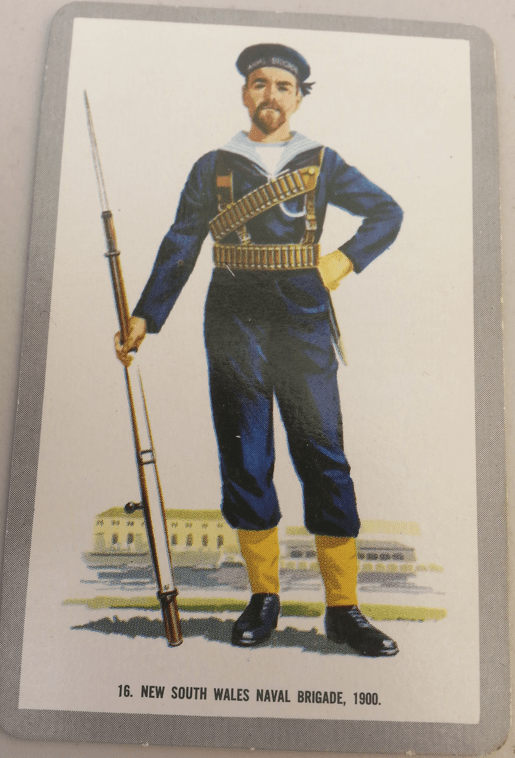
“N.S.W. formed its Naval Brigade in 1861. In 1900 the N.S.W. and Victorian Governments sent Naval Brigade contingents to China to help quell the Boxer Rebellion. This rating is fully equipped for that expedition. In 1901 Australia became a Commonwealth, and naval forces, like the military, came under Federal control.”

The Year Book of New South Wales 1904, page 162.
New South Wales Volunteers: 1860-1870
Following after the 1st New South Wales Rifles of 1854-1860, new volunteering units were formed.
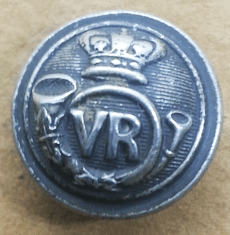
Firmins London

Courtesy of Noble Numismatics.
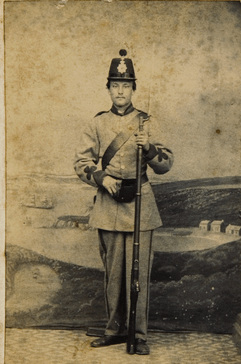
Sydney Living Museum collection: Private John Joseph Shying, No 5 Company Sydney Battalion Volunteer Rifles, c.1863
With the withdrawal of many of the British soldiers to fight in the “Maori Wars” (now known as the Land Wars) in New Zealand, there was a renewal of interest in raising volunteer corps. Disappointed after years of failed attempts to get government support for the 1st NSW Rifles, its Major, Thomas Wingate, resigned to pave the way for a new corps. He was aware that the new volunteers had differing ideas and aims to his own.
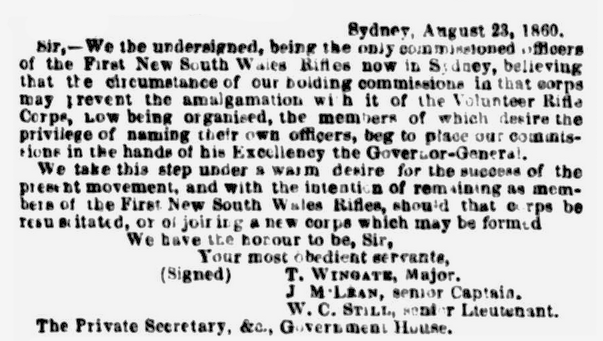
The Sydney Morning Herald, 27th August 1860 page 8.
Indeed, from August that year several new volunteer corps were being established, with members of the original 1st Volunteer Rifle Corps (described by some as “moribund”) invited to join with the new proposed Sydney Corps. The government agreed to the use of part of the Hyde Park Barracks.
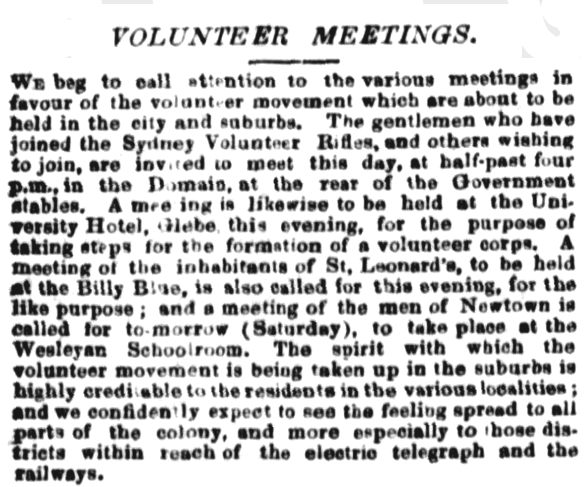
Empire (Sydney), 31st August 1860 page 5.
Twenty rifle companies were together designated the ‘First Regiment, New South Wales Volunteer Rifles’. According to https://www.rnswr.com.au/wp-content/uploads/2015/07/THE-LINEAGE.pdf “a change in uniform was made, the newly adopted uniform being grey with black facings (the black facings referred to were suggested for the Penrith Company of Volunteers in June 1860, the first such group raised in the Sydney area), an infantry shako and a brown belt”. However, these descriptions were reported in newspapers in 1861:

Empire (Sydney), 20th May 1861 page 4.

Sydney Mail, 24th August 1861 page 3.
New South Wales Volunteers: 1870-1880
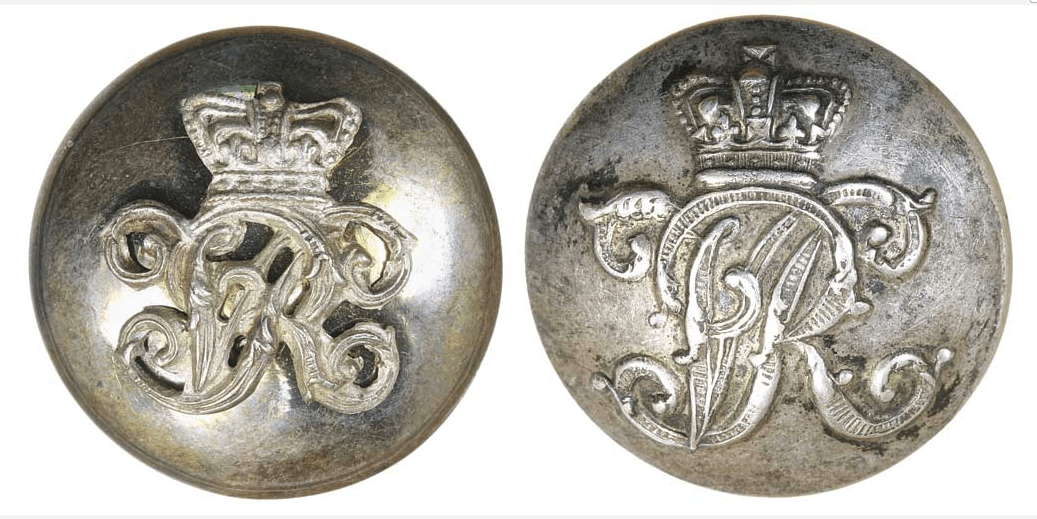
Thanks to Noble Numismatics. 2 versions of the General Service button of the NSW Volunteers 1870-1880.
The New South Wales Military Forces were created in 1870 after the withdrawal of British forces from the colony. Colonial uniforms followed the style of the British, including the helmets and red and blue uniforms.
Newcastle Volunteer Artillery Corps: 1856-1887
This corps button the same basic design as many artillery uniform buttons, with one field gun facing left, ; but with the letters N V A C above. An example is shown on Cossum page 8, labelled as from c.1875 with the backmark Stokes Maker, Melbourne. The Newcastle Volunteer Artillery Corps existed from 1855 through to 1887. However, the backmark ‘Stokes Maker’ dates the manufacture prior to his partnership with George Martin, i.e. pre 1867, otherwise it would be marked Stokes & Martin.
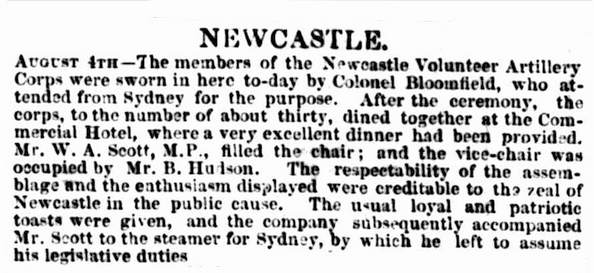
The Sydney Morning Herald, 6th August 1856 page 4.
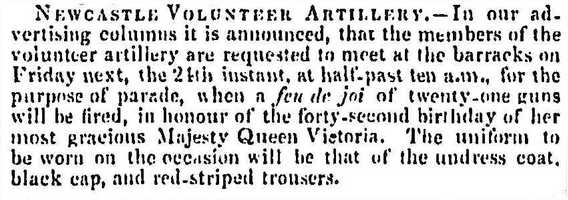
The Newcastle Chronicle and Hunter River District News (NSW), 22nd May 1861 page 2. The corps only had an ‘undress’ uniform, which they had to provide for themselves. The coat was a scarlet tunic with dark blue facings, with a badge depicting the letter ‘N’ for the shoulder straps.
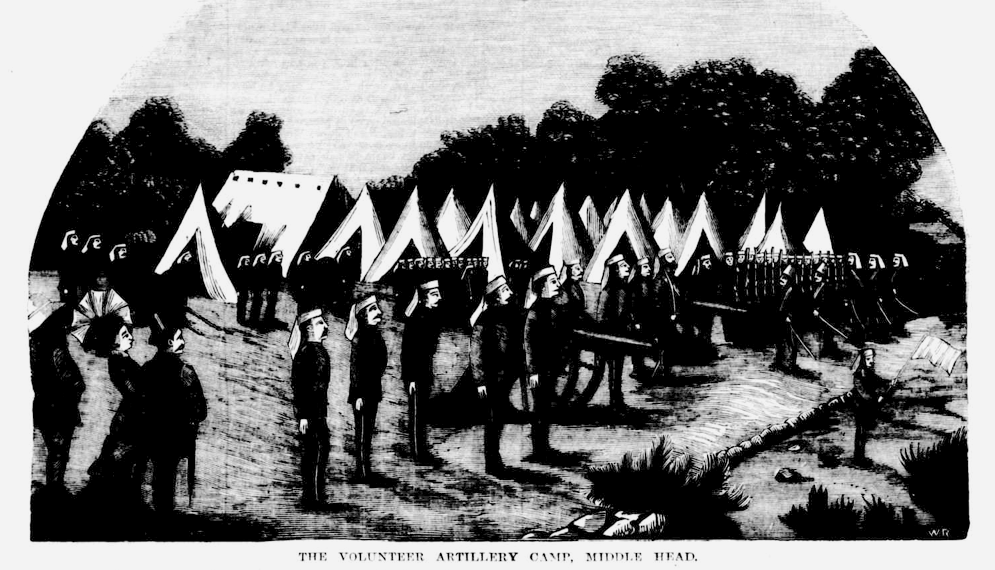
Australian Town and Country Journal (Sydney), 19th April 1879 page 32. New government regulations required yearly training camps. This illustration of volunteer artillery is not of the Newcastle division in particular, but they did attend.
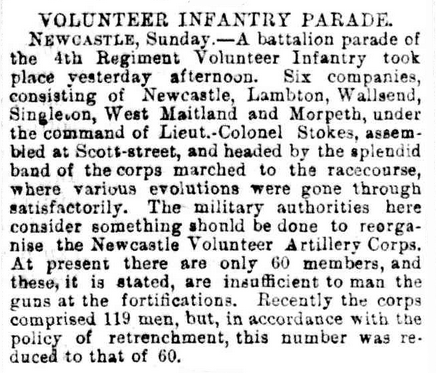
The Daily telegraph (Sydney), 10th October 1887 page 5.
For more about this regiment, see
1st Australian Volunteer Horse (NSW): 1897-1903
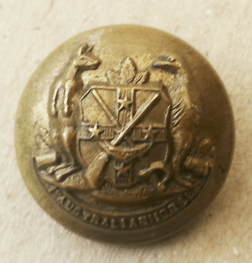
Hobson & Sons Lexington St. London
The 1st Australian Volunteer Horse were gazetted in New South Wales on the 1st August, 1897.
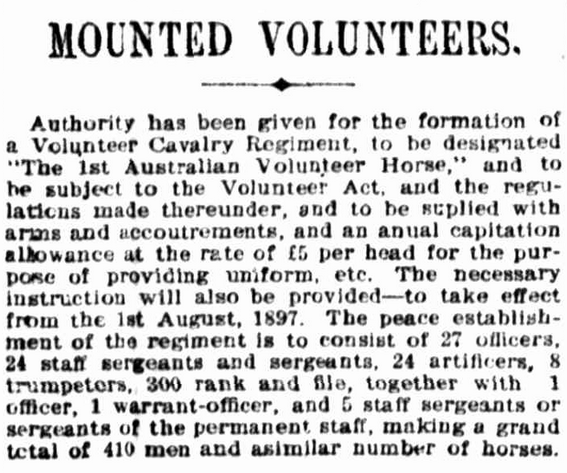
The Australian Star (Sydney), 6th August 1897 page 5.
This cavalry served during the Boer War and was the source for a number of recruits for the new Australian Flying Corps during World War 1.
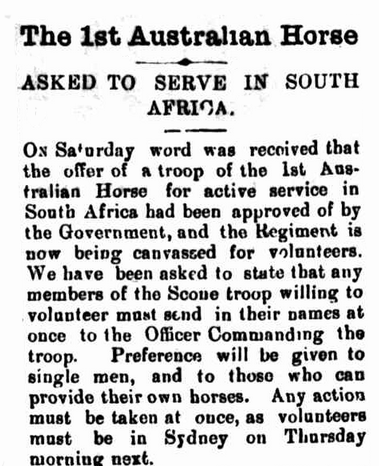
The Scone Advocate (NSW), 24th October 1899 page 2.
1st New South Wales Rifles: 1854-1860
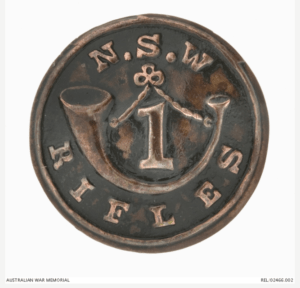
Australian War Memorial. No makers mark. 1854-1859
Apart from short lived volunteer associations in 1804-9 that help quell the Irish convict rebellion, this was the first government enacted Volunteer Force, developed in 1854. It was intended to be used in case of internal insurrection or foreign invasion, as the size of the British garrisons were limited, and included a cavalry in a scarlet uniform, artillery in blue and infantry in dark green. The first infantry was briefly known as the Sydney Volunteer Rifles. The original uniform consisted of a dark green frock coat and trousers with black velvet facings and shoulder straps, a forage cap, with the numeral 1 and a bugle as a badge. It performed guard duty at the Sydney mint, and occasional ceremonial duties.
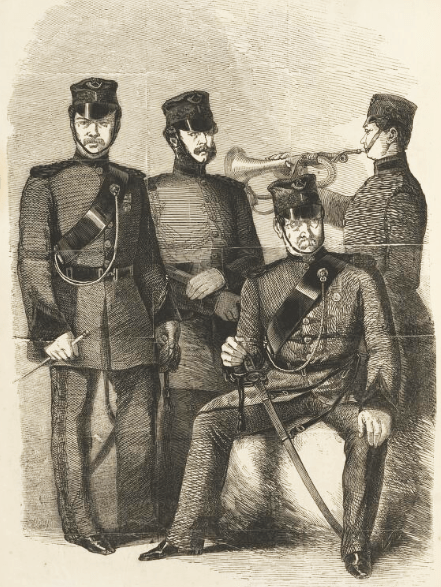
1857: Officers of the Sydney Volunteer Rifle Corps. (from ‘The Australian picture pleasure book.” in the National Library.
See http://www.austbuttonhistory.com/uncategorized/19th-october-2020/
Queensland
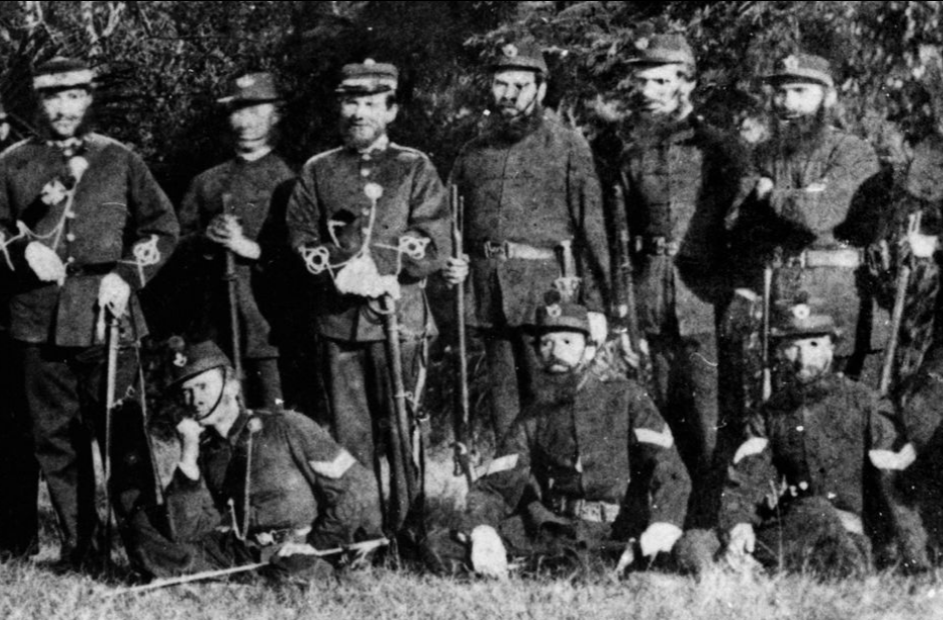
Queensland State Library. detail of Members of the Spring Hill and Fortitude Valley Volunteer Rifle Corps, ca. 1868.
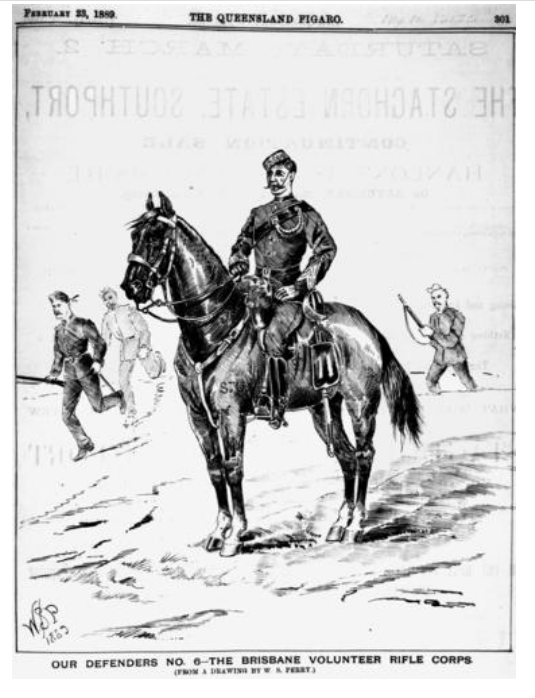
Queensland Figaro, February 1889.
Her Majesty’s Queensland Navy: 1885-1901
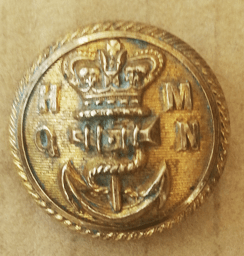
Backmark: W. Jones, & Co. 7 Golden Square London
See also https://www.gayundah.info/
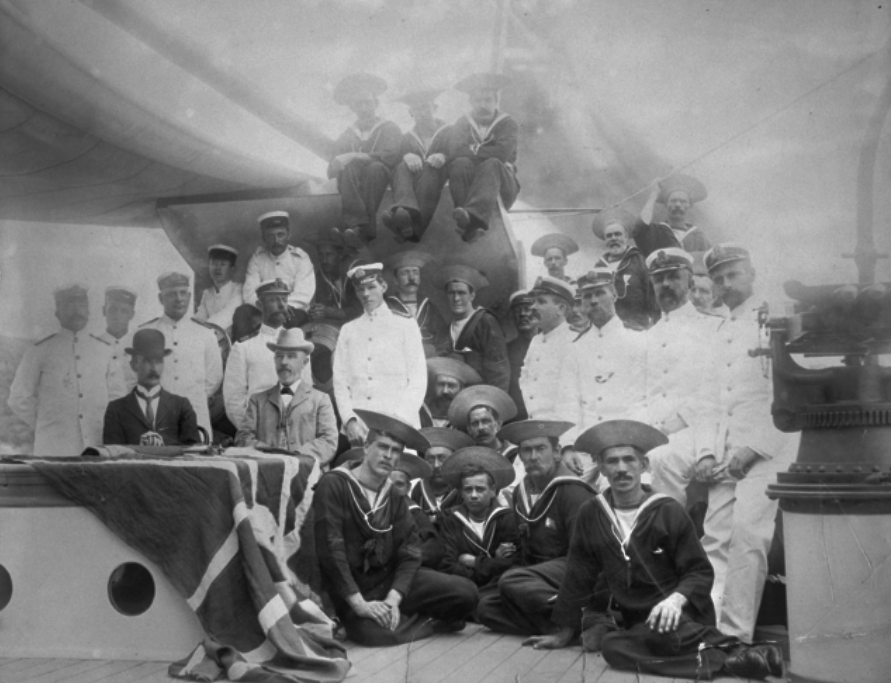
Australian War memorial image #P0044.129. Crew of H.M.Q.S. in 1898.
The H.M.S. Spitfire was a wooden gun boat, launched around 1855; the first warship built in Sydney, Australia. It was presented to Queensland in 1859 as a gift for its separation into a independent colony. However, it was not considered necessary for the colony to have a naval service at that time.
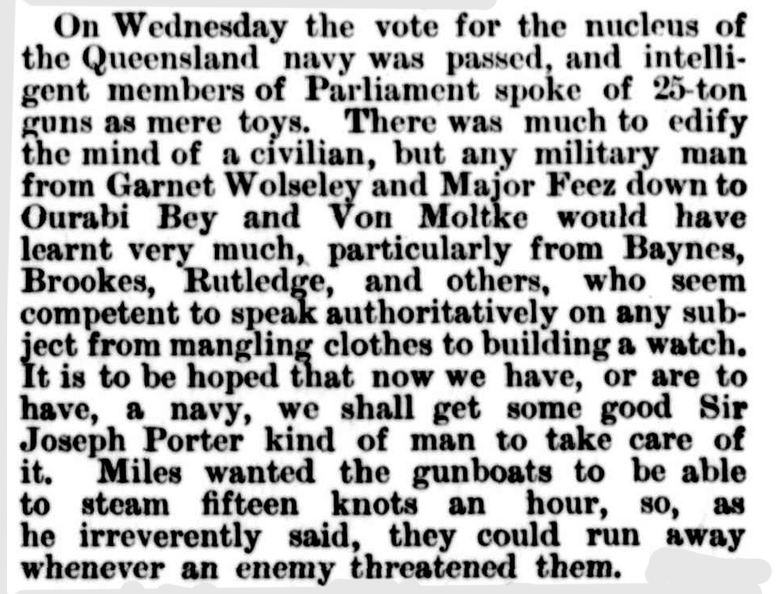
The Queenslander, 4th November 1882 page 616. A sarcastic report about the start of the naval brigade.

The Queenslander (Brisbane), 28th February 1885 page 325,
The Queensland Maritime Defence Forces was initiated in 1883. The gunships Paluma and Guyundah (aboriginal for Thunder and Lightening) arrived in the colony in 1885 to patrol Queensland’s coast. After Federation they were integrated into the Royal Australian Navy. Guyundah was beached in 1958 at Picnic Point as a breakwater.
Queensland’s fleet grew to be second only in size to Victoria’s. At Federation the naval forces numbers about 750, with 250 cadets.
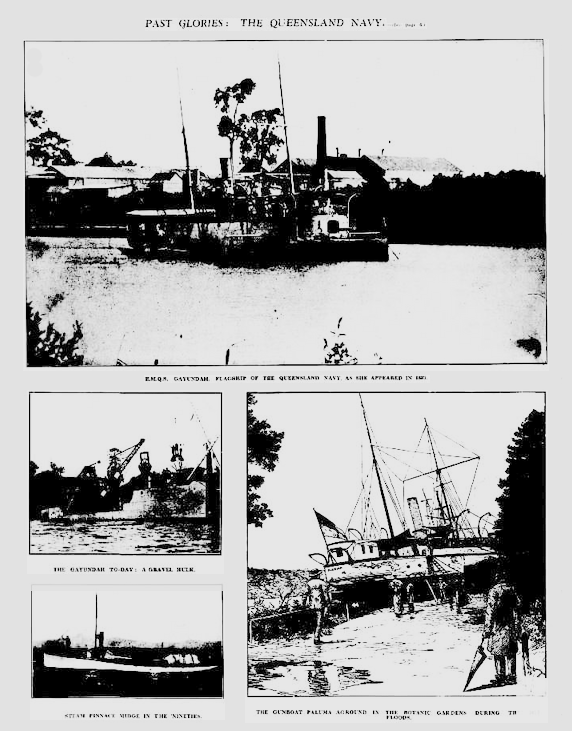
The Queenslander, 7th February 1929 page 35. Clock wise from top: HMQS Gayunda in 1899. Gunboat Paluma aground during floods in 1893. Steam Innace midge in 1890s. Gayunda as a gravel hulk in 1929.
Queensland Defence Forces: 1885-1901
http://www.austbuttonhistory.com/uncategorized/18th-october-2020/
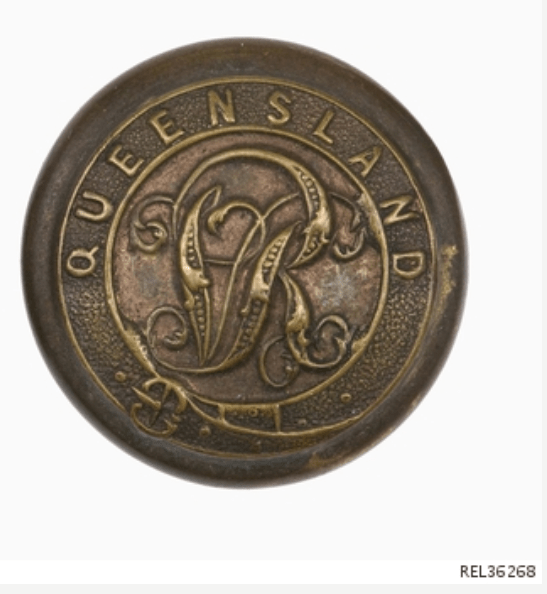
From the Australian War Memorial Collection. Made by Hobson and Sons, London circa 1885-1901.
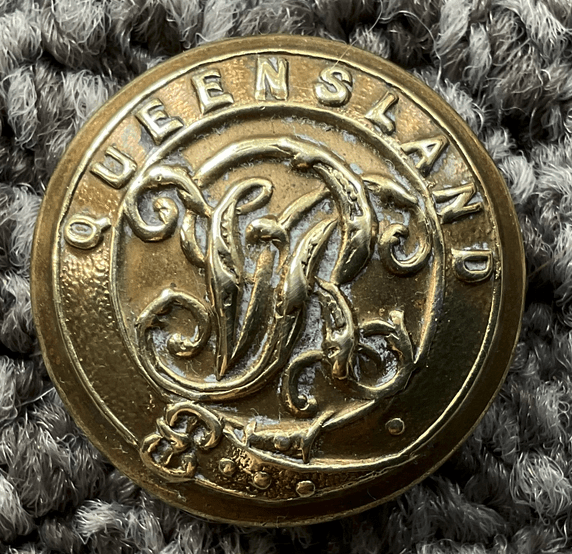
Hebbert & Co. London
The Defence Act of 1884 stated that the Government would now be providing a uniform. A small permanent force was raised in March 1885 with the new uniforms finally ready in March 1885.
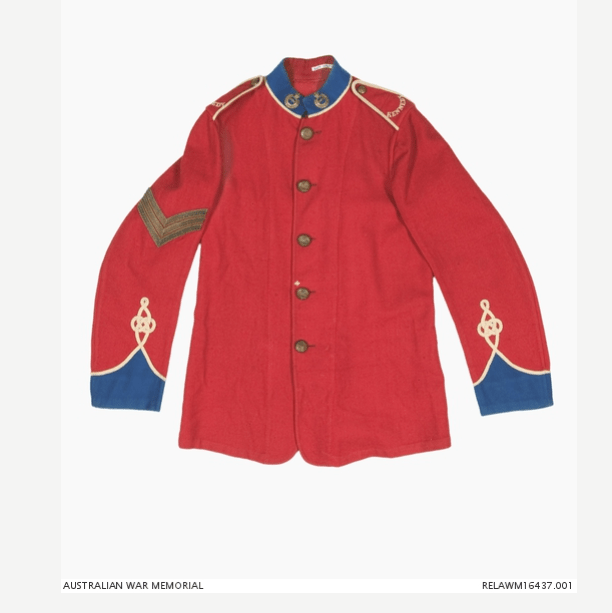
AWM. Segre frock of a sergeant in the Queensland Defence Forces. This style uniform of scarlet with 5 buttons was introduced in 1890.
Queensland Permanent Artillery: 1885-1900

Thanks to Noble Numismatics. Queensland Permanent Artillery 1885-1901.
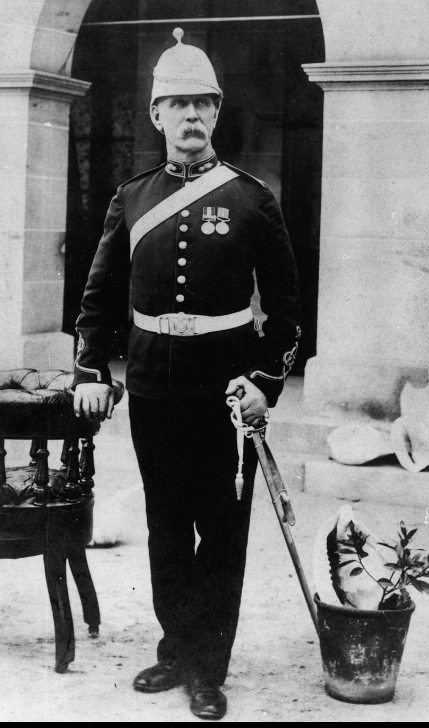
Staff Sergeant Gorman of the Permanent Artillery. Nice props for the photo, especially the conch shell in the pot plant!
In common with other colonies at that time, a Defence Act was passed in 1884, then a permanent artillery established in Queensland in 1885. In 1899-1900 the name was changed to the Queensland Regiment, Royal Australian Artillery.
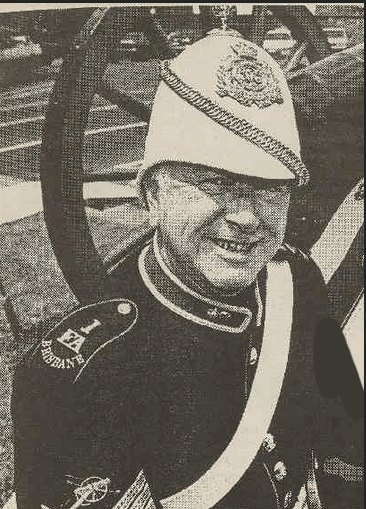
Army (newspaper), 9th February 1995 page 7. Wearing the 1893 uniform of the Queensland artillery.
Queensland Rifle’s (Volunteers): 1897-1901
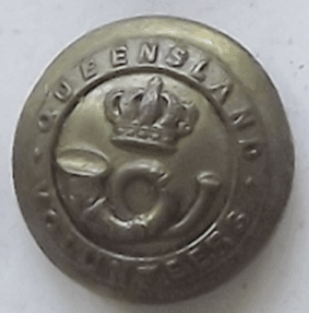
1897-1901. The crown used on button on the left is Prince Albert’s Crown, the Guelphic Crown of the Dukes of the House of Hanover.
It was on the advice of Colonel French in 1884 that standard new uniforms in khaki were introduced with new buttons struck bearing the word ‘Queensland’ . He stated that “The Royal Artillery buttons can be used for the batteries here, but in the event of the Imperial Authorities not having general service buttons (VR under a crown) it will be necessary to have a die made and buttons struck off for the other corps.”
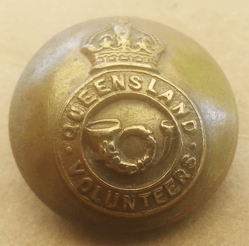
See Cossum page 22. 1902-3
This button dates from the short period between King Edward VII adopting the ‘Tudor’ crown and the amalgamation of the separate colonial forces into a federal service. The separate forces existed up to 1911 in the State of Queensland. After 1903 a button with Edward VII cypher replaced this one.
A photo in the State Library of Queensland collection shows the earlier VR type button of the Queensland Volunteers (see Cossum page 23).
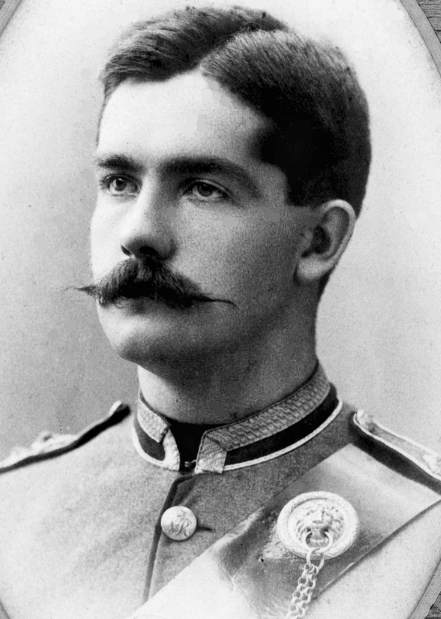
Lieut. Dowse, Queensland Volunteer Rifles , 1889. He is wearing an older style VR button.
Queensland Scottish Volunteer Corps: 1885-1897
In 1885 a Queensland Scottish Rifle Volunteers corps was established in Brisbane. By 1888 their strength was 335 of all ranks. Their full dress uniform was the same as that worn by the Gordon Highlanders (Her Majesty’s 92nd).
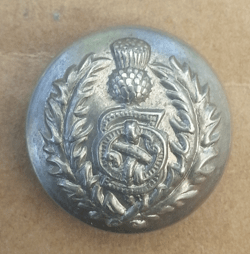
Backmark: H.W. Martin London. 1885-1897.
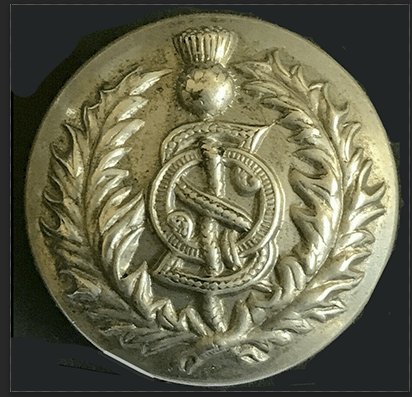
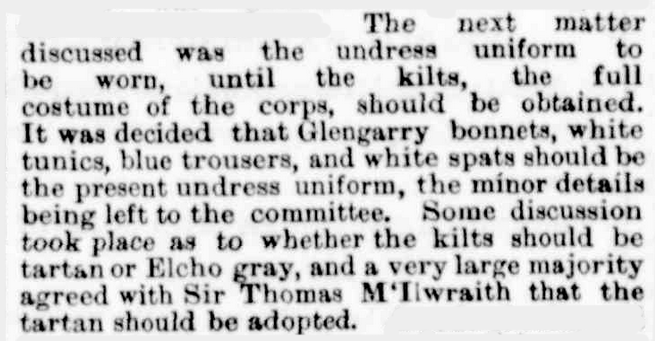
The Brisbane Courier, 16th May 1885 page 5.
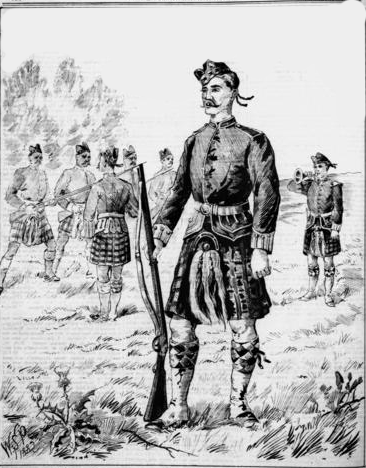
The Queensland Figaro, January 1889. A member of the Queensland Scottish Rifles.
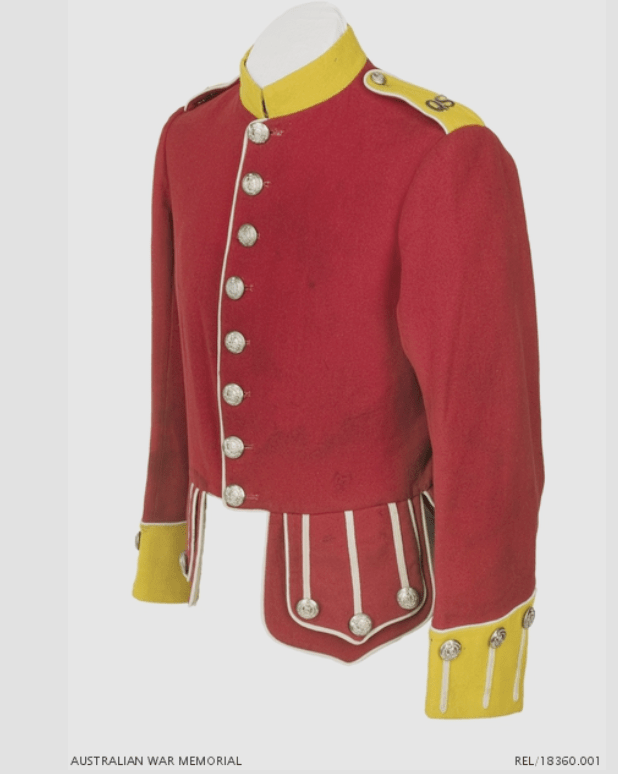
Australian war memorial
#REL/18360.001
By 1896 the corps had dwindled. It was briefly revived in 1897.
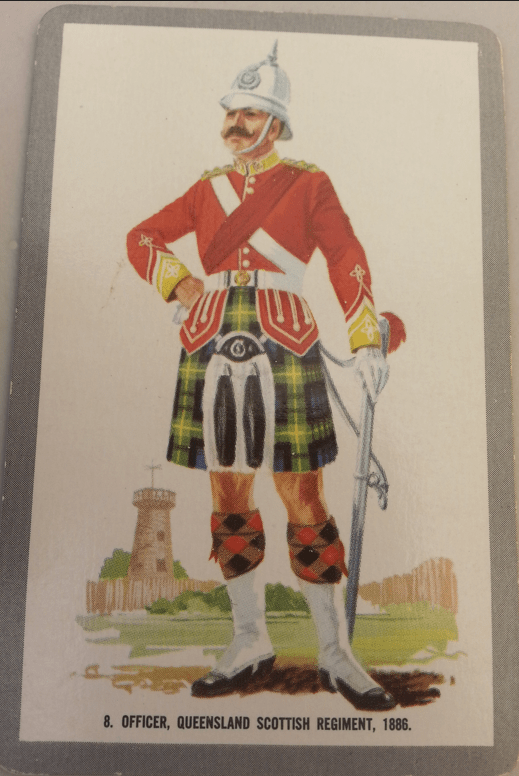
“Undoubtedly the Queensland Scottish Regiment was one of the most colourful of the Australian Pre-Federation Scottish regiments, the white Soudan spiked helmet and scarlet tunic giving it a very distinctive look. The officer illustrated is of the 1886 period, although the Soudan-type helmet was worm until 1905.”

“When Queensland became a state in 1859 it organised infantry, artillery, engineers and mounted rifle regiments, supported by a small naval force. Volunteer contingents of Imperial Bushmen and Mounted Rifles from Queensland fought in the Boer War. This soldier is a gunner of the Queensland permanent artillery.”
Queensland Volunteer Artillery: 1862-80
This button on Cossum page23 has the letters Q.V.A. beneath a left facing field-gun.
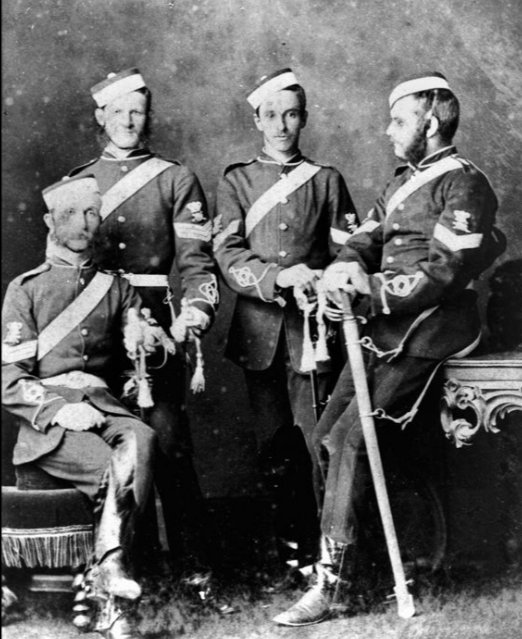
Queensland State Library: seargents from the 1st Queensland Volunteer Artillery.
South Australia
http://www.austbuttonhistory.com/uncategorized/16th-november-2020/
Her Majesty’s Colonial Navy: 1884-1901
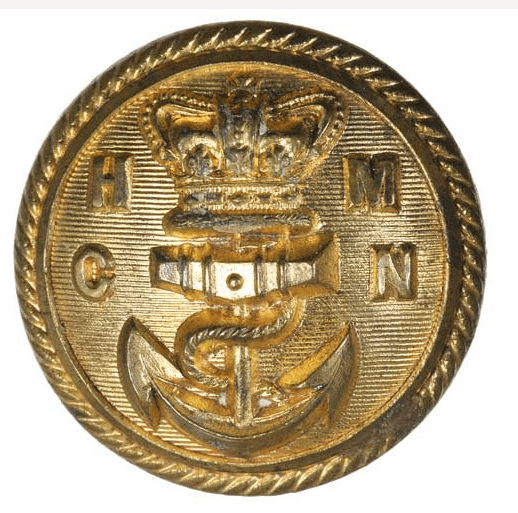
Her Majesty’s Colonial Navy (South Australia) c.1899. See Cossum page 55.
See http://www.austbuttonhistory.com/uncategorized/16th-november-2020/
South Australian Artillery.

The South Australian Volunteer and Permanent Artillery used this generic artillery button. In a 1925 “Army Historical research” article, it was described as used by Artillery, Machine Gun Corps, and Artillery (permanently employed), 1895-1903″.
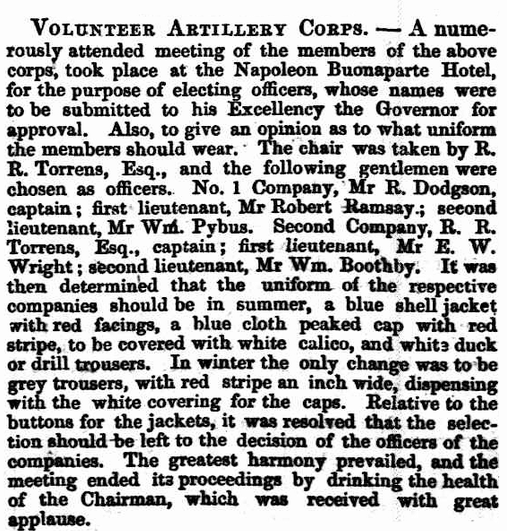
Adelaide Times, 8th November 1854 page 3. The establishment of the colony’s first artillery. It was referred to as the Adelaide Volunteer Artillery and consisted of two companies.
South Australia’s artillery had its origins in the two each 6 pounders, 12 pounders and Cohorn mortars sent from Britain and arriving in 1846. During the time of the Crimean War, a small force of artillery was raised. There was almost no training, and the artillery was required to do little except fire a shot at Port Adelaide to mark noon. Further guns arrived from Britain in 1857.
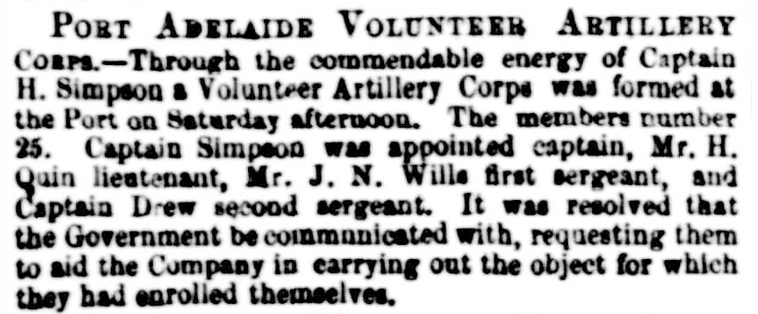
South Australian register, 11th July 1859 page 3.
Increased concerns about the French prompted the formation of the Port Adelaide Volunteer Artillery during 1859, although an international shortage of of artillery prevented a build up of equipment. The Adelaide and Port Adelaide corps were merged in 1868 to form the South Australian Regiment of Volunteer Artillery, only to be un-merged in 1877 as the A and B Batteries with an increase in armaments. That’s politics for you.
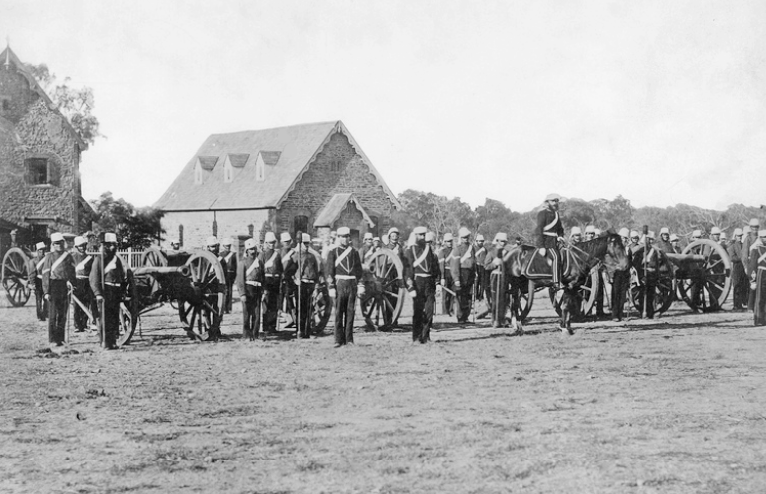
State Library SA # B 292. Adelaide Battery in 1877.
A Permanent (paid) artillery was raised around 1883, and a Machine Gun Corps in 1894. A fort at Glenelg was planned, but came to nothing, with two guns left dumped in the sand. These two batteries were (again) merged as the South Australian Artillery Brigade in 1897.
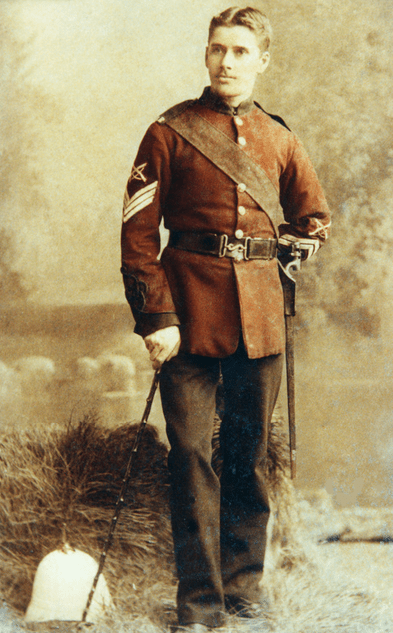
State Library SA #PRG 1364/1/17. Dress uniform Australian Field Artillery c. 1890.
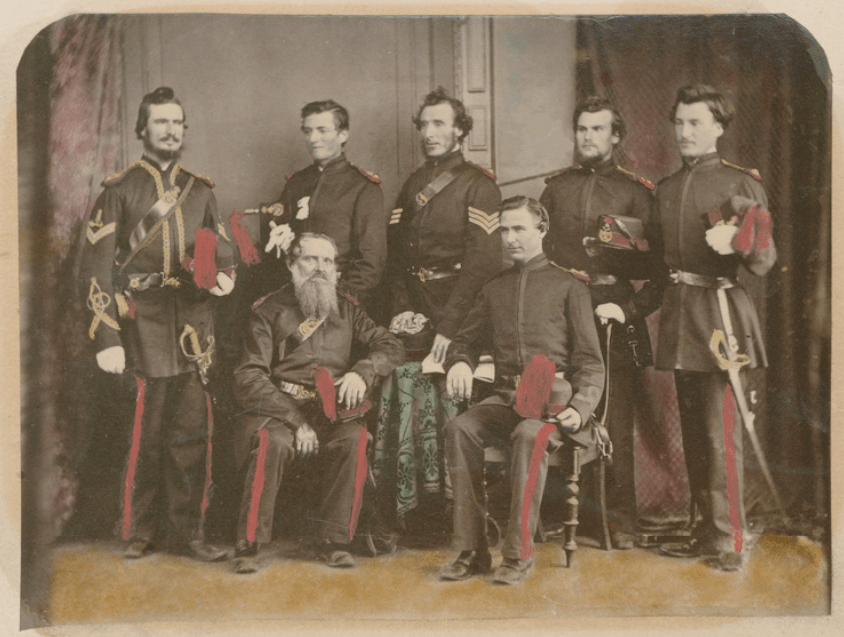
State Library SA B 13237. Possibly Adelaide Artiilery (Battery B) c.1877.
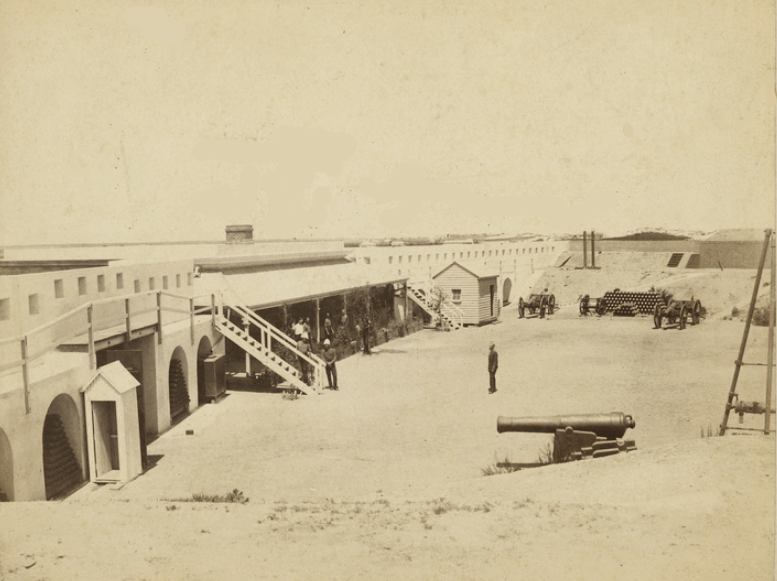
State Library SA # PRG 742/5/91. Port Glanville c.1882.
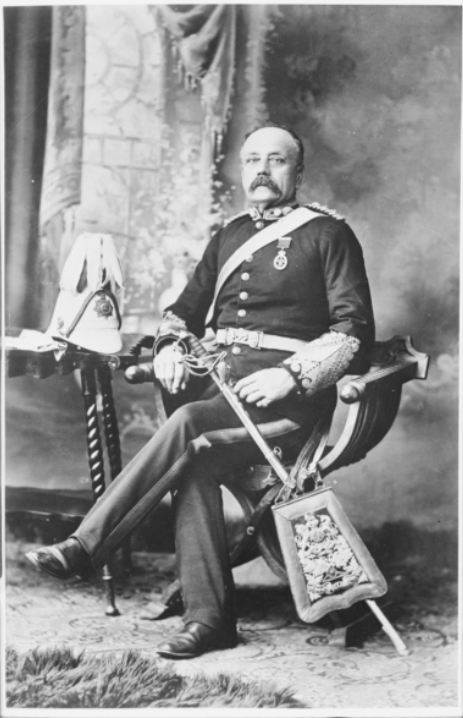
Australian War Memorial #AO 3852. !901 portrait of an un-named Colonel of the SA Artillery.
South Australian Militia
South Australia’s military forces did not really exist in a stable, ongoing sense until 1877, with the successful reformation of 10 companies of Adelaide Rifles and a couple of artillery batteries. In 1885 a second infantry battalion was reformed (having previously been started then merged) and then in 1889, a third battalion. Even then, the forces were under-numbered, with insufficient training and resources. Many felt the defence expenditure to be a waste of time and money. This button dates from this era.
Although the title of the partially paid volunteers during the period of 1877- 1887 was often written as “Volunteer Militia Force”, it was officially the “Volunteer Military Force”.
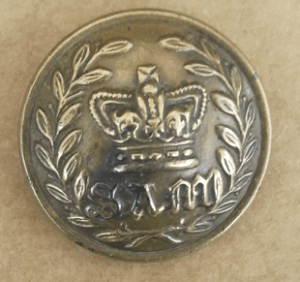
The S.A.M. buttons probably date from after 1877 when, following the winding back of previous volunteer forces, a new force was established. The snippet below shows that the firm supplied the new uniforms in 1878.

South Australian Register, 16th March 1878 page 7.
An example with a British backmark can be seen http://www.austbuttonhistory.com/wp-admin/post.php?post=17797&action=edit.
Cossum dates the design below as c.1886, and the ‘Journal of the Society for Army Historical Research in 1957 dated it 1888. At this time a new Militia uniform (with gold instead of silver lace for the officers) was replacing the old Volunteer Military Forces uniforms. In 1888 G. & W. Shierlaw won the tender to supply unifortms for the next three years.

Evening Journal (Adelaide), 24th October 1888 page 3.
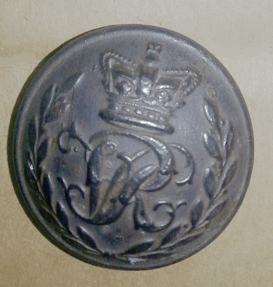
Smith & Wright Birmingham
https://guides.slsa.sa.gov.au/c.php?g=410211&p=2794489
https://en.wikipedia.org/wiki/Colonial_forces_of_Australia
https://manning.collections.slsa.sa.gov.au/sa/defence/defence.htm
http://www.austbuttonhistory.com/14th-may-2022/
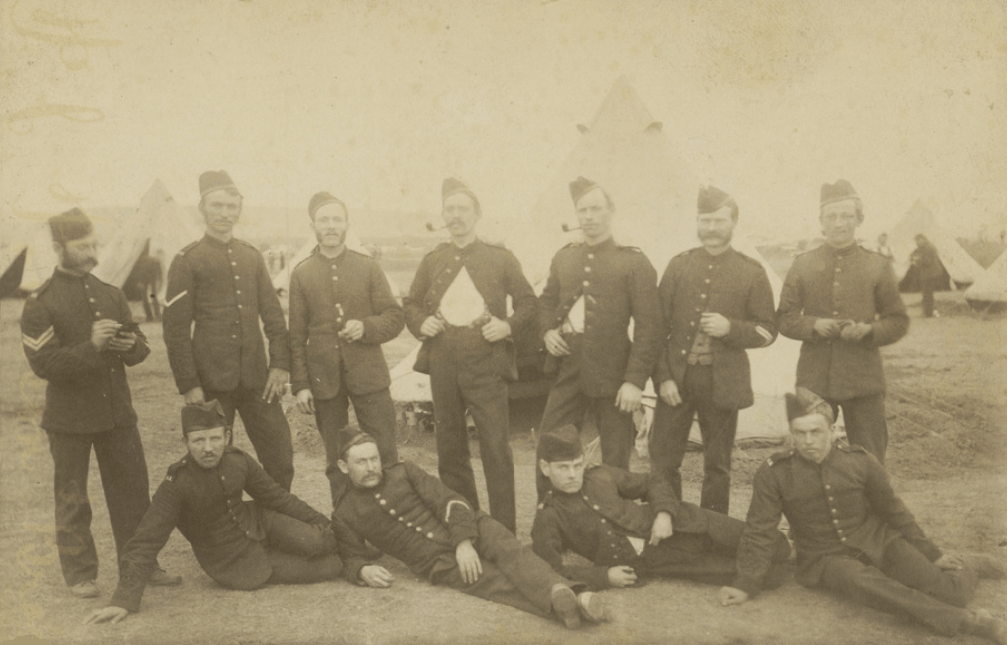
State Library South Australia image#B22008. c.1880
South Australian Militia Scottish Company: 1899-1903
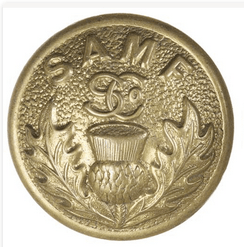
South Australian Militia Scottish Company
The first Scottish Company, the 2nd Adelaide Rifles, was formed in 1866. The next was the Scottish Company of the S.A.M.F from 1899-1903, afterwards renamed the SA Scottish Infantry and lasting until 1912.
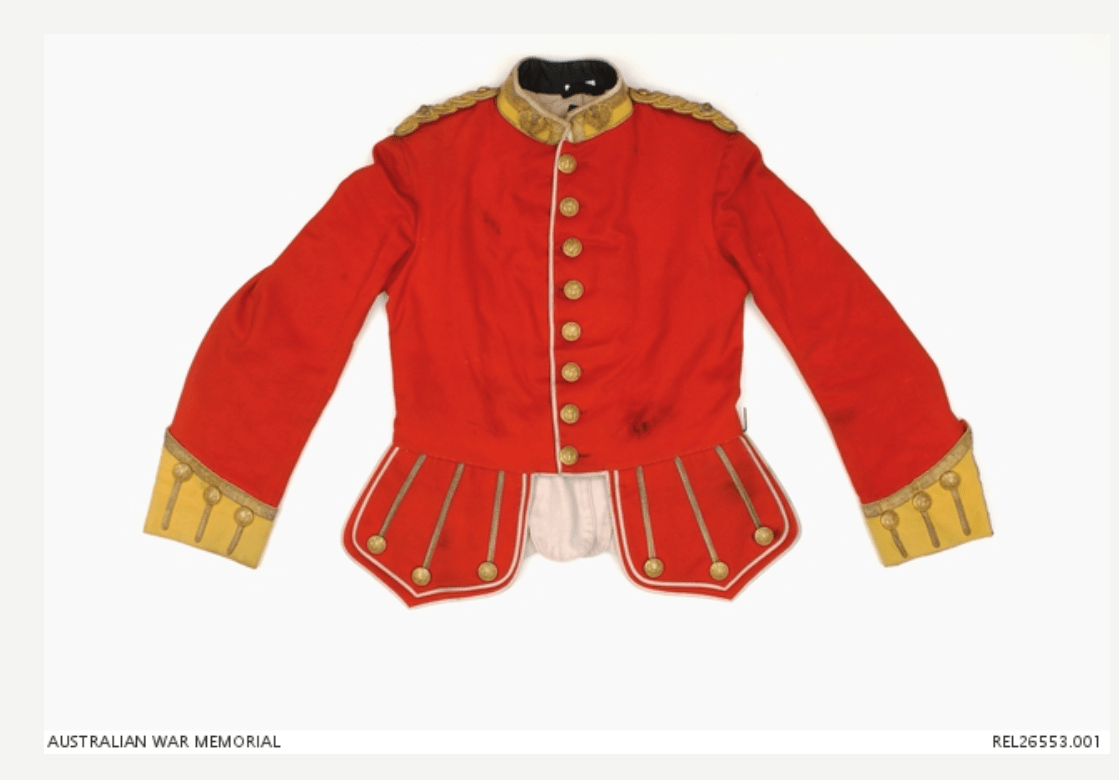
No makers mark on the buttons of this full dress doublet c.1900
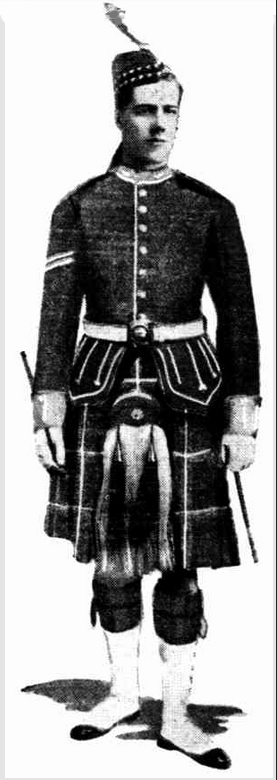
The Mail (Adelaide), 28th July 1934 page 1.A corporal in the Scottish Corps c.1903.
South Australian Rifles: 1854-1860
This had a button similar to NSW and Victorian Volunteer Rifles, but with the letters SAR instead of VR (Victoria Regina), and a bugle.
South Australian (Rifles) Volunteers: 1861-1877
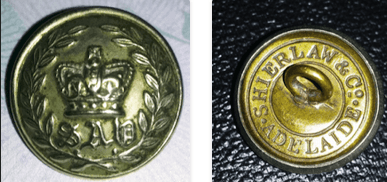
SAV: Shierlaw & Co Adelaide c.1877
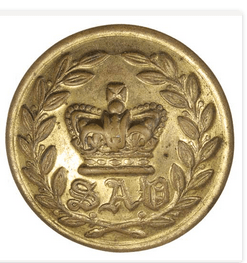
Thanks to Noble Numismatics.According to Cossum page 19; the SA Volunteers, c.1860-70. Note the SAV uniforms were not provided until late in 1861.
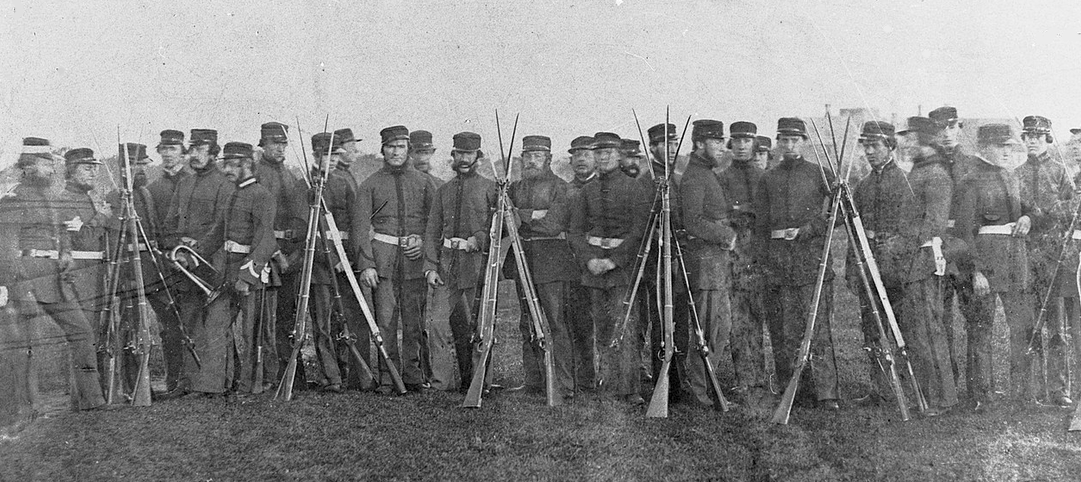
From Wikipedia/The History Trust of South Australian. Eastern Suburban Rifle Company, 1860.
From November 1854, the history of infantry in the colony of South Australia was quite convoluted, with volunteer forces being repeated raised, merged and disbanded. From the Diggers History web site ” The constant raising and disbanding of Militia Forces in the early colonial days, was a direct result of the citizen’s reaction to direct threats to their security. Their numbers rose and fell as these threats were realized and then subsided.”
The first reference to a Rifle corps appears in 1854:
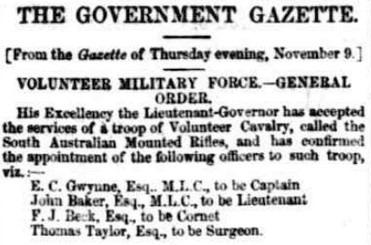
South Australian Register, 10th November 1854 page 3.
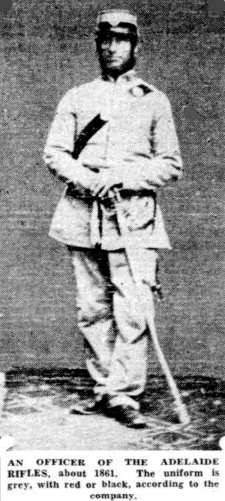
The Mail (Adelaide), 7th April 1934 page 1.
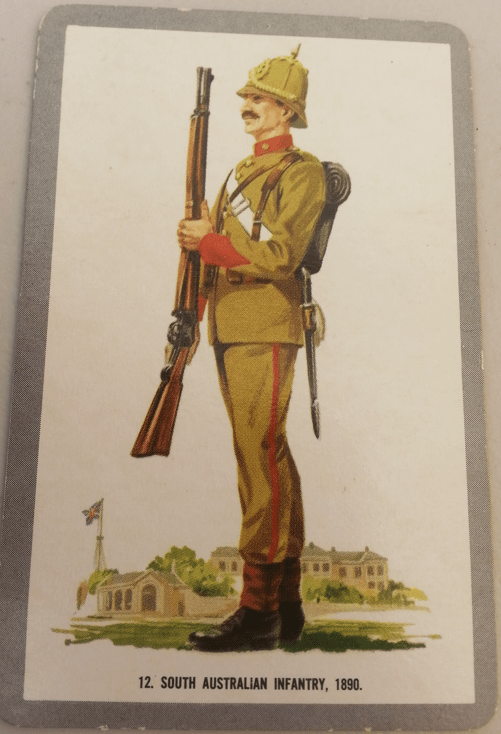
“By 1890 the South Australian Government had organised a very efficient military force. The uniform had changed from the early days and was modelled on the lines of the British line regiments of the time, except that the colour was khaki. Martini-Henry rifles were issued to all non-commissioned ranks.”
3rd Battalion Adelaide Rifles
The button, c.1892. bears a circular band, looking like a target.
Tasmania
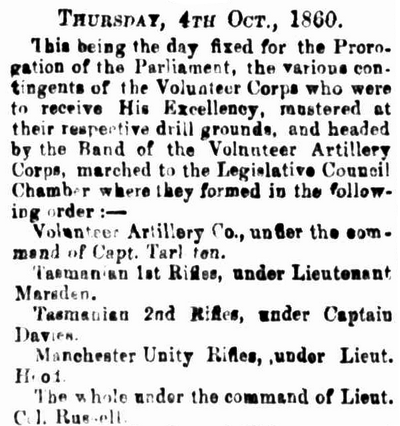
The Hobart Town Advertiser, 5th October 1860 page 2.
In 1862 along with the City Guards, other corps of the Southern Tasmanian Volunteers were the 1st, 2nd, Buckingham, Derwent, Manchester Unity, Kingsborough, Houn Rifles,and a Hobart Town Artillery. By 1868 only the 2nd, 4th (Houn) and City Guards remained of all these Rifle Corps.
City Guards: 1860-67
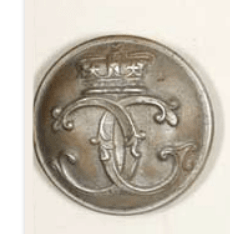
Stokes Maker, Melbourne
Unhappy with the state of crime and policing in there town, in 1860 around 140 men petitioned the Hon. James Milne Wilson, Esq.,MLC. to form a Volunteer City Guard. Although this was but one volunteer rifle brigade amongst others, I cannot but suspect this was a reaction to local crime rather than a desire for colonial defence, by the statement that it was for “the defence and protection of this city only“


The Hobart Town Advertiser, 17th September 1860 page 3.
The inaugural meeting was held on 26th September, where the Government offered £4000 towards uniforms etc. Over two hundred men offered to serve. Uniforms were decided on, but it took until June the following year for the men to be supplied. Unfortunately, by late 1867 the volunteer movement in the colony was in decline. The presence of regular troops, a peaceful international climate, and the sacking of some popular leaders had reduced the popularity of the movement. The City Guards, also the 2nd Rifles, were disbanded. Only one artillery corps in each of Hobart and Launceston remained by late 1869.
In “Walch’s Tasmanian Almanack and guide to Tasmania for 1863”, the uniform is described as blue with red facings and silver lace. The numbers in 1863 were 203 rank and file. By 1867 they had dropped to 91 rank and file.
Launceston Volunteer Artillery Corps: 1860-1867

Stokes Maker (pre Stokes & Martin partnership)
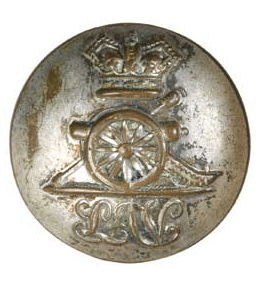
no maker
In 1860 the L.V.A.T was formed from a rifle corps. They had to supply their own uniforms, paid 2/6 to join and 2/ a month expenses! One year on Queen Victoria’s birthday the volunteer’s pulled their artillery up Windmill Hill by rope as they had no horses, to fire a salute with powder they bought themselves! Members kept the unit going, even through years (1872-1878) without government assistance. ‘Volunteer’ was dropped from their name around 1886, and they continued as the Launceston Artillery until 1903, becoming part of the Australian Field Artillery.
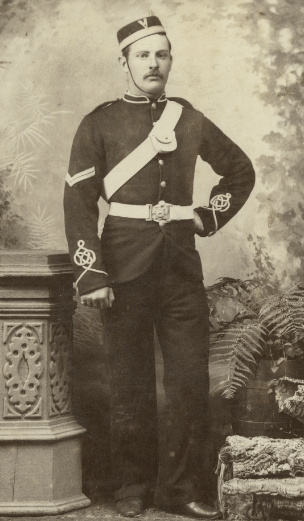
Libraries Tasmania’s Collection (permalink https://stors.tas.gov.au/AI/LPIC147-7-142)
LVAT soldier 1890.
Tasmanian Defence Forces: 1885-1901
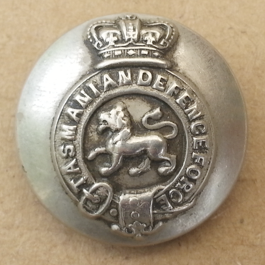
Hobson & Sons Golden Square w.
According to Cossum, page 25, this button dates from 1884-1901. This agrees with the backmark, as Hobson & Sons were at 1-5 Lexington Street, Golden Square, West London from 1887-1901. However, please note that the dating in Cossum’s book, whilst correct for the forces, is out in this instance by a couple of years for the actual uniform buttons.
The history of the colony’s defence forces was one of government disinterest, poor or no funding, poorly placed batteries, small permanent force numbers and volunteer units that waxed and waned until the Second Boer War increased interest and support.
In 1874, a government report detailed that only the Hobart and Launceston Artillery Corps remained in the state from a once larger number; the Hobart corps existing in name only, with five officers and no men and “80 stand of arms and accoutrements unaccounted for.” Launceston had a total of 22 men and officers. This small loyal group kept this corp in existence, with no support or recognition, and only obsolete rifles with no ammunition. In the meantime, there were no volunteer forces in the south of the state from 1874 until 1877 when new volunteer rifle groups were raised. These groups dwindled from 1880-1883, then a new Commandant arrived from England. A revival of the forces under this new command seems to have prompted the production of the button above to supersede the previous button. The previous button, according to Cossum, had a similar design but was labelled with ‘Tasmanian Local Forces’. The article below indicates the buttons and other accoutrements arrived from England in 1880 for the Tasmanian Local Forces.
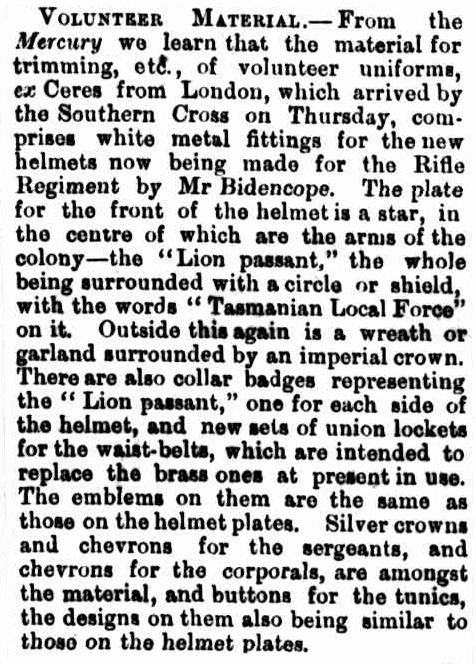
Launceston Examiner, 13th July 1880, page 3. The force was formed in 1878 but the uniforms did not arrive until 1880, with some units not receiving them for several years.
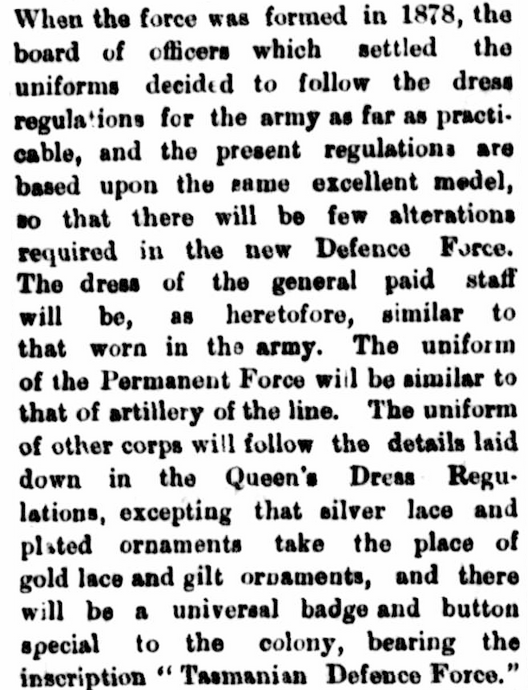
The Mercury (Hobart), 27th February 1886 page 2. From an article on the release of Tasmania’s Defence Force Manual. Uniforms including the above button did not arrive by ship until 1889.

The Tasmanian (Launceston), 11th January 1890 page 24. From an article describing the new uniforms.
In 1900-01 there were 27 permanent and 2527 volunteers. The batteries were in poor repair, the forces poorly equipped with old, “useless” rifles and wearing either no uniforms or worn out second-hand uniforms. The State Minister of Defence stated … that it (the forces) had become probably more of a menace to the state than a security.” Even after federation it took several years before issues of pay and uniforms were dealt with.
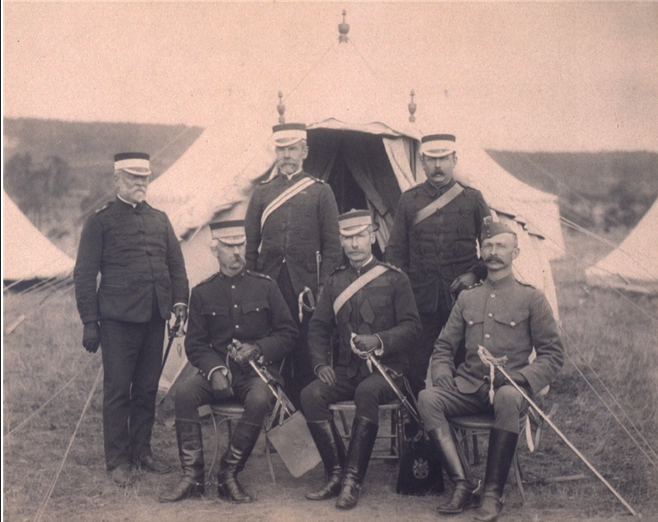
Libraries Tasmania’s Online collection: c. 1890 Tasmanian Volunteer force.
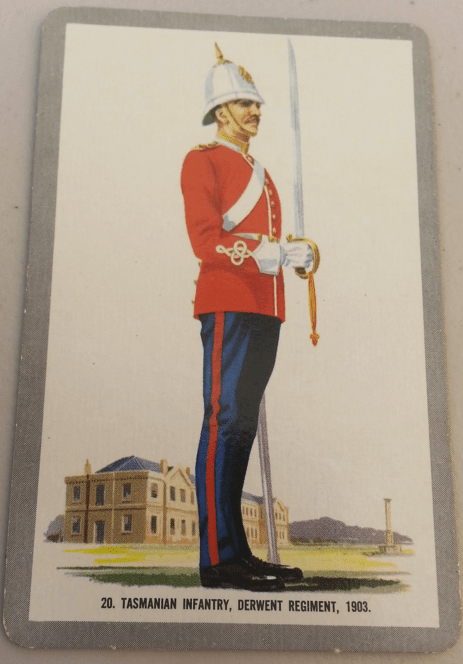
“The Tasmanian Regiment began in 1870. Formerly the Tasmanian Volunteer Regiment, it changed in 1897 to the 1st Battalion Tasmanian Infantry Regiment. In 1911 it became the 93rd Infantry Battalion, and in 1916 was the 40th Battalion of World War 1. The 2nd 40th distinguished itself in Timor in World War 11.”
Tasmanian Rifle Volunteers: 1878-1884
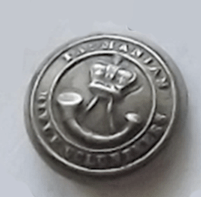
In 1878 new volunteer forces were raised after a period of decline in the colony that had left only Launceston Artillery Corps functioning. However, once again the volunteer forces dwindled until a new Commandant arrived from England in 1883, and Tasmanian Defence Forces were raised in 1885. The new uniforms and buttons did not arrive until 1889!
Tasmanian Volunteer & Permanent Artillery: 1878-1901
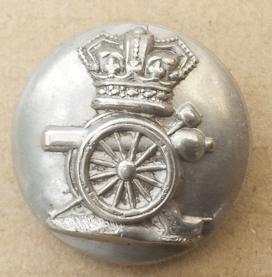
Backmark: C. Pitt & Co 50 St Martins Lane London Charles Pitt & Co operated from 50 Martins Lane from 1875-1895.
According to Cossum, this button dates from 1884-1901. Whilst volunteer artillery units existed from 1859, the Permanent Artillery was raised on 10th September 1886, so they cannot date from 1884. There was mention in the press of a new uniform for rifle clubs being tendered for in 1889, so perhaps the buttons date from then.
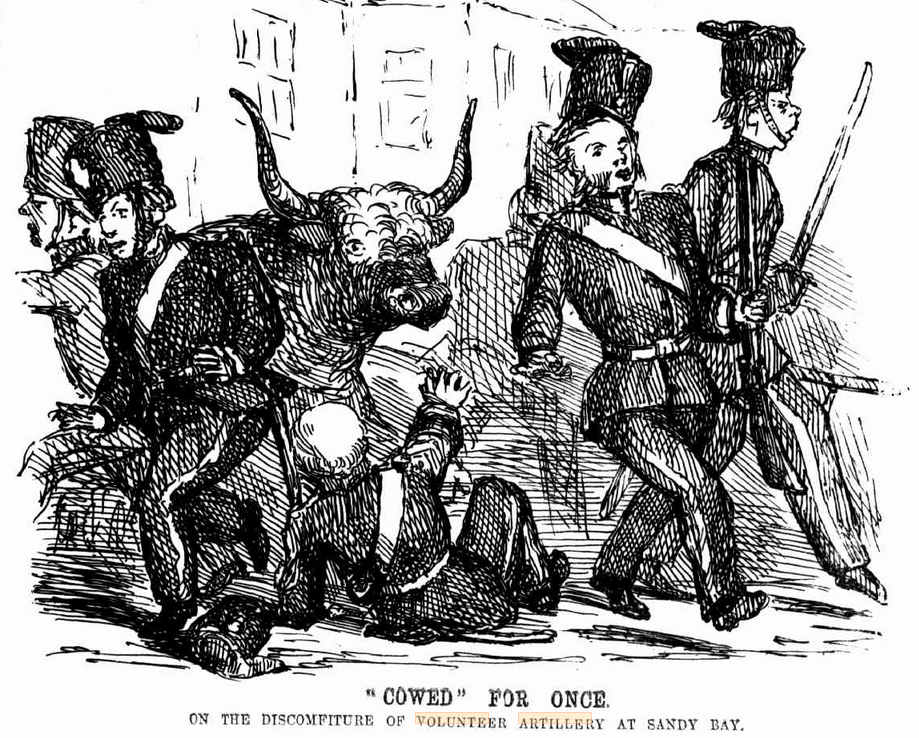
Tasmanian Punch, 26th February 1870 page 6.
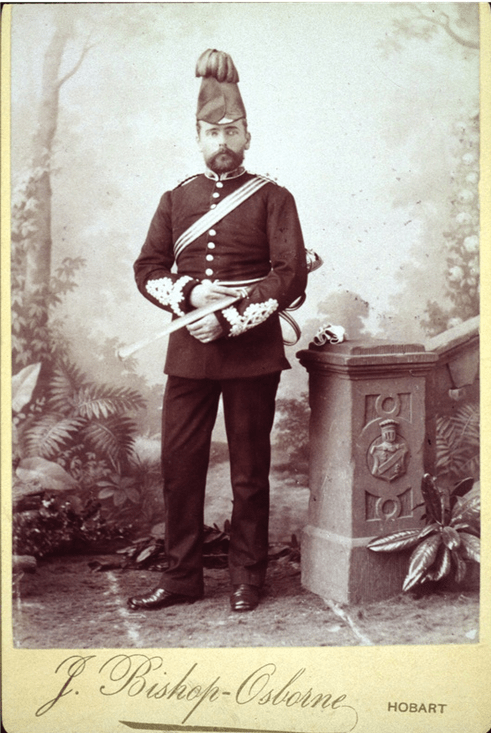
Libraries Tasmania # SD_ILS:652755 Dr E. J. Crouch Southern Tasmanian Volunteer Artillery. c.1885
https://www.utas.edu.au/library/companion_to_tasmanian_history/V/Volunteer%20defence.htm
Tasmania Volunteer Staff, Medical Staff & Retired Staff: 1870-1901
According to Cossum, 1879-1901. Copper with silvered escutcheon of the Queen Victoria cypher. (West Australia had a similar button.) Both below are backmarked C.R. Martin Melbourne.
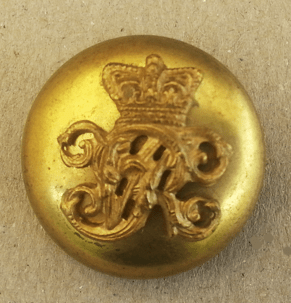
Frosted gilt on gilt.

Frosted silver on brass.
1st Rifles, Southern Tasmanian Volunteers: 1860-1866
The uniform button has a central crown surmounted by ‘1st Rifles’ , with ‘STV’ for Southern Tasmanian Volunteers underneath. The corps started in 1860 and was originally the Masonic Rifle Corps. In February 1866 it was amalgamated with the artillery company.
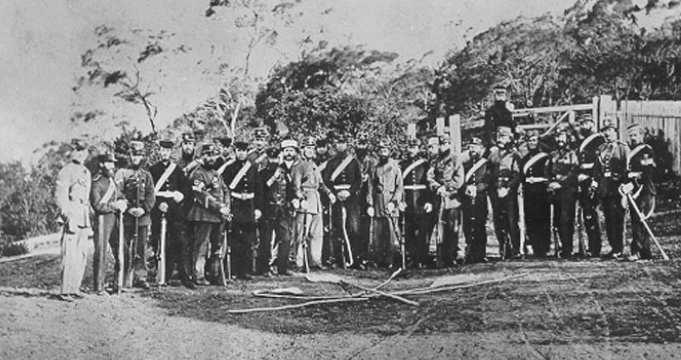
Libraries Tasmania Collection image #PH30-1-469. members of the Artillery and 1st rifles at a shooting competition. 1865.
2nd Rifles, Southern Tasmanian Volunteers: 1862-1868
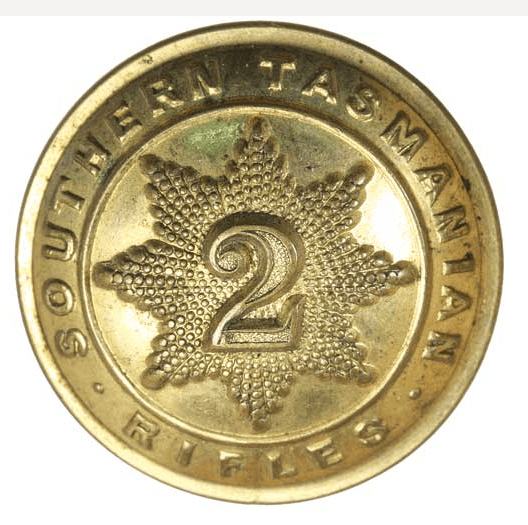
Thanks to Noble Numismatics: 2nd Tasmanian Rifles by Firmin & Sons
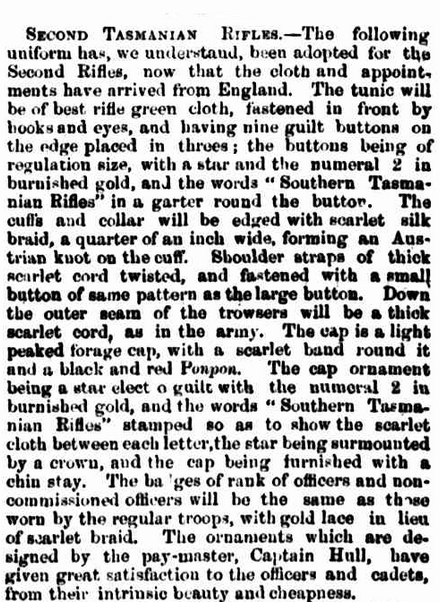
The Mercury (Hobart), 7th February 1862 page 2. This rifle corps may not have lasted for long.
The 2nd were originally the Odd Fellows Rifle Corps, and started in 1860. Their uniforms were dark green with black facings, but changed to green with red facings and gold lace. In 1863 they had 70 rank and file. They were disbanded in 1868.
Victoria
http://www.austbuttonhistory.com/uncategorized/28th-october-2020/
http://www.austbuttonhistory.com/uncategorized/29th-october-2020/
http://www.austbuttonhistory.com/uncategorized/30th-october-2020/
http://www.austbuttonhistory.com/uncategorized/1st-november-2020/
http://www.austbuttonhistory.com/uncategorized/2nd-november-2020/
http://www.austbuttonhistory.com/26th-june-2023/
http://www.austbuttonhistory.com/27th-june-2023/
http://www.austbuttonhistory.com/28th-june-2023/
http://www.austbuttonhistory.com/29th-june-2023/
Melbourne Cavalry Corps: 1901-1903
The Melbourne Cavalry Corps was a volunteer corps raised in 1901.
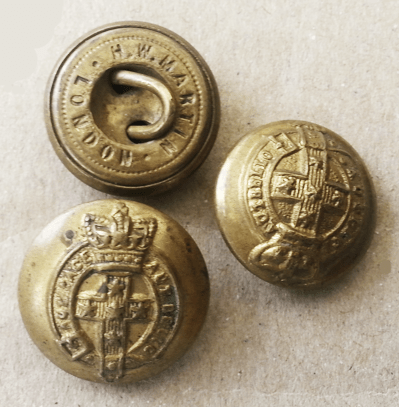
This corps wore buttons of the Victorian Military Forces.
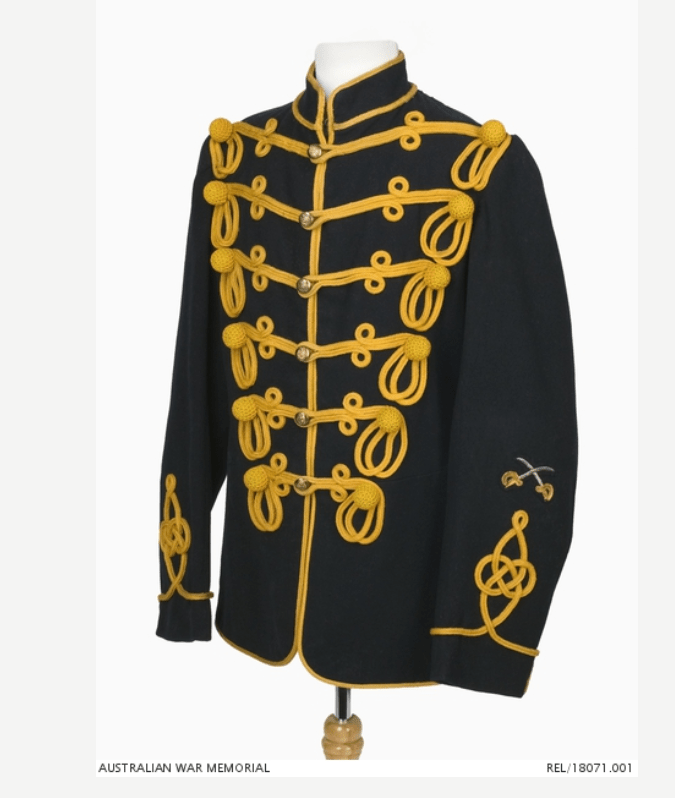
Australian War Memorial collection: “Trooper’s full dress tunic Melbourne Cavalry Corps, Victorian Mounted Rifles” c.1901, complete with brass Victorian Military Forces buttons of the 1880-1893 period bearing the ‘AUT PACE AUT BELLO’ motto and made by ‘H.W MARTIN LONDON’. A similar uniform auctioned by Carter’s sported buttons with the ‘PRO DEO ET PATRIA’ motto, which replaced the ‘AUT PACE AUT BELLO’ buttons in 1891 and which would have been the original buttons used. I guess the uniform at the AWM must have had its buttons replaced.
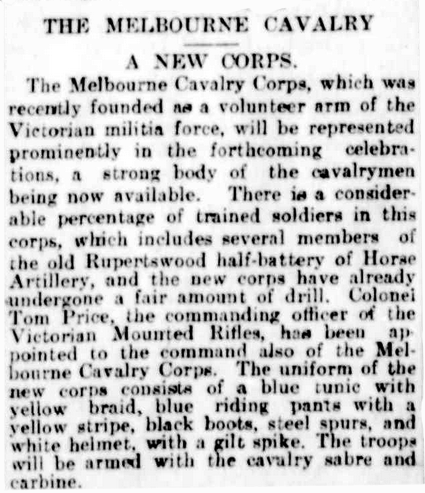
The Age (Melbourne), 23rd April 1901 page 6.
They had to supply their own uniforms, saddles and horses. Their main duties were ceremonial, such as attending the opening of the first Parliament in 1901 and forming escort for the Governor. Not surprisingly, this resulted in the cavalry being formed by affluent Melbourne gentlemen, with a penchant for showing off in fancy uniforms and impressing the ladies (according to journalists). Although small in number (20 men in 1903, rising to 50) they were proud of their name and unit, and resisted being merged into the Commonwealth’s new Light Horse. They were allowed to keep their identity as the No 6 Squadron “Melbourne Cavalry” 10th Regiment, 4th Light Horse until 1911. The following year all squadron were merged as the 13th Light Horse, Victorian Mounted Rifles.
Permanent Victorian Artillery Corps: 1891-1903
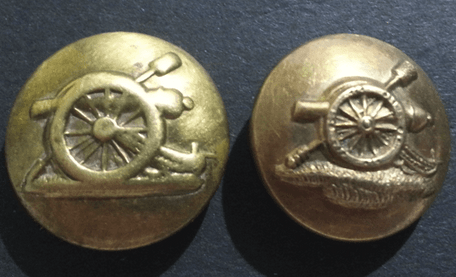
Both backmarked Bowley & Co. Melbourne, but of differing construction.
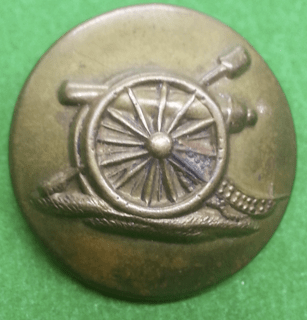
W. Moncton Melbourne, 1899-1903.
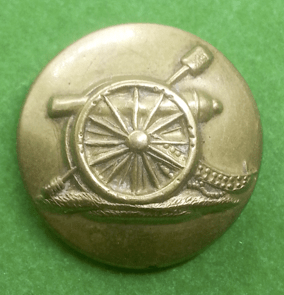
Stokes & Sons Melb
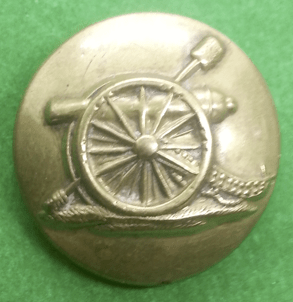
Lincoln Stuart Melbourne
Royal Artillery uniform buttons have a crown depicted over the cannon and ramrod; this style without the crown was used for the pre-federation Permanent Artillery.
An Artillery Corps was created in 1870 after the use of British Corps was ceased, and lasted until 1901. (The design was also used later from 1924 for Artillery Association Uniformed Staff in the United Kingdom.)
Prince of Wales Victorian Volunteer Light Horse 1863-1884.
All the various mounted troops in Victoria were merged into one of 6 troops of the regiment of the ‘Victorian Volunteer Light Horse’ in 1862, renamed the ‘Prince of Wales Victorian Volunteer Light Horse the following year’. (See Cossum page 10. The button has the POW plumes over the initials PWVV). They were disbanded in 1884.
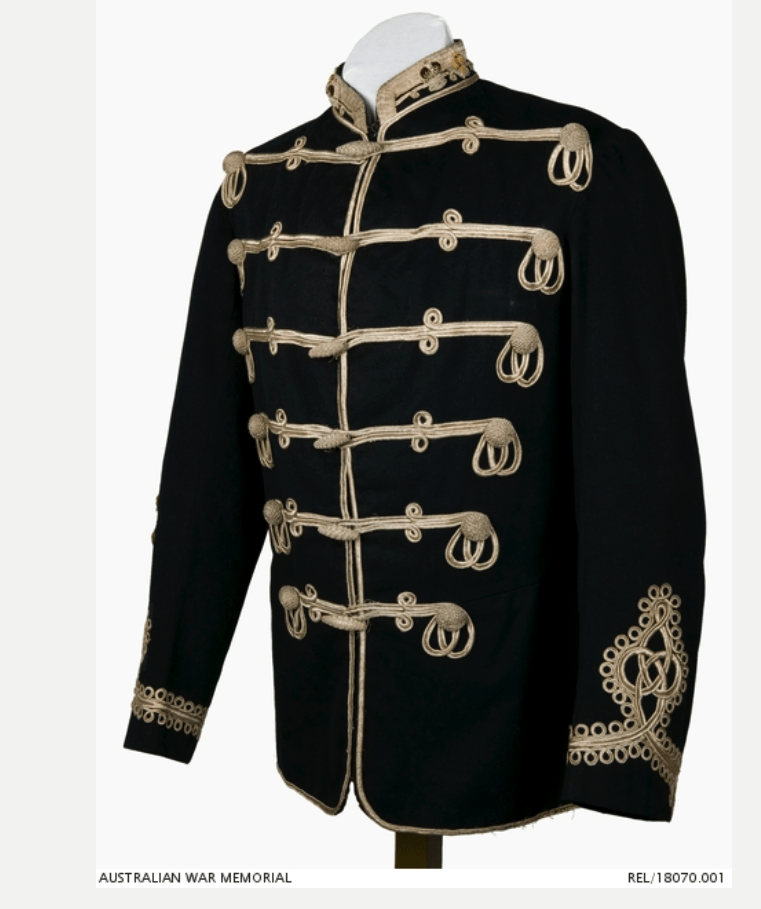
Australian War Memorial 18070.001: Prince of Wales Light Horse Officer’s jacket c1863-73.
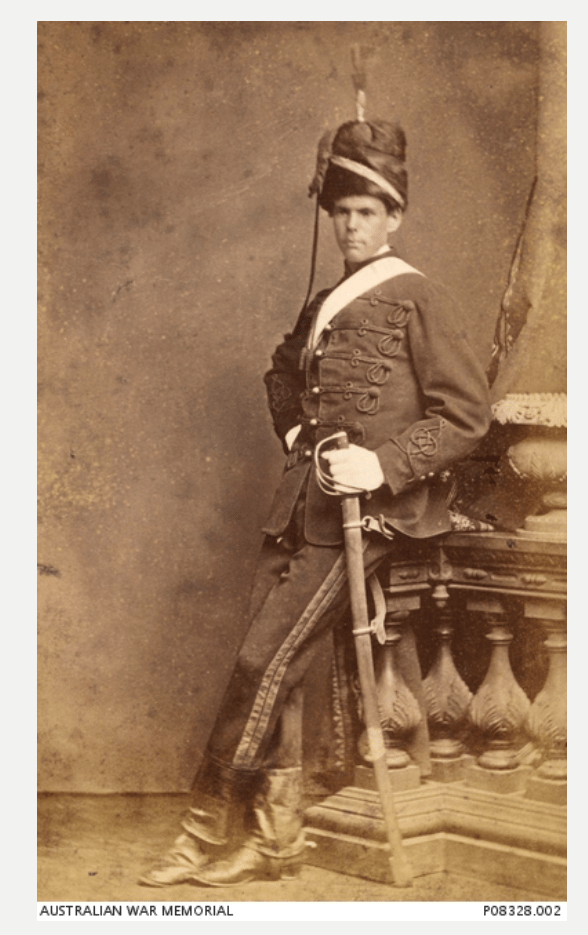
AWM P08328.002: unidentified Victorian Colonial soldier, a private in a Victorian volunteer cavalry unit , most probably the Prince of Wales Volunteer Light Horse (Hussars).

The Age (Melbourne) 8th August 1863 page 5.
Royal Victorian Volunteers Artillery Regiment: 1859-1870
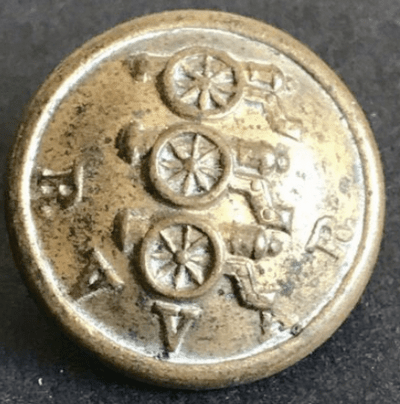
Stokes and Martin Maker Melb
Victoria Volunteer Artillery Regiment: 1856-1859
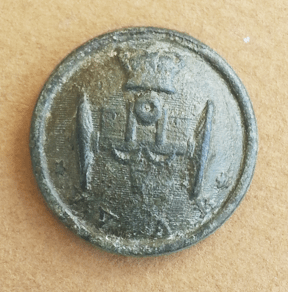
Damaged: no shank or back plate. It was either gilt or silver plated when made.
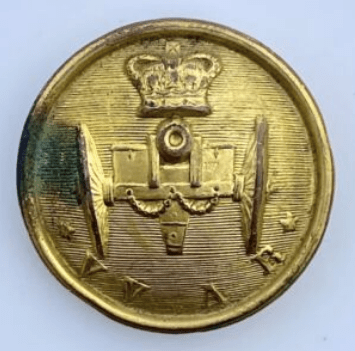
Backmark: W. Barnard Melbourne. Image used with permission.
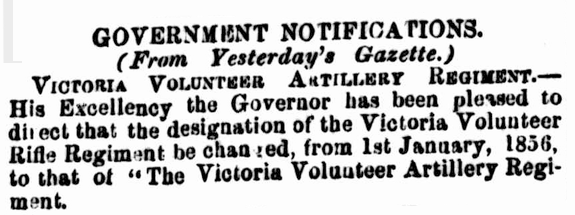
The Age (Melbourne), 14th November 1855 page 5.

There are two versions of this button on Cossum’s book, page 14. It shows a cannon on wheeled cart with the letters V.V.A.R. with a 6 pointed star at each end. This dates the button from 1856-1859, as in 1859 the regiment received the Royal warrant and commissioned new buttons marked R.V.V.A.R. It looks like a one piece, hollow back button, but I can’t be sure it didn’t once have a back plate.
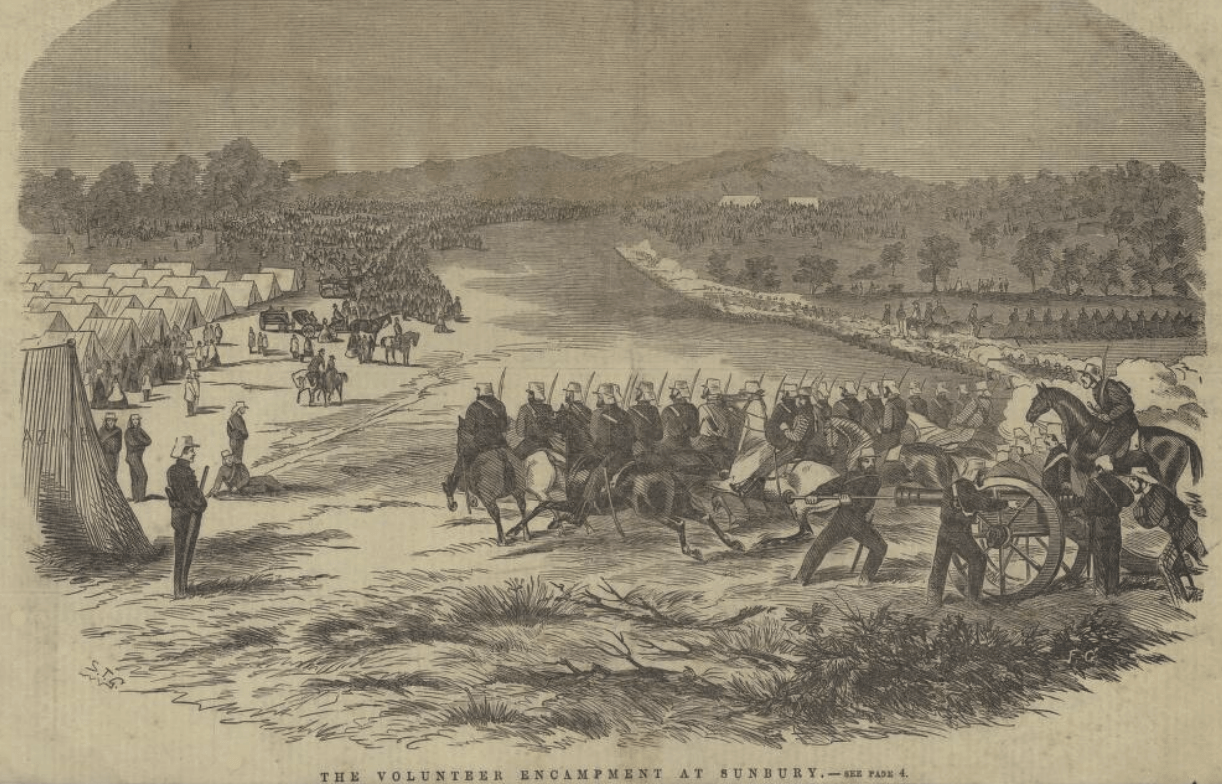
This sketch by Frederick Grosse dates from the 1860s, after the Royal title had been bestowed. It shows the artillery in action in the lower right of the scene.
Victorian Artillery Staff
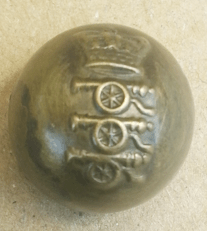
No backmark. Ball button.
A similar button to this is seen on Cossum page 16. There is no suggested date, but it does have a Queen Victoria Crown (i.e. pre 1902). It may have dated 1870s-1880s.
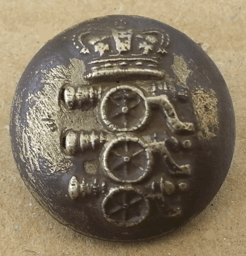
Wilson King Williams St, London

No backmark.
If you look at Cossum’s book, the New South Wales Artillery on page 8 and the Victorian Artillery Staff on page 16 are the same, apart from the quoted manufacturers. This is because the design was copied directly from the British unlike, for example, the Royal Victorian Volunteer Artillery that had their own design struck.
The backmark relates to the wholesalers of these buttons. Barron & Wilson were cutlers/ironmongers in London from at least 1824 until 1885, when it became Wilson & Son at King Williams Street, London. They were sporting goods/kitchen/hardware merchants. Therefore the button dates post 1884.
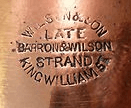
Ifthis dating for Wilson is correct, then the button was for the Victorian Artillery, as Cossum dates this design as 1870-80 for New South Wales.
Victorian Cavalry Regiment: 1885-1892
See http://www.austbuttonhistory.com/uncategorized/30th-october-2020/
The ball type button for both the Victorian Horse Artillery (Cossum p.15) and the Victorian Cavalry Regiment (Cossum p.16) are very similar. In Cossum’s book the first was made by Firmin of London and seems to have a “Queen Victoria” type crown, and the second made for Bowley & Co., Melbourne, with a Tudor type crown, but is based on the small diamond crown she wore after Albert’s death. Apart from that, the design is the same so I have some hesitancy in firmly identifying the button in case both troops were supplied with the same/similar buttons.
Victorian Horse Artillery: 1889-1897
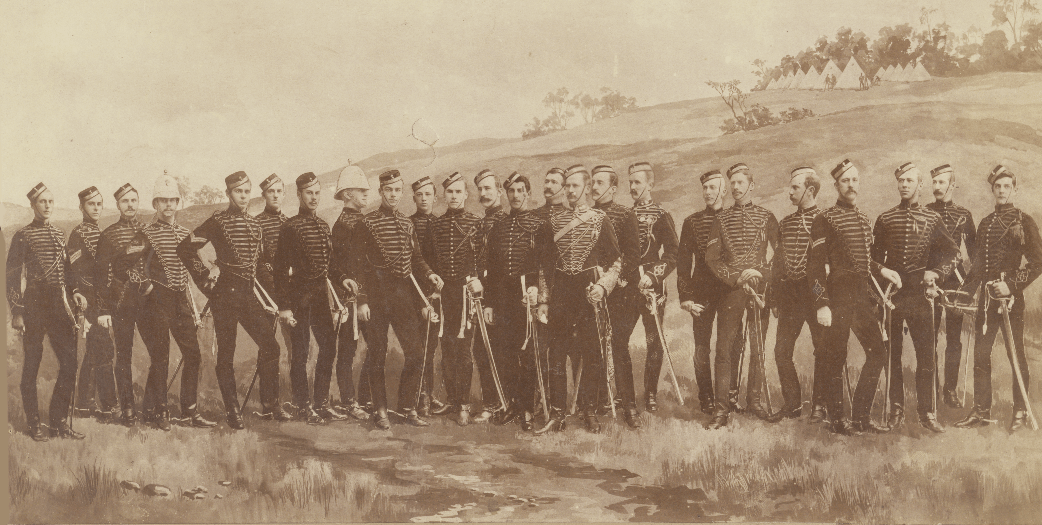
State Library Vic # 1774734 Members of Sir William J. Clarke’s Battery Victorian Horse Artillery Rupertswood 1895.
http://www.austbuttonhistory.com/30th-october-2020/
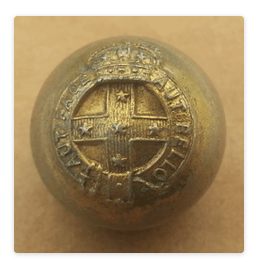
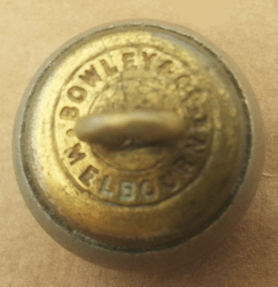
Ball button used by the Horse Artillery.
The Victorian Horse Artillery was a wealthy man’s project. Landowner and grazier Sir William Clarke founded the horse artillery and based it at his property Rupertswood, near Sunbury. His son Rupert commanded the battery. The Clarkes provided 60 horses for the horse artillery, at substantial cost. The Regiment cost him nearly £2000 a year. This regiment lasted from 1885 until disbanding in 1897, after Sir William Clarke had died and with the Government not considering the expense justifiable.
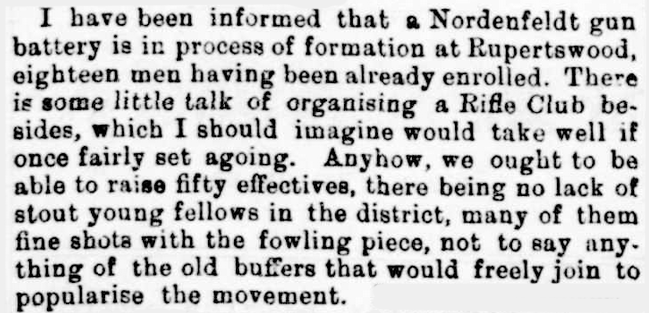
The Bacchus Marsh Express (Vic), 14th February 1885 page 3.
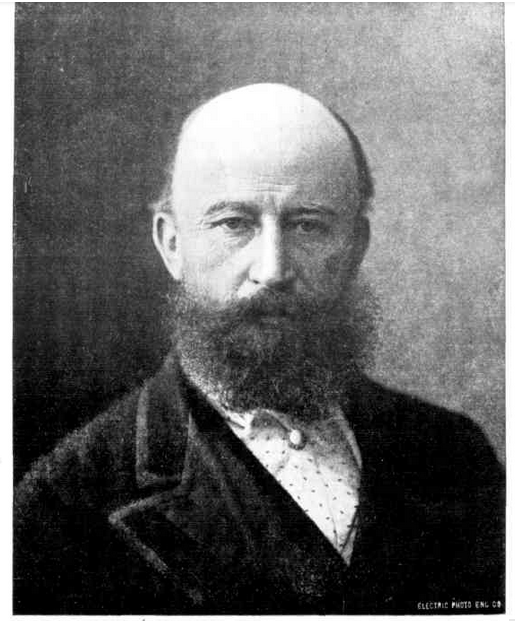
The Sydney Mail and New South Wales Advertiser (NSW), 29th May 1897 page 1135. Sir William Clarke 1831-1897.
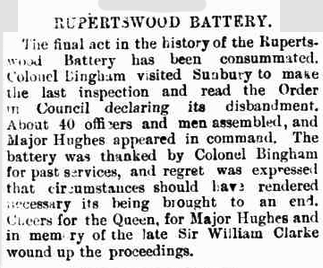
Kalgoorlie Miner (WA), 4th August 1897, page 3.
Victorian Military Forces: 1880-1901
This consisted of the Victorian Rangers and the Victorian Mounted Rifles.

Stokes & Martin Melb 1892-3 The motto is ‘Pro Deo et Patria’ (For God and fatherland/country) which a dates it to 1891 or later. As Stokes’ and Martin’s partnership dissolved in 1893, that button presumably dates to a short period around 1891-3.
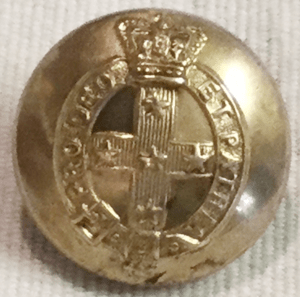
Lincoln Stuart & Co. 1893-1901
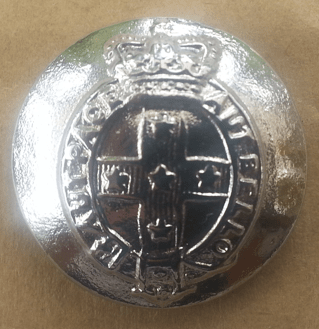
Unmarked. 1891-1901.

From left top clockwise: Brockworth’s London, Stokes & Sons Melbourne, H.W. Martin London, Bowley & Co. Melbourne, Stokes & Sons Melb.
The Victorian Rifle Volunteers were renamed in 1889 as the Victorian Rangers, and were often drawn from rifle clubs. The button is similar to the universal New South Wales pattern, but with a star instead of a lion in the centre. The motto was adopted in 1875 ‘Aut Pace Aut Bello’ (In Peace and In War). This changed in 1891 to ‘Pro Deo Et Patria’ (For God and Fatherland).

The Age (Melbourne), 10th June 1891 page 7.
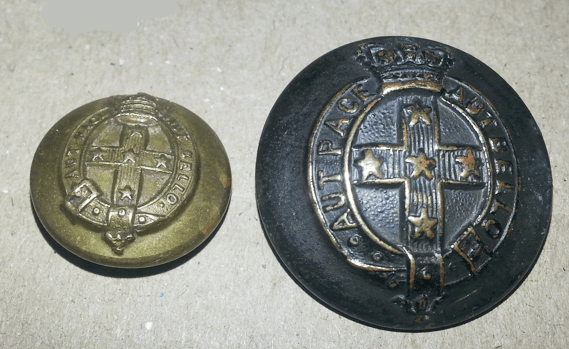
The buckle of the garter is usually depicted on the left side at the bottom (as seen by the viewer) as in the above left sided button, but Stokes and Sons produced buttons with the buckle to the right. I think this was in error by Stokes.
Victorian Naval Artillery
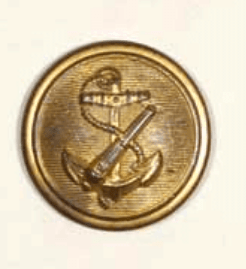
Thanks to Noble Numismatics: Stokes Maker. c.1863 as per Cossum.


The Age (Melbourne), 26th November 2020 page 2.
The excerpt from the financial statement shows that their were Naval Volunteer Artillery as early as 1856. This may refer to the Victorian Marine Artillery Corps that was in existence from 1856-1860. Perhaps this was the unit this uniform button belonged to?
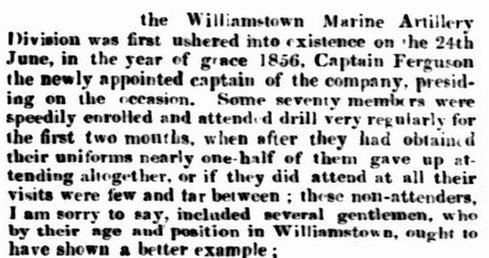
Willoamstown Chronicle (Victoria), 19th September 1857 page 3.
During July 1856 a “Marine Artillery Company” at Williamstown was established, and the first fort was built there during 1860. This corp lasted until 1884 under the name of the Williamstown Volunteer Artillery. However, they had their own uniform button, as seen on page 15 of Cossum. It shows the QV crown over a side profile field gun, and the letters W. V. A. underneath. Does anyone have one of these?
In 1863 there was a new Volunteer Bill, with new enrollments, which may be why Cossum dated the button above as circa 1863.
Victorian Naval Brigade: 1885-1901
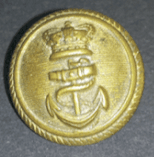
Backmark: C. R. Martin Melbourne

Stokes & Sons Melb
The colony’s naval reserve was reorganised in 1885 as the Victorian Naval Brigade, lasting until 1907 when the Commonwealth Naval Force was established. The buttons show an upright Anchor (not tilted/lazy) and a Queen Victoria Crown. Note that the rope crosses over then under the shank on the CR Martin version, but under/over the shank of the anchor on the Stokes version.
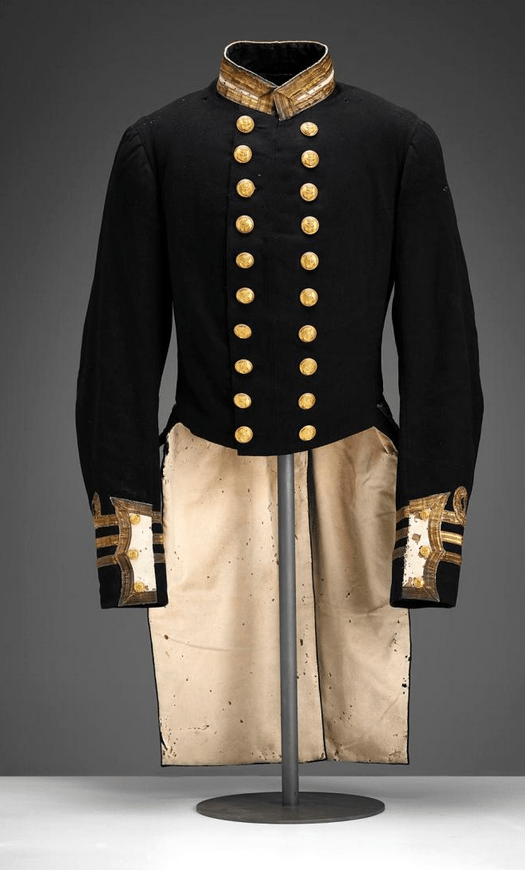
As well as a double rows of 10 gilt buttons, there are another 3 buttons under the front flaps, and 3 on each cuff. Australian Maritime Museum http://collections.anmm.gov.au/en/objects/30360/victorian-naval-brigade-officers-jacket;jsessionid=B742AA0669DFA8A1D7FBE3A3FD27D648
In 1900 five hundred sailors of the New South Wales and Victorian naval brigades, as well as the South Australian warship ‘Protector’ went to China to help suppress the Boxer uprising. Although they arrived at Tiesen too late to be involved in the fighting, they were involved in a nasty suppression of the town of Pao Ting Fu.
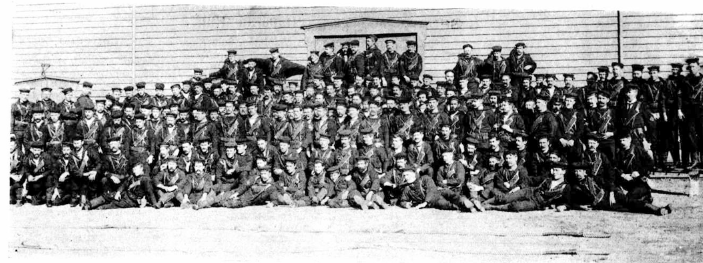
Critic (Adelaide), 28th July 1900 page 10. Victorian Naval Brigade going to China.
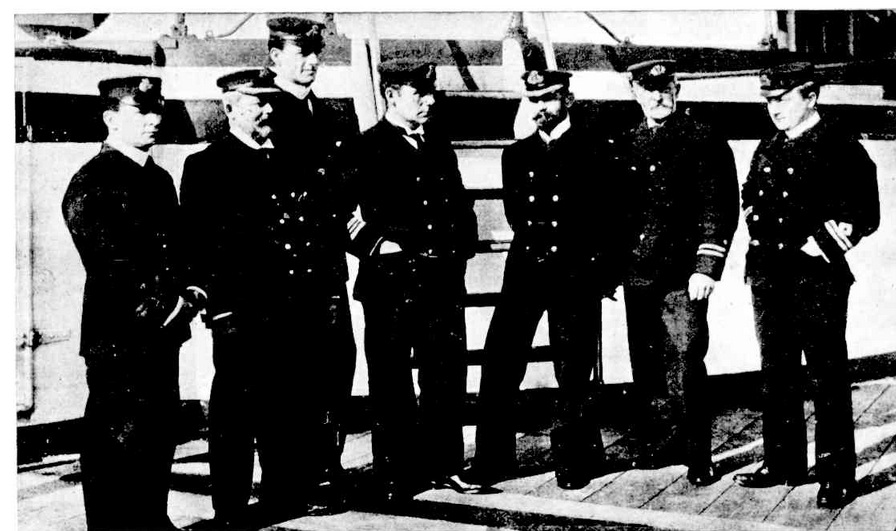
Australian Town and Country Journal (Sydney), 4th August 1900 page 39. Officers of The Cerberus.
Victorian Rangers
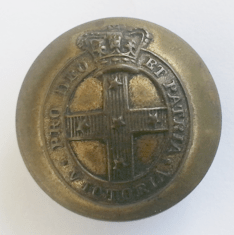
Stokes & Martin Melb.
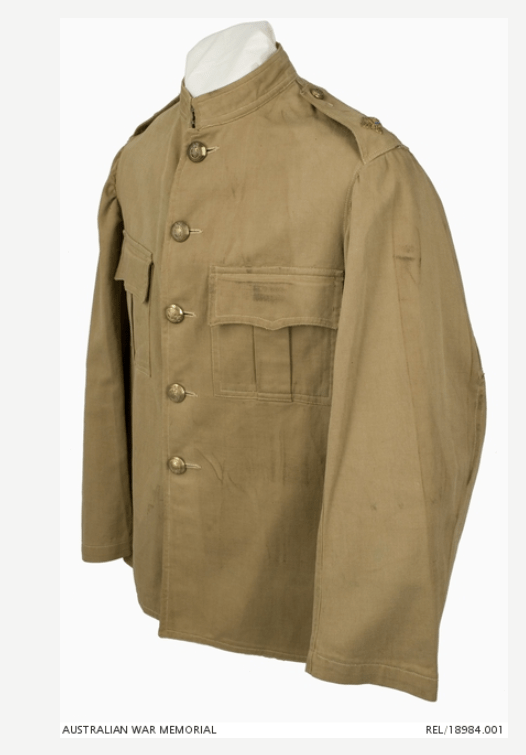
AWM collection https://www.awm.gov.au/collection/C215923
Victorian Rifle Regiments: 1880-1890
Thanks to Noble Numismatics for the following image.
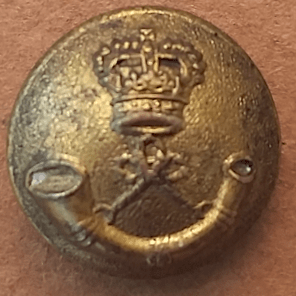
Stokes & Sons.
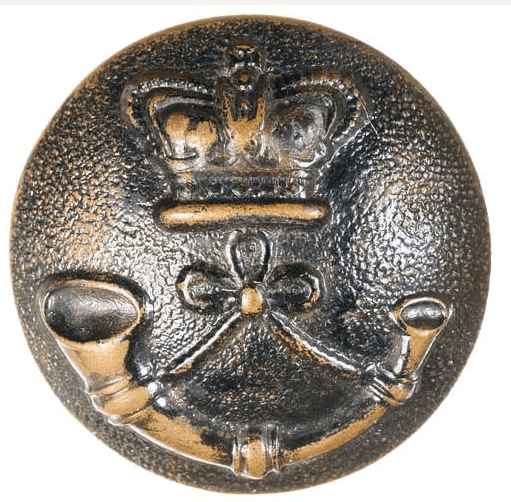
In 1884 it was decided to replace the Victorian Volunteer forces with a militia (part time, partially paid). The militia was continued until federation. However, most units that existed before 1884 remained in existence.
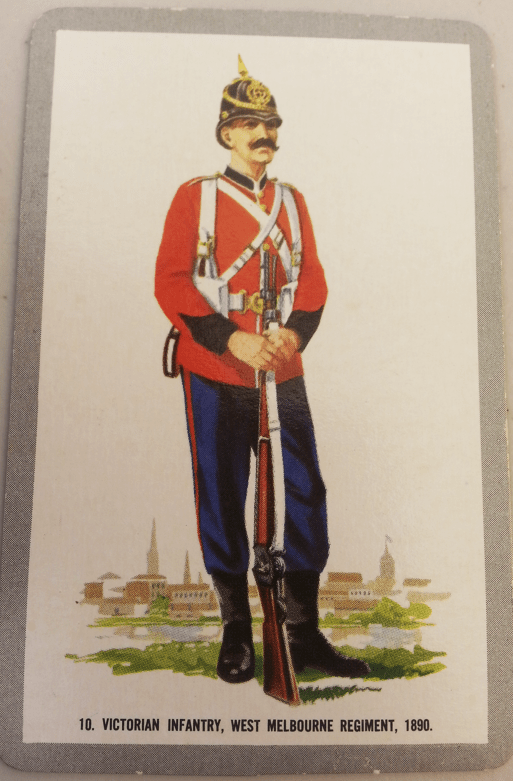
“This soldier’s spiked helmet illustrated here was in vogue, typical of those worn by the British line regiments, and similar to those worn by the German Army in the Franco-Prussian War. The West Melbourne regiment was formerly the 1st Victoria
Victorian Volunteer Rifles: 1860-1870
From an auction catalogue of Noble Numismatics https://www.noble.com.au/site/docs/cats/sale_117/A19.pdf page 182; with thanks.
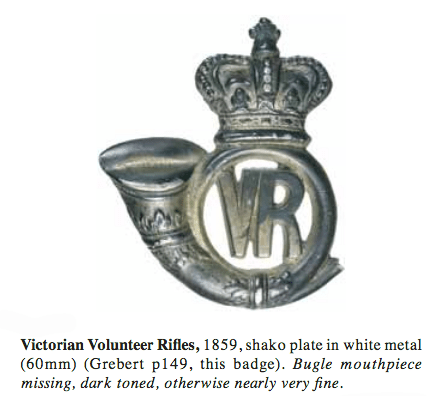
The corresponding uniform button (see Cossum page 9) shows a similar bugle with block capital letters ‘VR’ within the loop. The Queen Victoria crown is separated from the bugle by a small gap. The background is finely striped. The makers mark is T. Stokes, Melbourne (i.e. pre 1867).
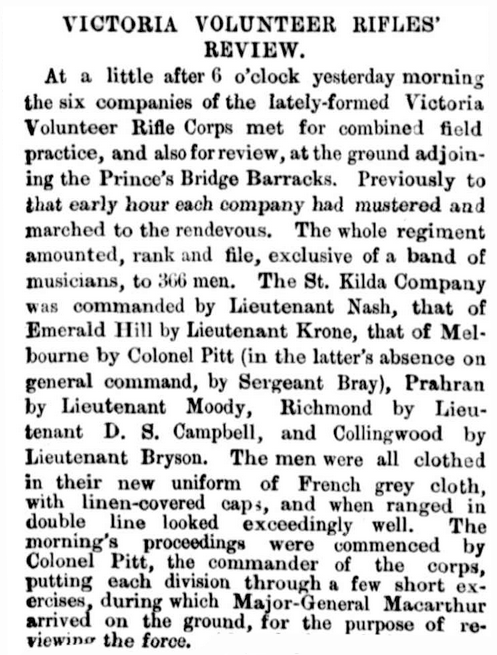
The Major General gave a speech complimenting and encouraging them, concluding …
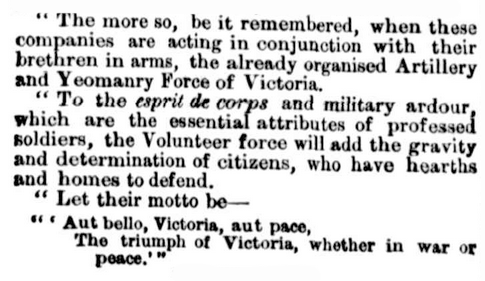
The Argus (Melbourne), 3rd January 1860 page 5.
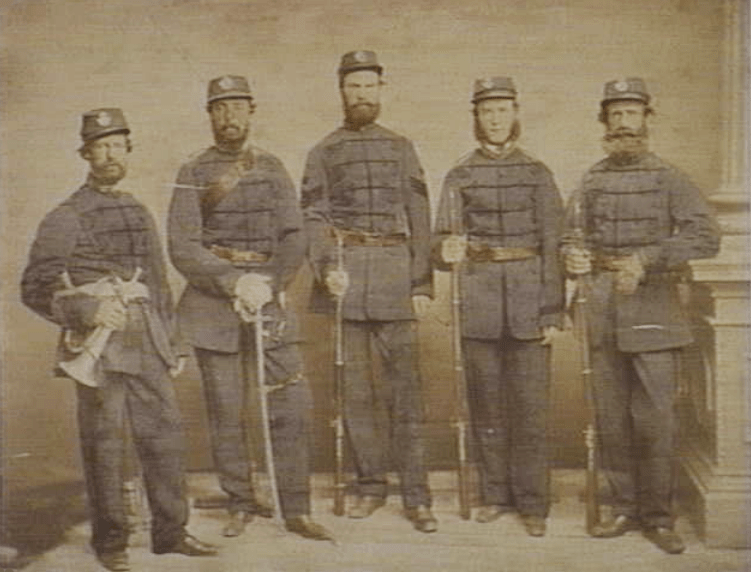
State Library Victoria, Image # b28224. Wlliamstown Company. Not all uniforms sported buttons; these have “frogs” as closures.
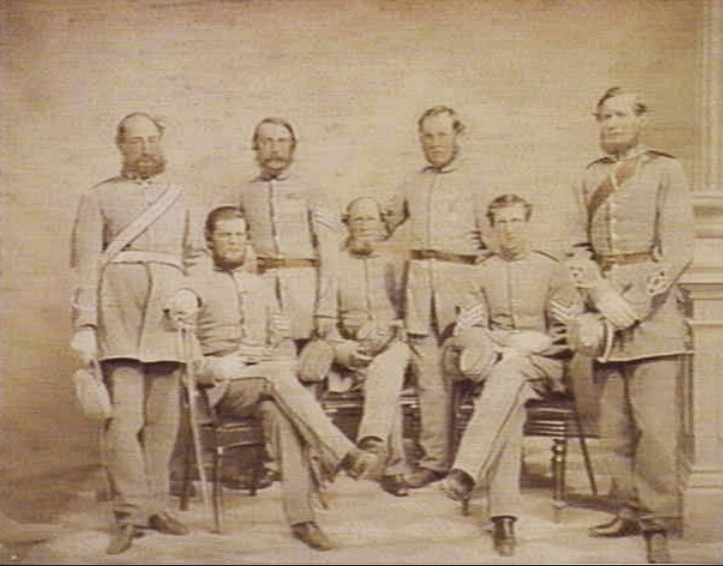
State Library Victoria image # b28821. Richmond Company c.1861
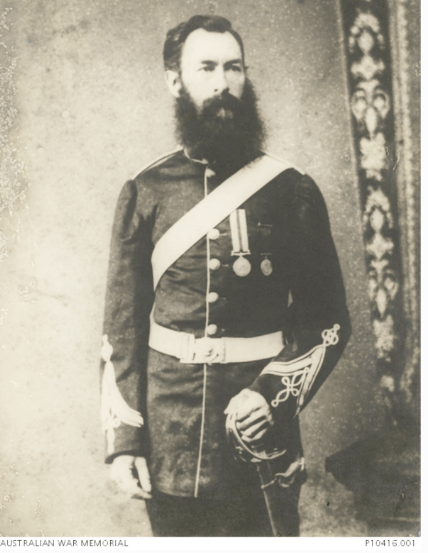
Australian War Memorial image P10416.001 Studio portrait of Lieutenant James Frisby of the Victorian Volunteer Rifles, c.1875.
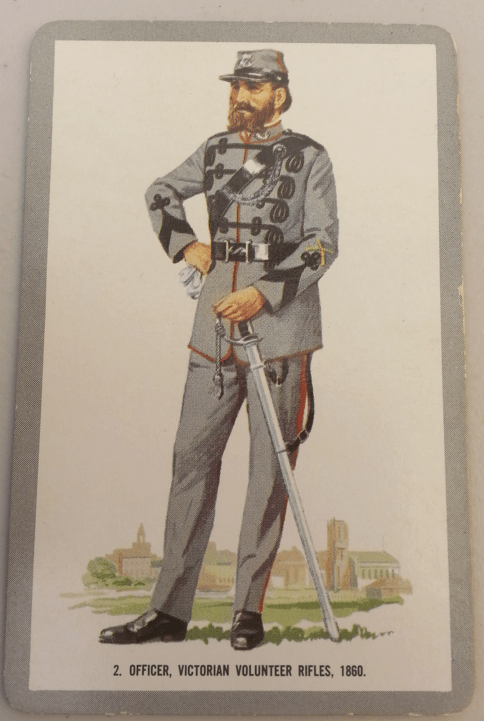
“Attached to this officer’s chest belt is a whistle on the end of a chain, while on his left sleeve he wears crossed muskets, a sportsmanship award. By the year 1860 this volunteer movement was well established and preparations were in hand for the fortification of Hobson’s Bay and Port Phillip Bay.”

In 1858 the Ballarat Volunteer Rifle regiment was formed, of four infantry and two cavalry divisions. This soldier, a Ranger of the Ballarat Volunteers of 1874, has a busby made of sealskin and wears a marksmanship award on his left sleeve. Volunteers were issued with Lancaster percussion muzzle-loading rifles.”
In 1902 Victoria had the second largest force, including the Victorian Mounted Rifles and the Victorian Infantry Brigade and volunteer units.
Victorian Volunteer Service: 1870-1880
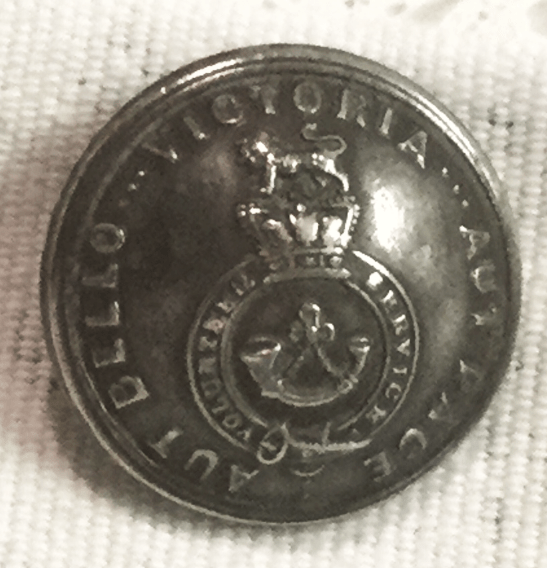
According to Cossum, 1870-1880, British make.
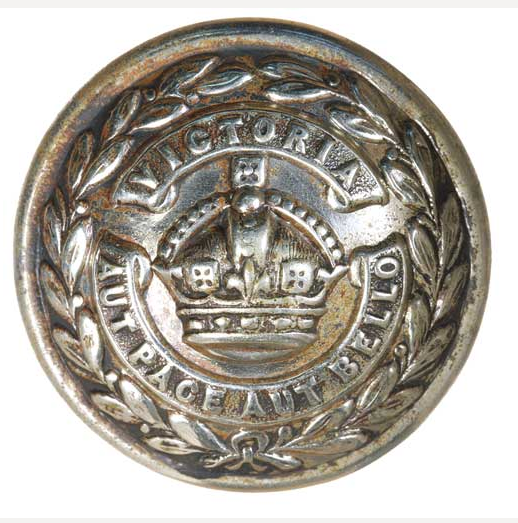
Thanks to Noble Numismatics. According to Cossum page 9 this is a Victorian Volunteer Service button c.1875. This crown, although similar to the Tudor crown adopted by Edward VII, depicts the ‘small diamond crown’ Victoria wore after 1870.
In 1870 British regiments were withdrawn from Australia, with small numbers of permanent and larger numbers of volunteer artillery and infantry forces taking over protection of the colony of Victoria. In 1884 the volunteers system was replaced with a partially paid (semi-volunteer) militia.
West Australia
http://www.austbuttonhistory.com/uncategorized/15th-november-2020/
Apart from a short lived attempt at a local volunteers force in 1829, it was not until 1861, upon the withdrawal of British troops, that volunteers group were formed in Fremantle, Perth and elsewhere.
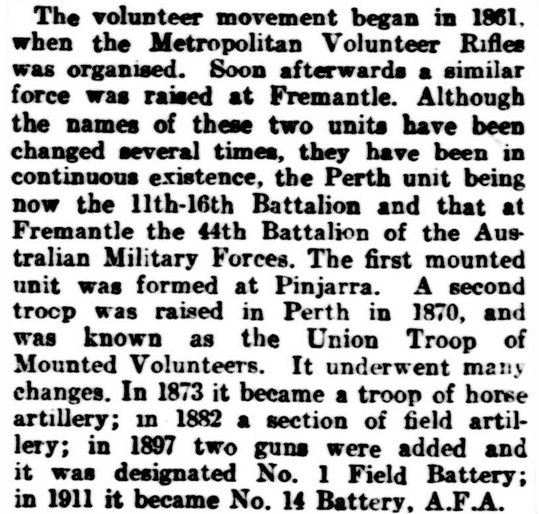
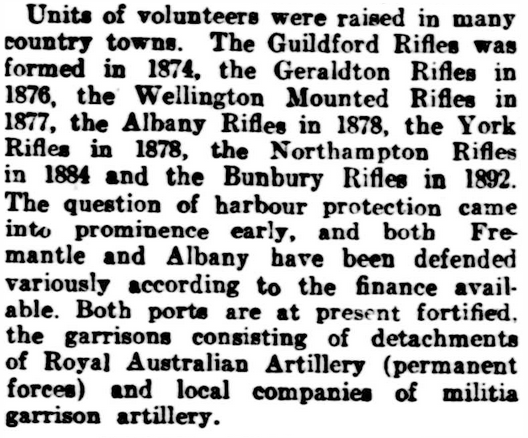
The West Australian (Perth), 5th January 1933 page 38.
Albany Rifle Volunteers: 1878- 1885
The button on Cossum page 28 has the initials ‘ARV’ in very ornate gothic script surmounted by the Queen Victoria crown.
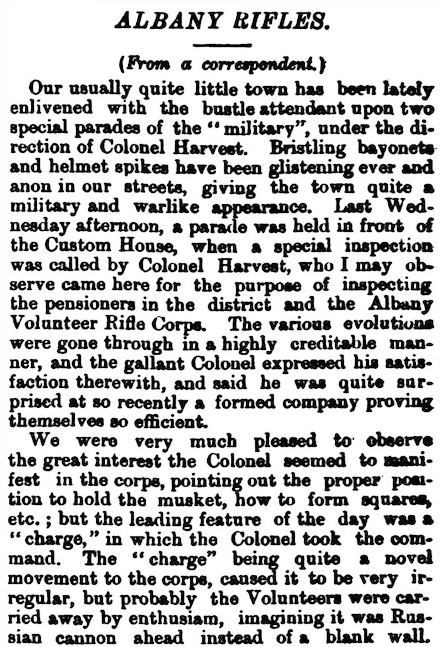
The Western Australian Times (Perth), 14th march 1879 page 2.
In 1884 only 28 out of a possible 54 men presented for inspection by an unimpressed Colonel Angelo. On March 31st 1884 they were disbanded.
Albany Defence Rifles: 1885-1888
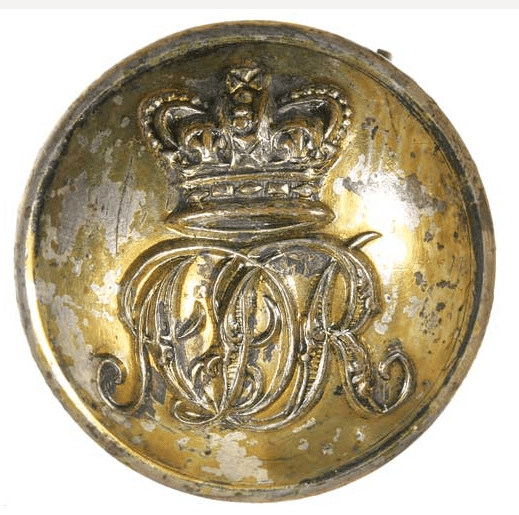
Thanks to Noble Numismatics: Albany Defence Rifles 1885-1888.
This unit was raised in 1885 very shortly (approx 5 weeks) after the Albany Rifle Volunteers was disbanded. It started with 73 men all ranks but quickly dwindled. In May 1888 it was disbanded, re-raised and renamed on the same day, which must have left everyone dizzy!
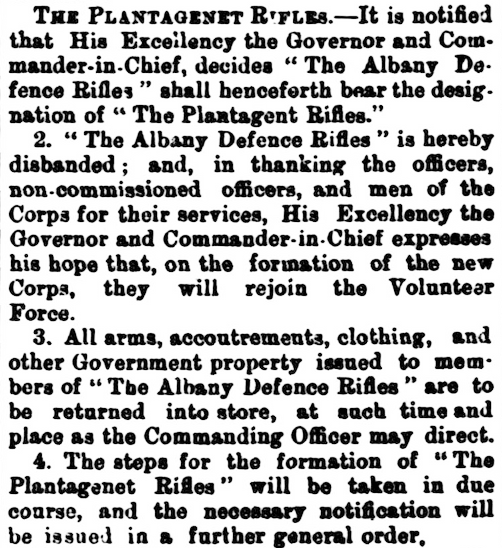
The West Australian (Perth), 4th May 1888 page 3.
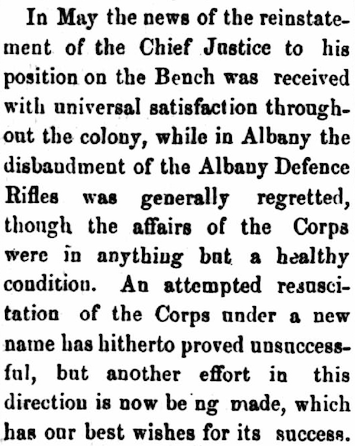
The Albany Mail and King George’s Sound Advertiser (WA), 29th December 1888 page 3.
The Plantagent Rifles continued, although it was a small force, until 1897.
Fremantle Volunteer Rifles: 1861-1870
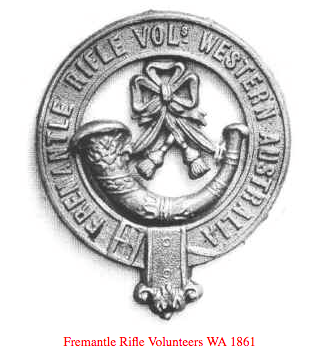
Badge. From diggerhistory.
In 1861 Fremantle formed one of the earliest corps in West Australia. Due to problems caused by the small local population and poor resourcing, they disbanded in 1870.
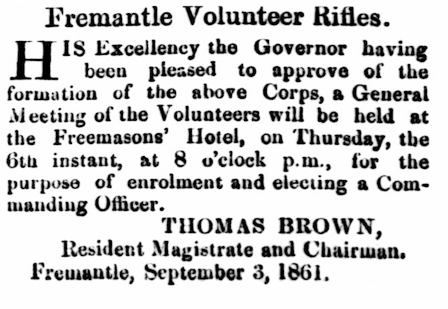
The Inquirer and Commercial News (Perth), 11th September 1861 page 2.
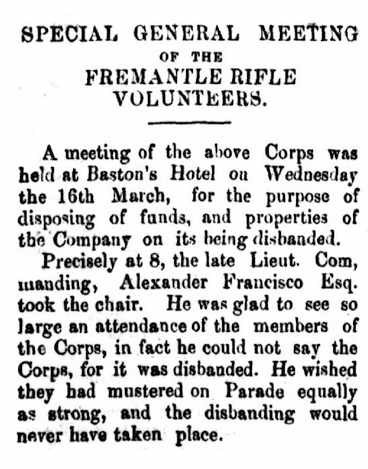
The Express (Fremantle), 18th March 1870 page 3.
Fremantle Rifle Volunteers: 1872-1893
The button as shown on page 28 of Cossum had the initials FRV in gothic script, surmounted by the QV crown and surrounded by a laurel wreath.
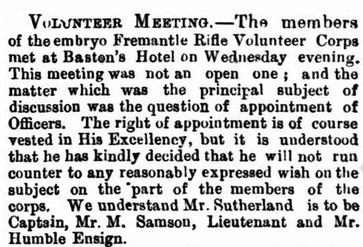
The Herald (Fremantle), 5th October 1872 page 2.
Rising international tensions during 1872 lead to a new Fremantle Corps being formed. In November 1893 the Perth, Fremantle and Guilford companies were amalgamated into the 1st Infantry Volunteer Regiment, but reportedly remained separate corps.
Guildford Rifle Volunteers: 1874-1894
The button labelled as from Guildford has only the Gothic script initials of ‘GRV’. Without knowing the providence of the button shown, it may possibly been from the Geralton Rifle Volunteers ( see post on 23rd January.)
Attempts to form a volunteer corps in Guildford started in 1861, but did not get off the ground until 1872. At its peak in 1890 it had 6 officers and 114 other ranks. In 1899, together with Perth and Fremantle, it became the 1st Infantry Regiment; Guildford being the named “E” company.
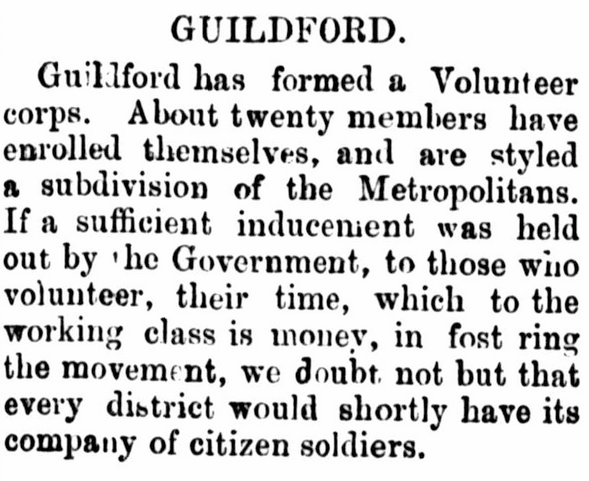
The Express (Perth), 25th July 1872 page 3. The corps was officially gazetted in 1874.

The West Australian (Perth) 21st May 1885 page 3.

From Swan Guildford Historical Society. Frederick John Read (and wife) in uniform, c.1875
Geraldton Volunteers: 1876- 1897
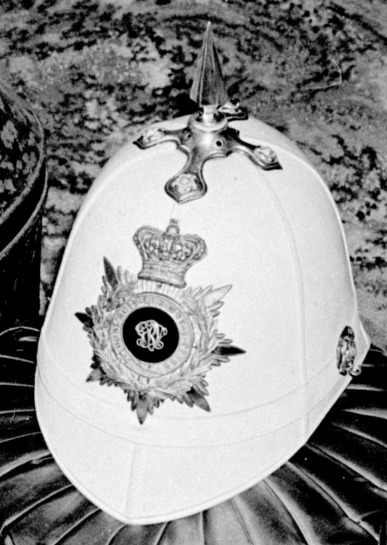
State Library WA image : Helmet belonging to Lieutenant F. Wittenoom of the Geraldton Rifle Volunteers.
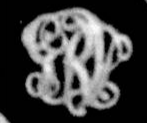
Close up of badge. Like the button in Cossum of the Guildford Rifle Volunteers, it shows only the lettering GRV. Could the button on Cossum page 27 be for the Geraldton uniform rather than the Guildford?
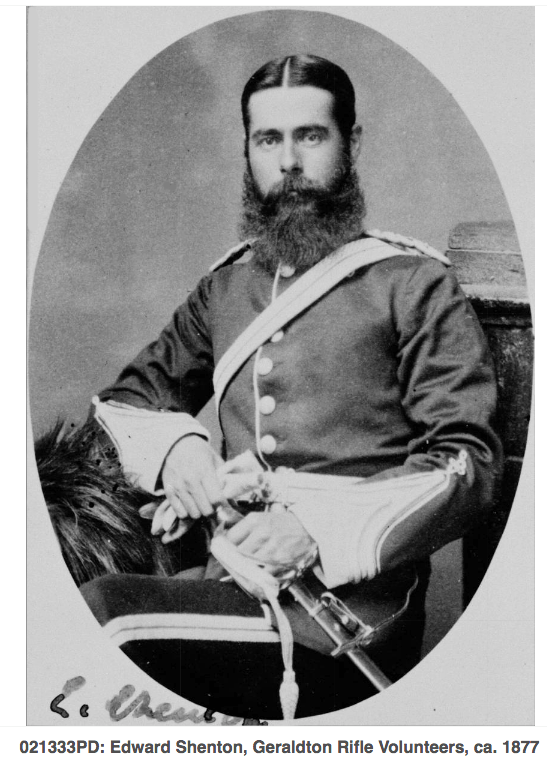
State Library WA
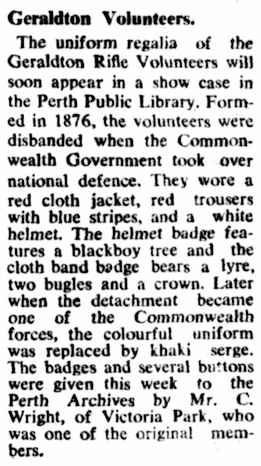
The West Australian (Perth), 20th October 1953 page 2. I am following up on this intriguing lead.
Northampton Rifle Volunteers: 1884-1899
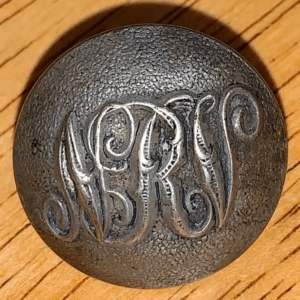
Backmark: Hobson & Son. Haymarket London.
Although there was interest from 1881, funds were not made available for this corps until 1884, formed as a detachment of the Geralton Corps although it had its own title. While it started with a strength of 40 men, when it was finally disbanded in 1899 due to ‘general inefficiency’ it was clear that many of those on the rolls were no longer attending and there were no new recruits coming forward.
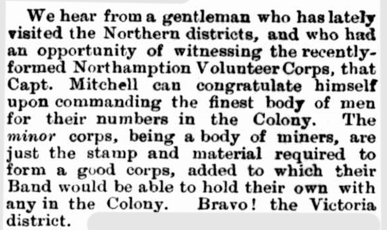
The Daily News (Perth), 27th June 1884 page 3.
I have not found an image of the Northampton Volunteers. Please let me know if you have any.
Perth Mounted Rifle Volunteers: 1894-97
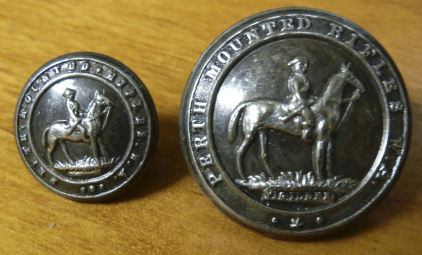
Thanks to Colin Hornshaw.
The button shown on Cossum page 29 is very handsome, showing a mounted soldier with the name ‘Perth Mounted Rifles’ in a band around the circumference. The number enlisted dropped quickly from 44 down to 24 in the first 2.5 years. It was disbanded in 1897.
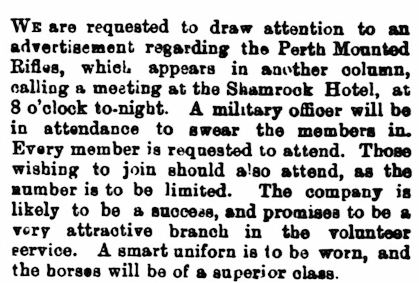
The West Australian (Perth), 11th May 1894 page 4.
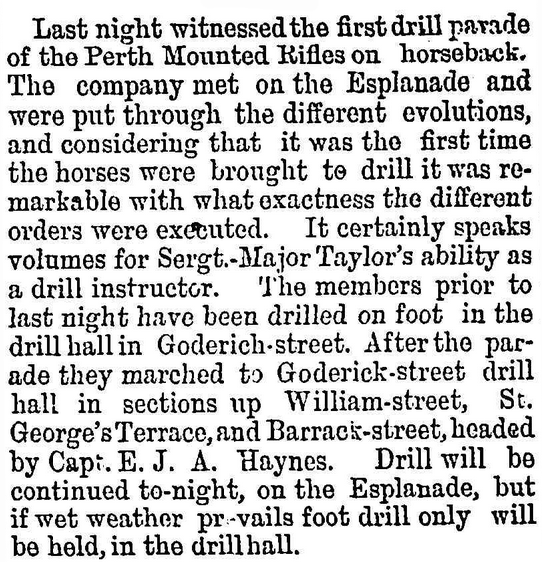
The Daily News(Perth), 18th May 1894 page 2.
http://www.austbuttonhistory.com/17th-april-2021/
Pinjarra Mounted Rifle Volunteers: 1862-1882
This uniform, a replica of the 6th Dragoons, sported cloth covered buttons. They started in 1862 with 18 men, and peaked at around 88 in 1873. In 1882, after dropping to a strength of only 26 the corps was disbanded.
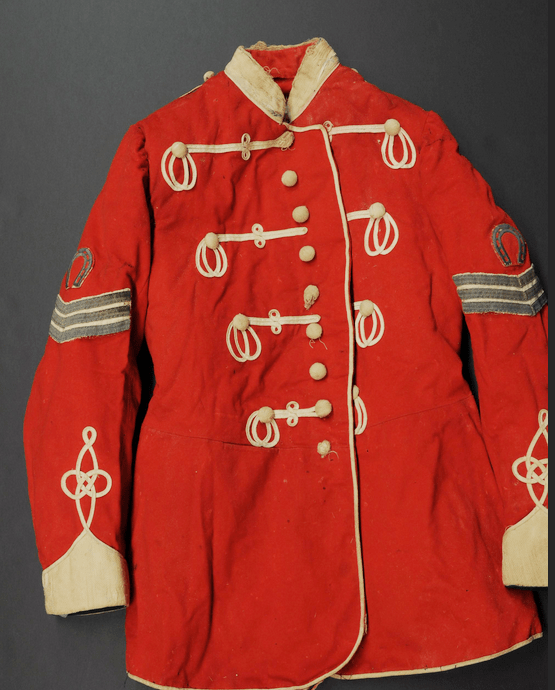
WA Museum Collection item H2004.49: Jacket of the Pinjarra Mounted Volunteers.
Western Australian Highlanders: 1903-?
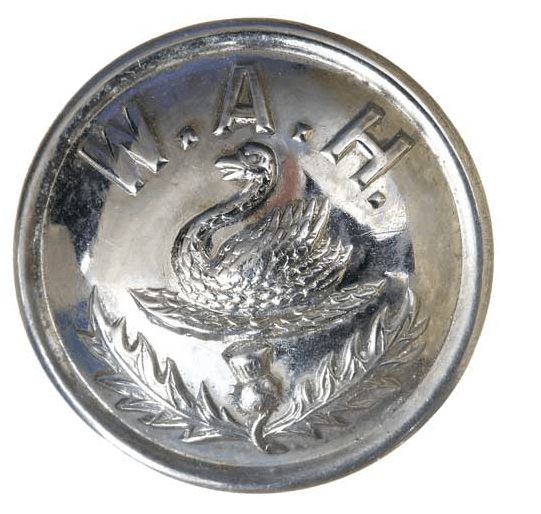
Thanks to Noble Numismatics c.1903.
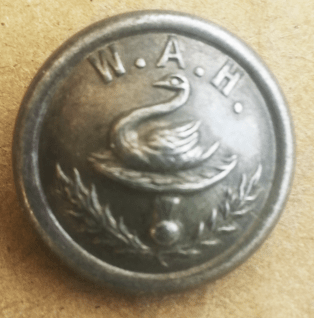
Stokes & Sons Melb.
This unit was raised in 1903. It is not clear when it was disbanded, but a new Cameron Highlanders of WA was raised in 1936.
Western Australian Troop of Volunteer Horse Artillery: 1870-1882
Originally called the Union troop of West Australia Mounted Volunteers and raised to form escorts for the Governor, it was renamed and repurposed in 1872. This uniform also sported cloth covered buttons. It became the Perth Volunteer Artillery in 1882.
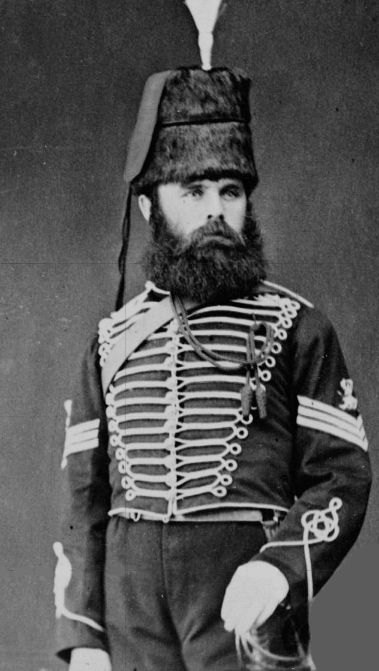
State Library WA image # 021330PD: Lieutenant Haynes c.1879.
York Rifle Volunteers: 1878-1899
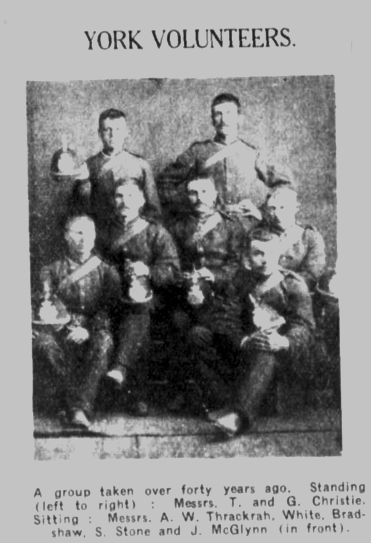
Western Mail (Perth), 24th October 1929 page 6.
The button features the Queen Victoria crown with the name ‘York Rifle Volunteers’ and a 5-point star in a border around the circumference. The uniform’s scarlet tunic had black facings with black initials upon the shoulder stays.
As with other volunteer groups, initial interest in 1861 did not result in a local corps until 1878 (due to lack of funds,personnel, etc). In 1878 the corps strength was 40 men, but soon dwindled, and was disbanded after only 8 years. it did not help that the men had not received suitable rifles for over 5 years, and had been threatened with disbanding (due to financial difficulties in the colony) in 1879.
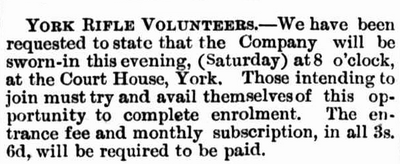
Eastern Districts Chronicle (York, WA), 23rd November 1878 page 2.
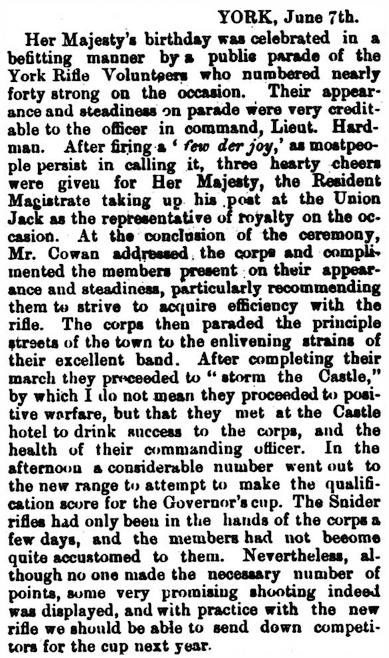
The West Australian (Perth), 10th June 1881 page 3.

Eastern Districts Chronicle (York, WA), 25th September 1886 page 3.
1st Infantry Volunteer Regiment: 1893-1901
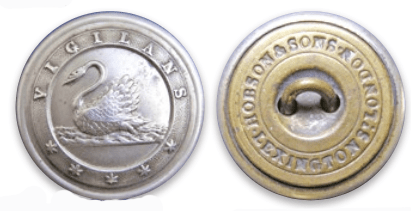
Tony Earl’s button.
This regiment was formed from the existing Perth, Guilford and Fremantle Rifle Volunteers in 1893 and existed until Federation.
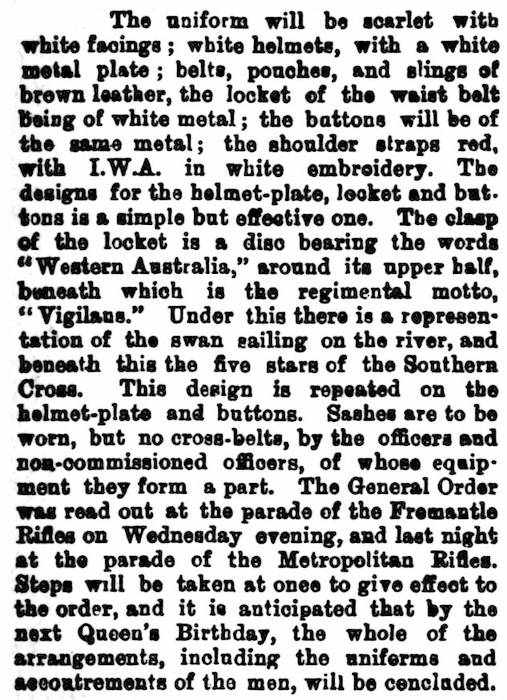
The West Australian (Perth), 17th November 1893 p 6.
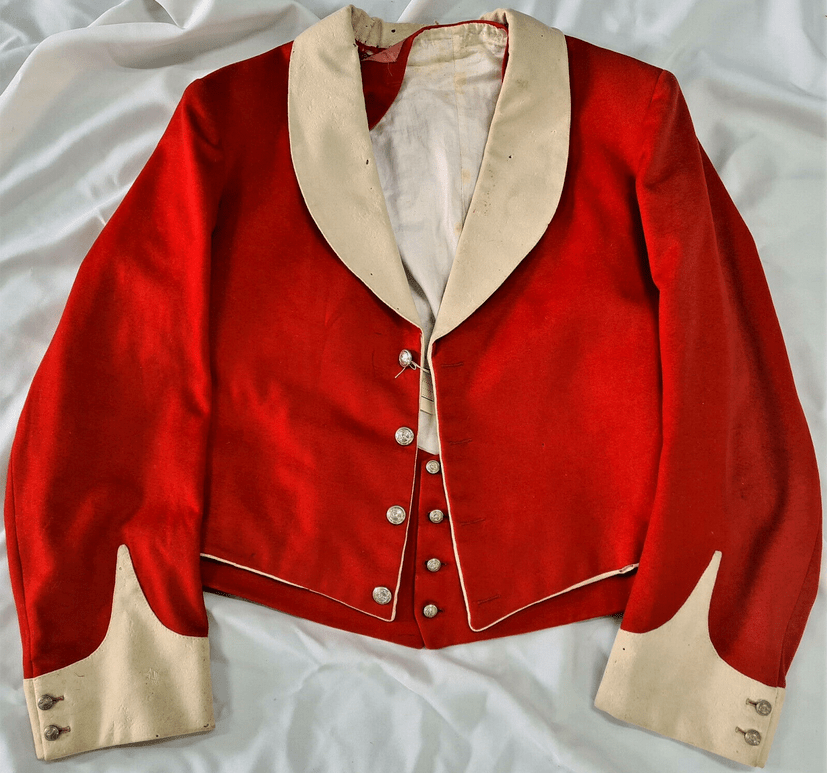
Officer’s mess dress jacket and vest. Image used with permission.
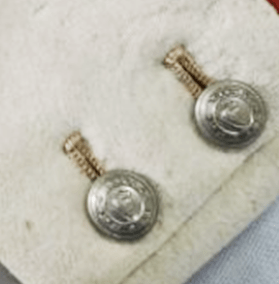
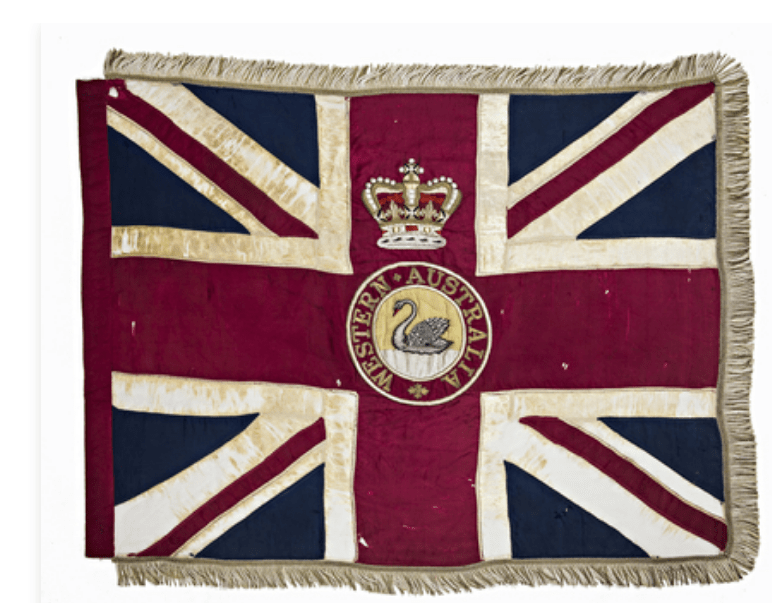
Australian Army Museum of WA: the Queen’s Colour of the 1st Infantry regiment (WA Volunteer Forces), presented 1896.
Boer War Contingents 1899-1902
I have included here the Royal Australian Artillery, which was established in 1899 and served in South Africa.
1st Australian Horse 1897-1903

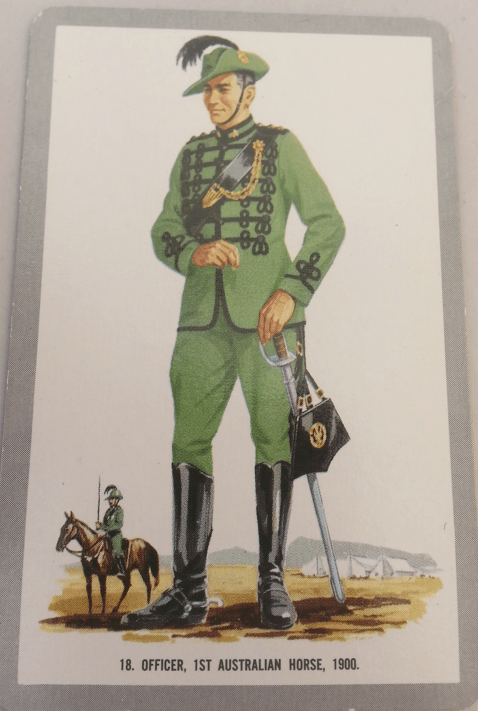
When the Boer War broke out, the 1st Australian Horse sent two contingents to South Africa, where they served as a cavalry squadron, the first group arriving in December 1899, and the second in February 1900. They left for Australia at the end of March 1901.
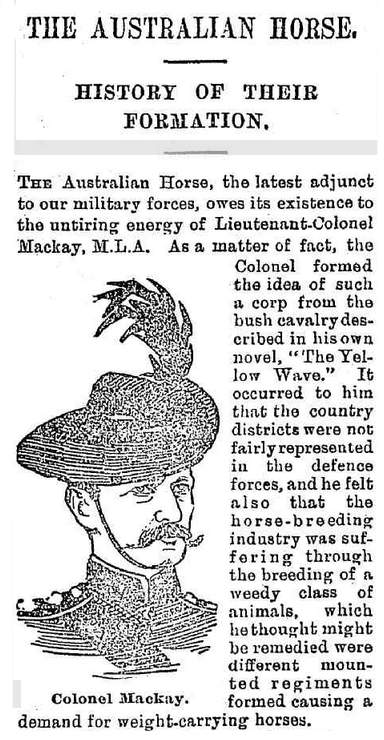
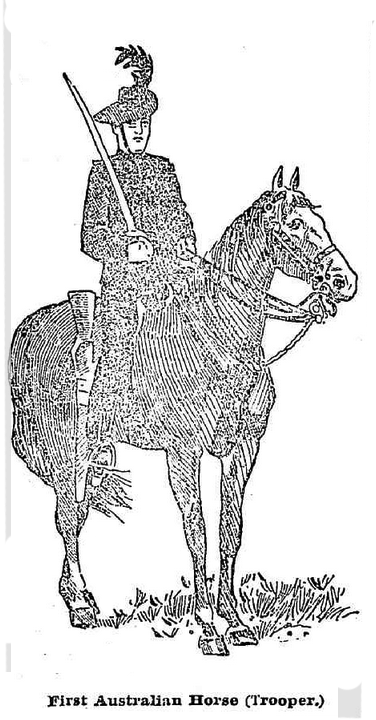

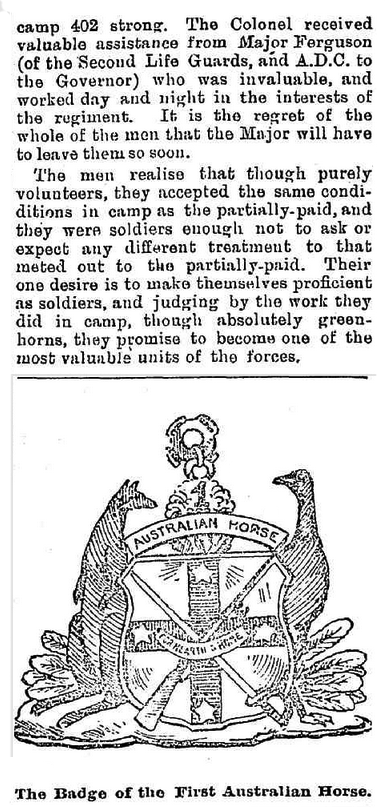
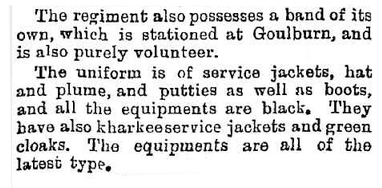
Sunday Times (Sydney), 17th April 1898, page 7.
Australian Nursing Service
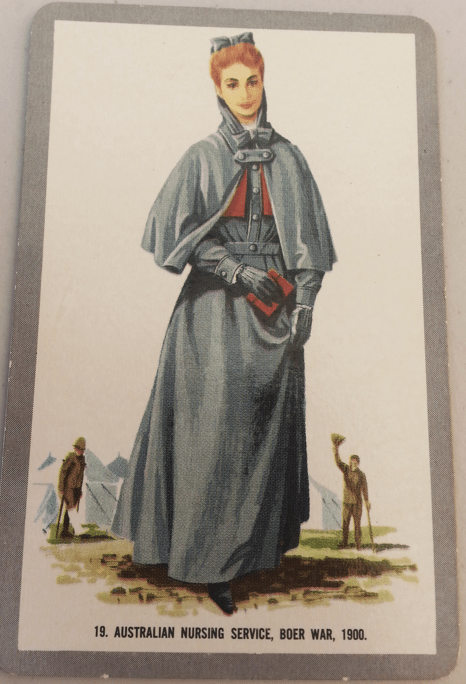
“Australian women made history when a detachment of nurses was organised and sent to South Africa to tend the wounded. Such a move was a victory in women’s fight for equality and recognition of their rights. Illustrated is one of these brave nurses who carried on the wonderful traditions of Florence Nightingale.”
As the only pre-existing reserve force, the NSW contingent of nurses were the first official group to leave for South Africa on 17th January 1900 as members of the NSW Medical Corps. As such, the button clearly seen on their belts, cuffs and shirt fronts would have been that of the NSW Military Forces. The costumes were of dark gray serge with a 3/4 length red cape, a muslin cap and a bonnet for outdoor wear.
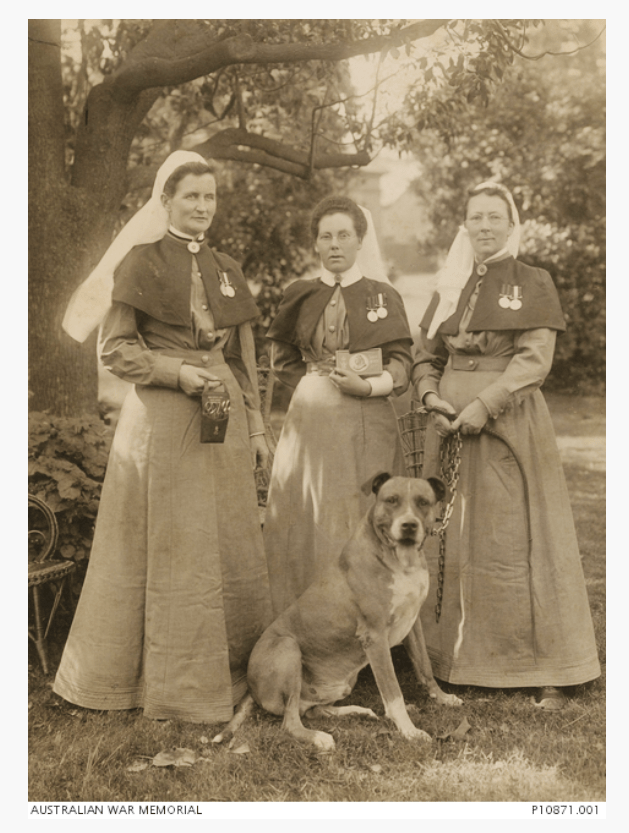
Australian War memorial. 1902 portrait of three nurses of the NSW Army Medical Corps with souvenirs of their time in South Africa.
Royal Australian Artillery
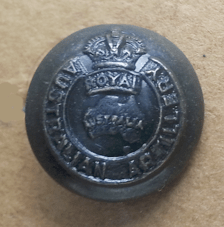
R.A.A. Stokes Melb
In 1898 the government of New South Wales sent a request to Downing Street that their artillery be named the ‘Royal Australian Artillery’, which seemed a bit cheeky (even to Downing Street) so they in turn suggested the combined colonial artillery units of Queensland, New South Wales and Victoria be thus named, as there existed a permanent artillery only in those colonies at that time. The Victorian Government thought this step should wait until Federation. The Premier of NSW then suggested that the permanent artillery forces of each colony could be be designated a battery of the RAA, so if such forces in the other colonies be raised they would then be included. The Victorian government accepted this idea, and the Queen gave her assent on 14th July, 1899.

Geelong Advertiser (Vic), 21st August 1899 page 1.Each colonial artillery then became, for example , the Queensland Regiment of the RAA.
Only months later, the whole of the Victorian regiment of the RAA would be volunteering for service in the Transvaal. They were joined by the machine-gun section of the Queensland Regiment and 17 men and officers from the NSW regiment. A further field artillery unit left with the second division later that year.
The photos below are from Royal Australian Australian Town and Country Journal (Sydney), 28th October 1899 page 25.
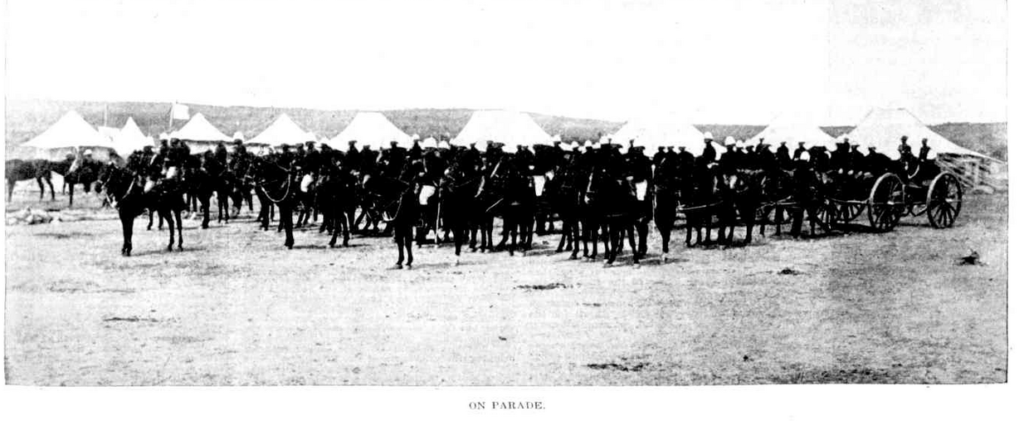
“Royal Australian Artillery-The New South Wales “A” Battery, which was Offered to the imperial Government, and Refused.”
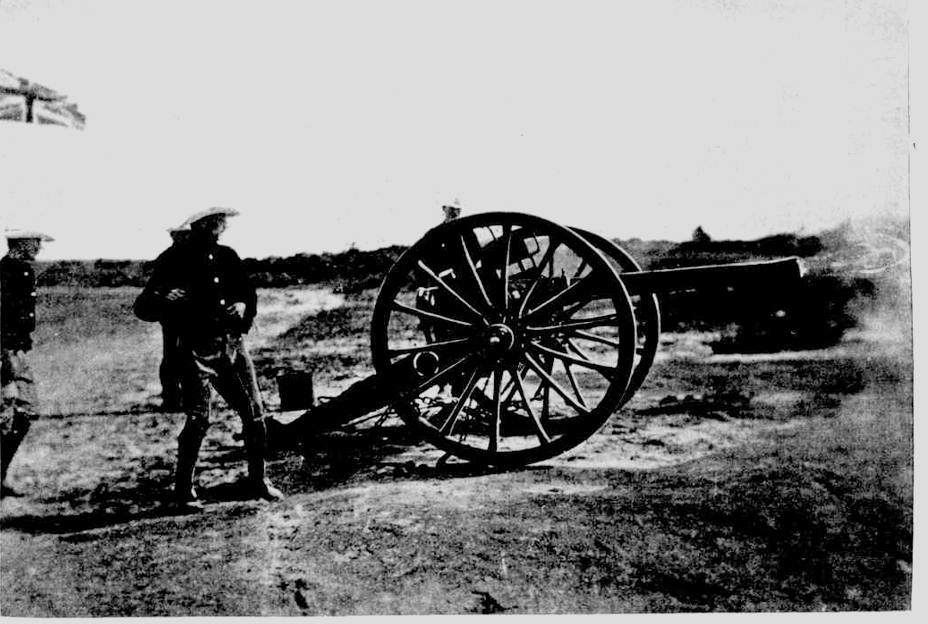
“A Gun in Action.”
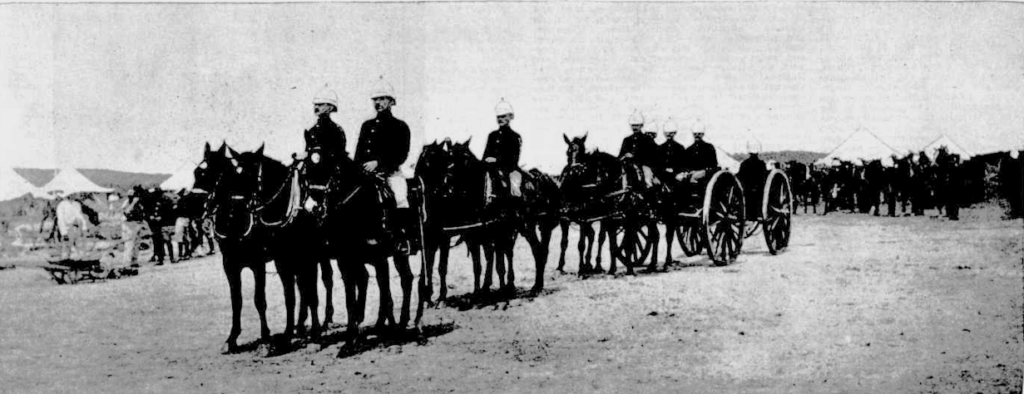
“No. 1 Gun and Men.”
South Australian Contingent
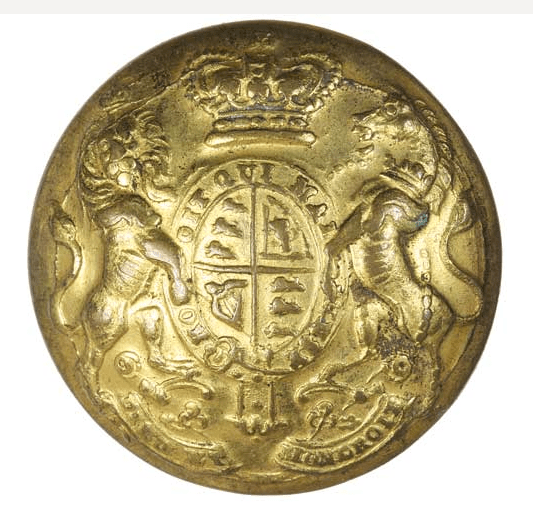
SA contingents to South Africa 1899-1902. Cossum page 20. Backmarked Shierlaw & Co, Adelaide.
From November 1899 until June 1902, nine contingents comprising 1531 men from South Australia (not including some who were already in, or made their own way to South Africa) and around 1510 horses.
The “General Service” design button was used by troops from Queensland, Victoria and South Australia serving in the Boer War.
Tamanian Contingent
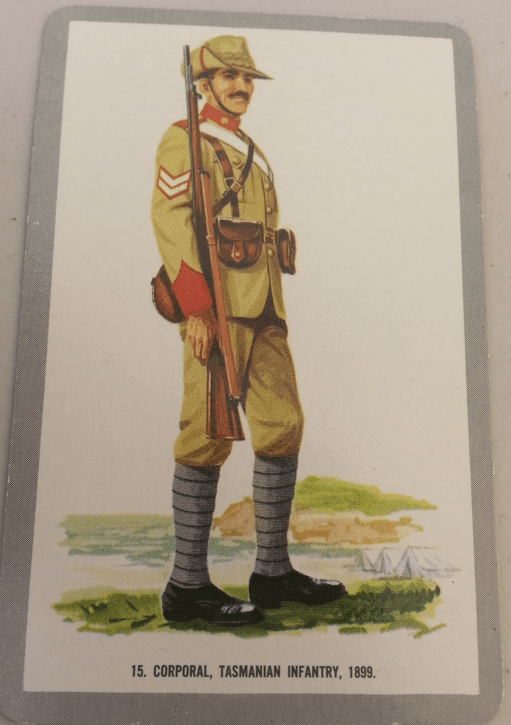
“This soldier is fully equipped for departure to South Africa, to fight alongside members of other Australian Colonial Forces in the Boer War. It is interesting to note his slouch hat turned up on the right side, instead of today’s conventional left side. Khaki had become the accepted service colour at that time.”
From November 1899 until May 1902 around 800 Tasmanian men in 5 Tasmanian contigents and a further 3 Commonwealth contingents departed for South Africa.
Western Australian Infantry
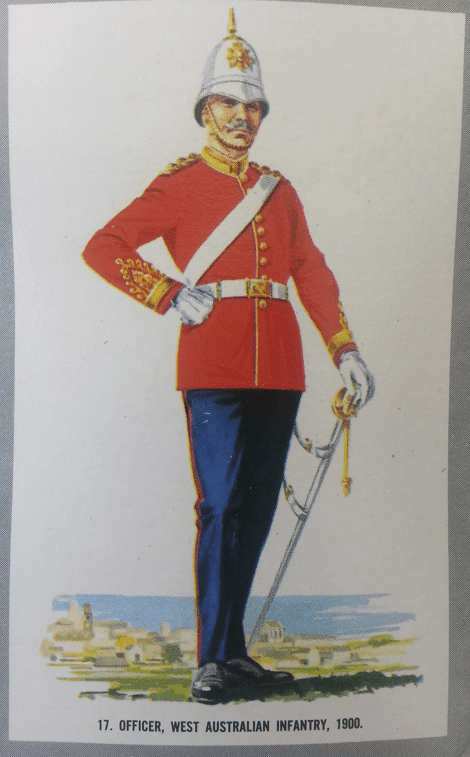
From the back of the card: “When British regular troops were withdrawn from Western Australia in 1863 there were only three volunteer units in existence. But from that time the volunteer movement was to grow steadily. In 1899 Western Australia sent troops to South Africa to fight in the Boer War. The officer illustrated is in full dress uniform.’
Around 1161 West Australian men served in 6 WA contingents and a further 3 Commonwealth Contingents.



